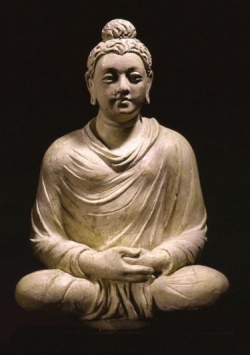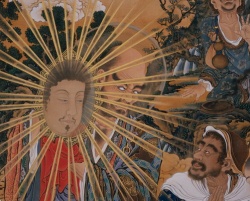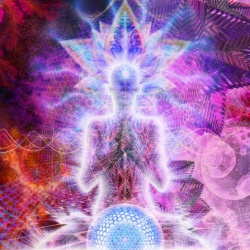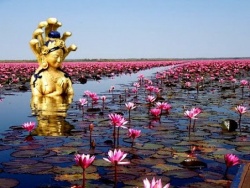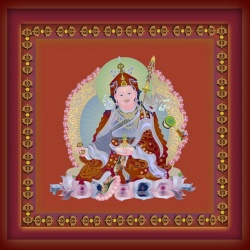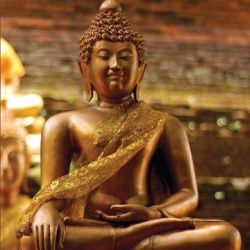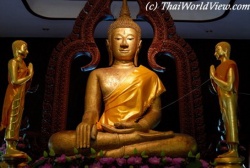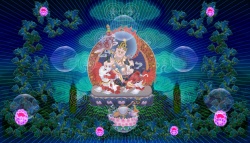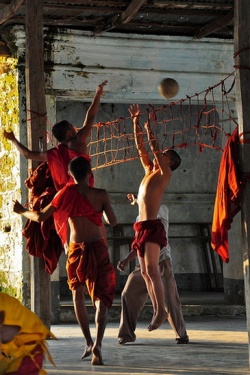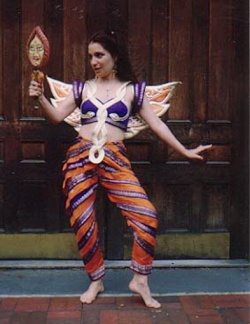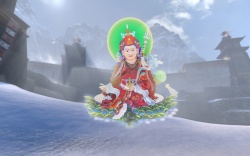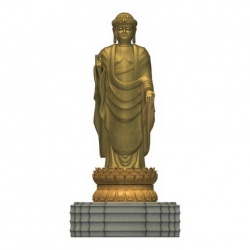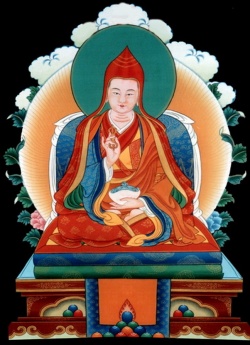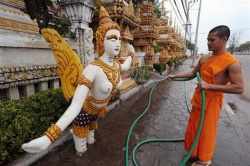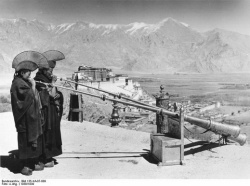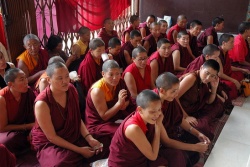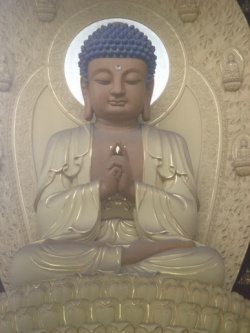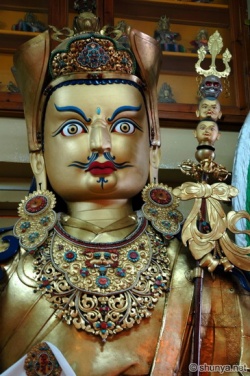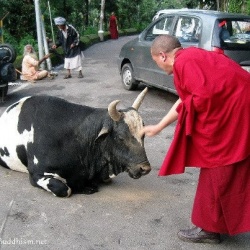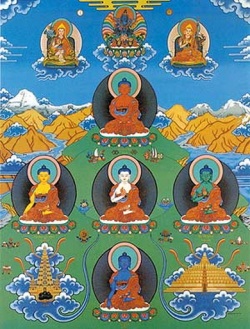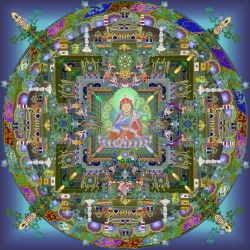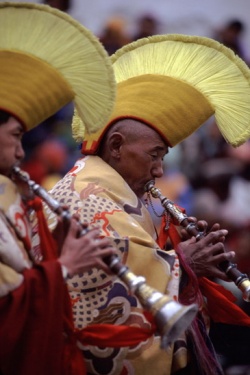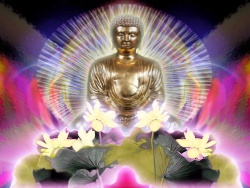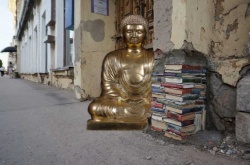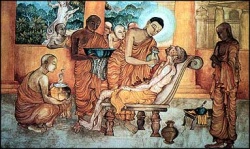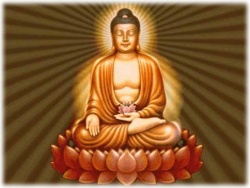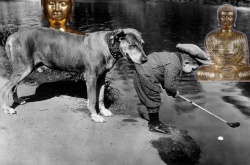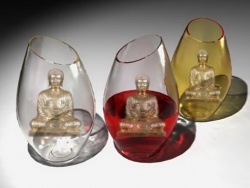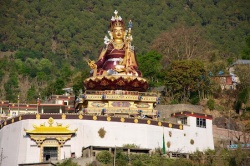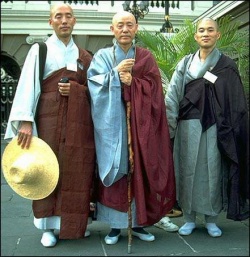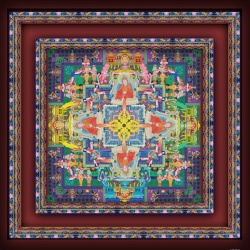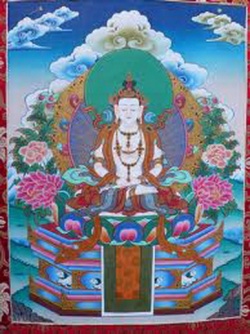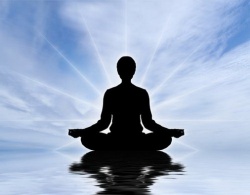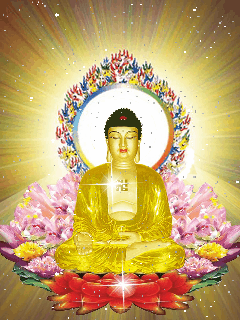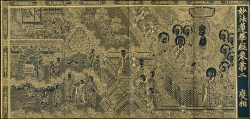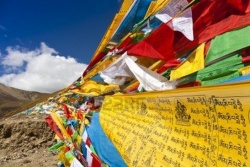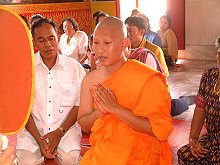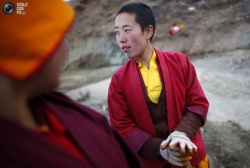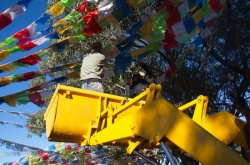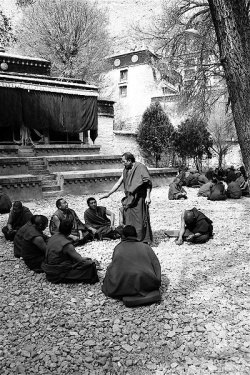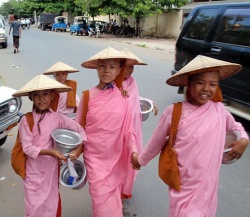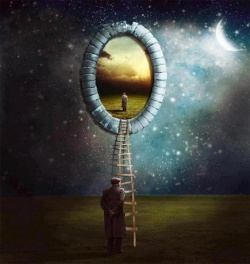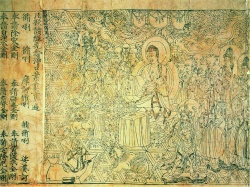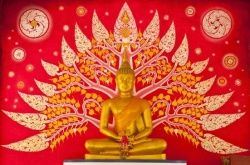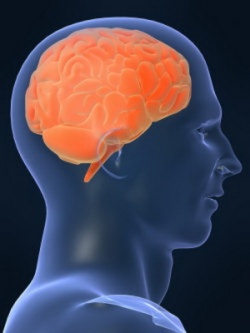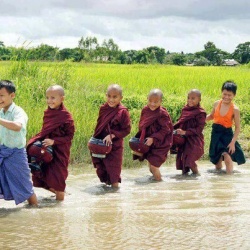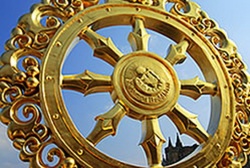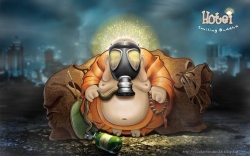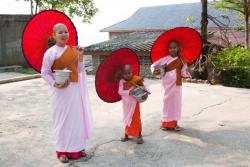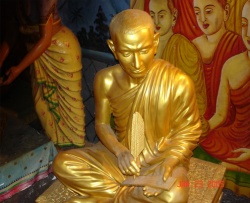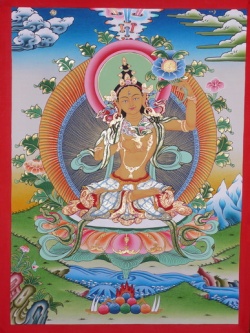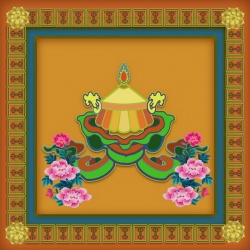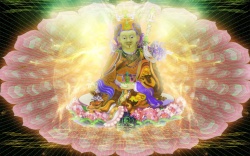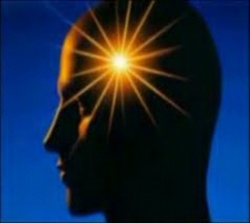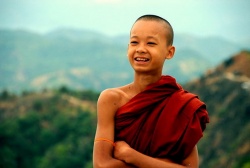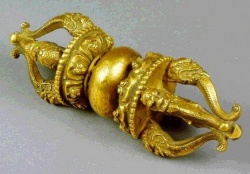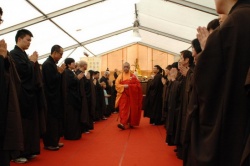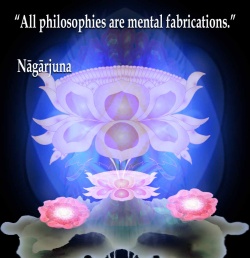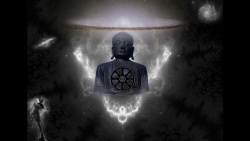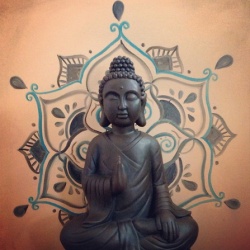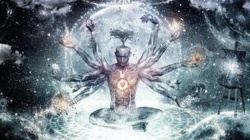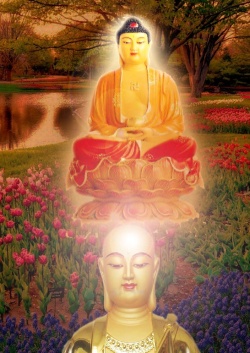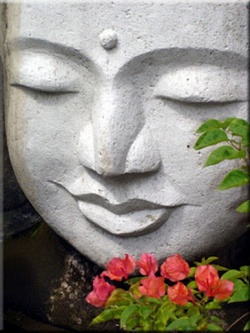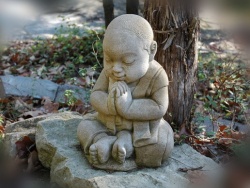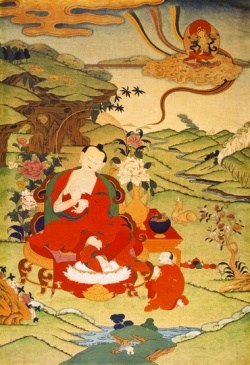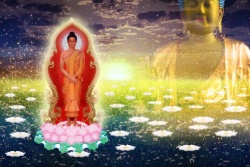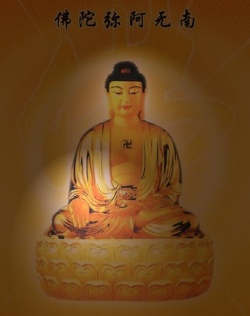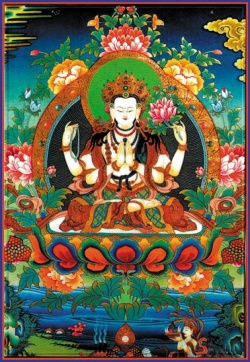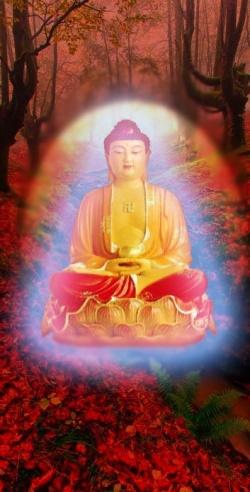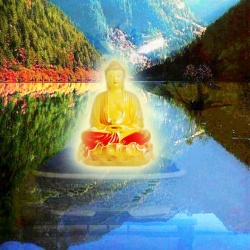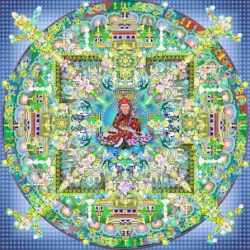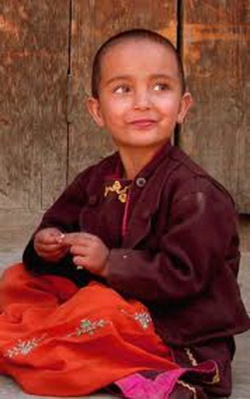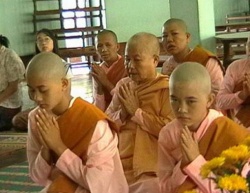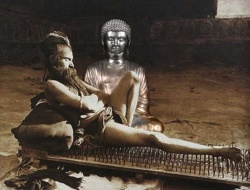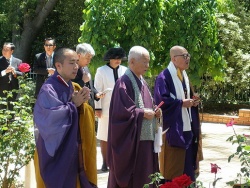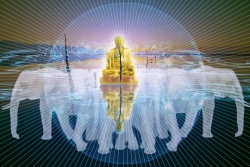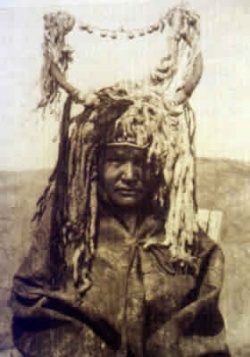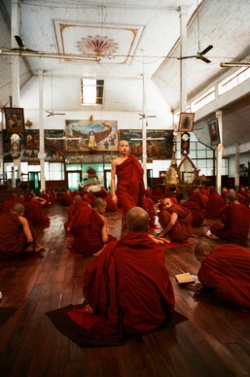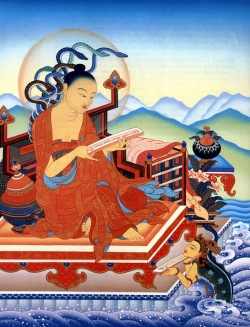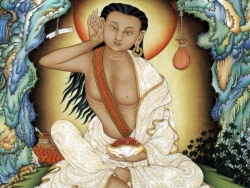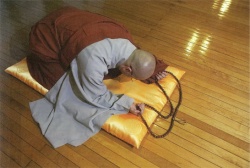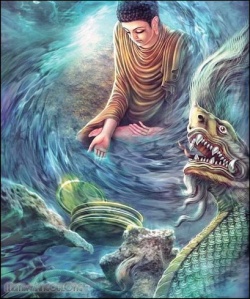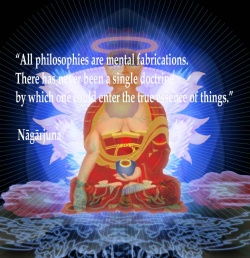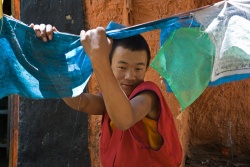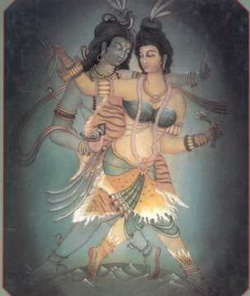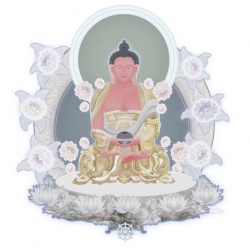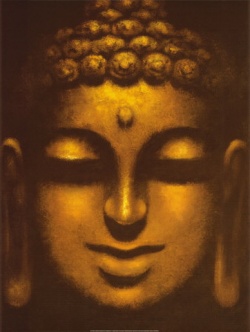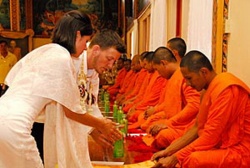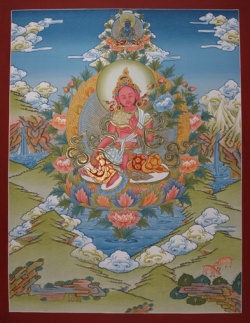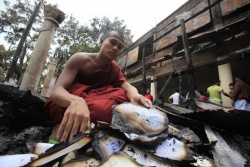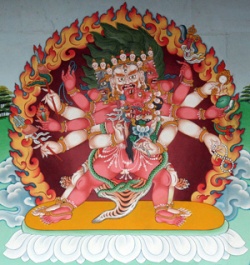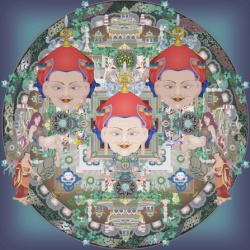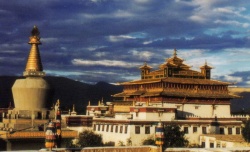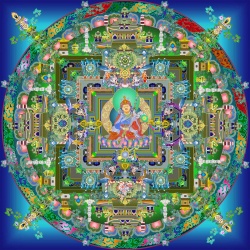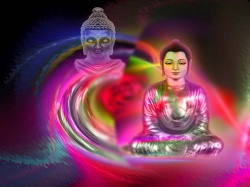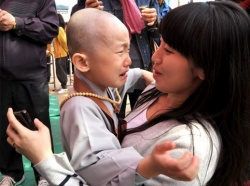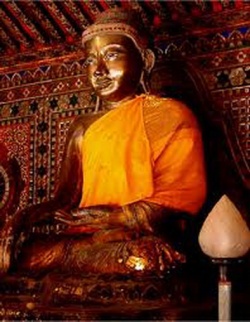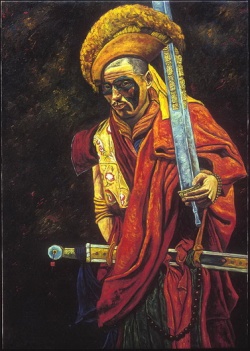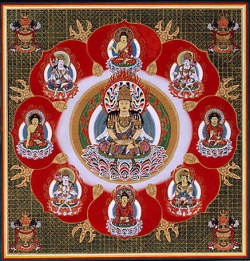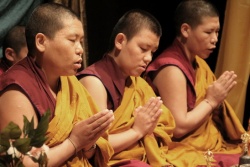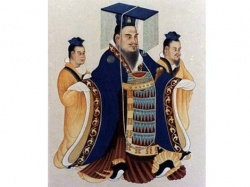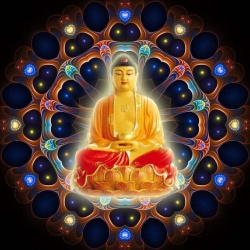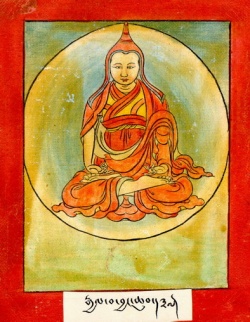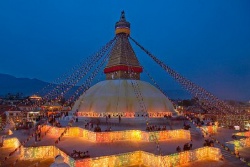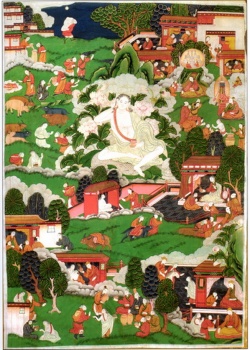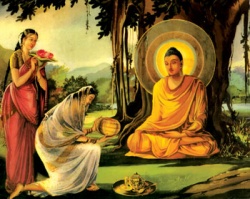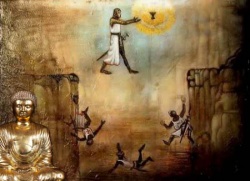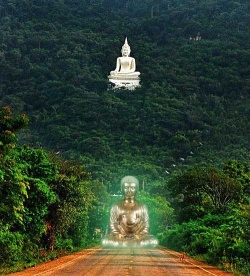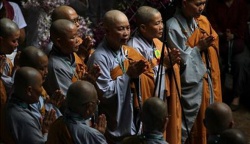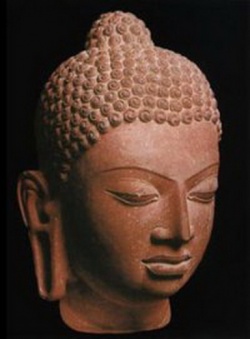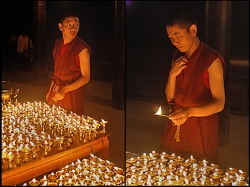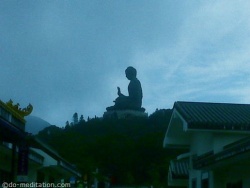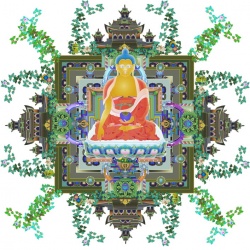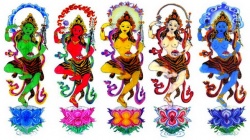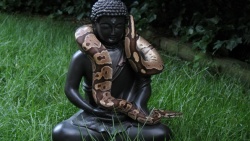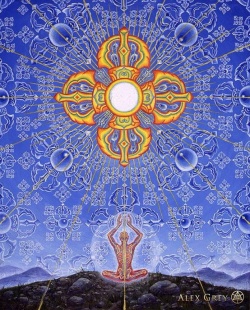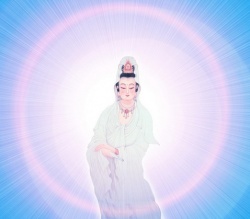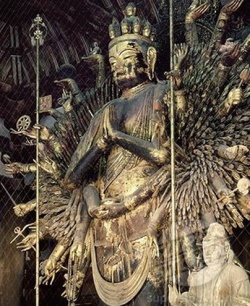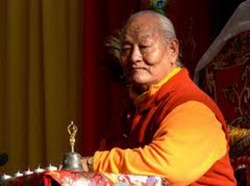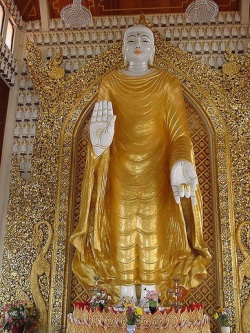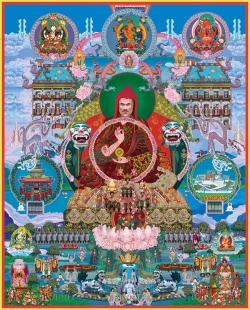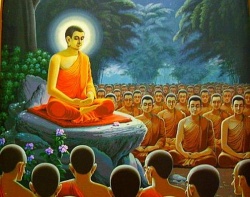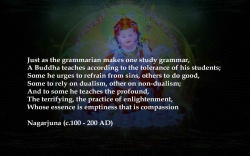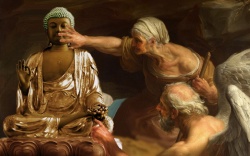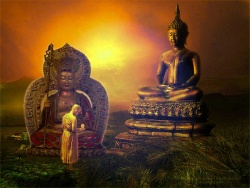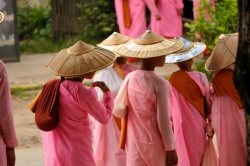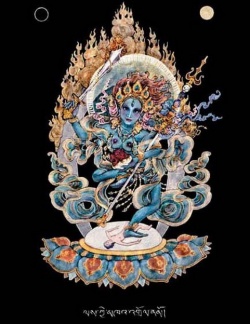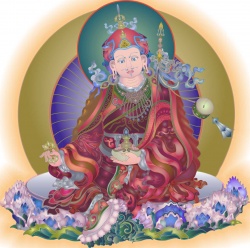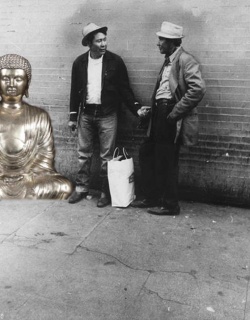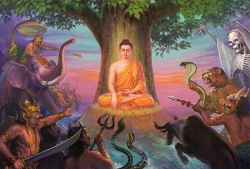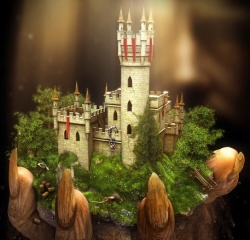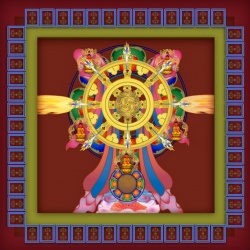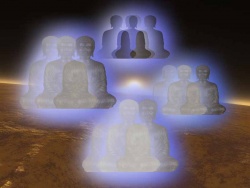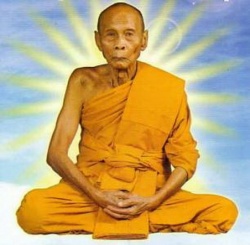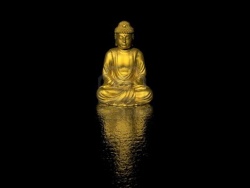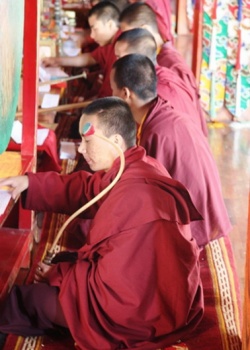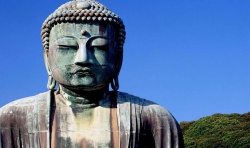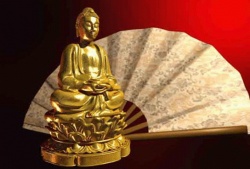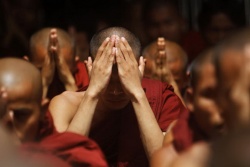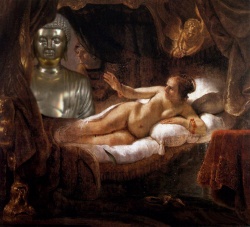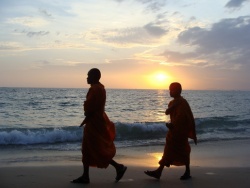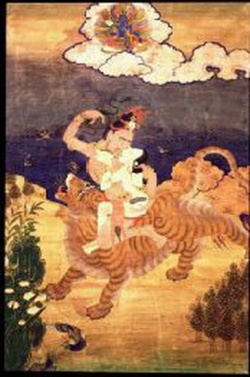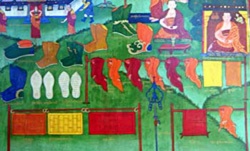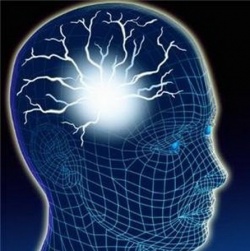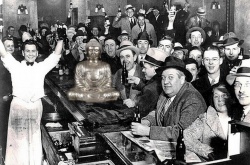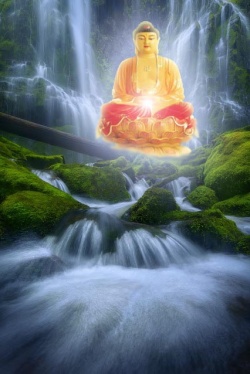Jewel Ornament of Liberation - Gampopa
The Jewel Ornament Of Liberation
The Wish-Fulfilling Gem Of The Noble Teachings By Gampopa
HOMAGE
I prostrate to the noble Manjushri in youthful form.
I pay homage to the Victorious Ones, their followers, the holy Dharma, and to the lamas who are their foundation.
This noble teaching, which is like the wish-fulfilling jewel,
Will be written for the benefit of myself and others by depending on the kindness of Mila and Lord Atisha.
==INTRODUCTION==
In general, all phenomena are included in the two categories of samsara and nirvana. That which is called samsara is empty by nature, a confused projection. Its defining characteristic is that it manifests as suffering. That which is called nirvana is also empty by nature, but all the confused projections are exhausted and dissipated. Its defining characteristic is freedom from all suffering.
Who is it that is confused in samsara? All sentient beings of the three realms are confused. On what basis does confusion arise? Confusion arises on the basis of emptiness. What causes confusion to arise? The cause of confusion is great ignorance. How does this confusion operate? It operates through the activities and experiences of the six realms of migrators. What exemplifies this confusion? The confusion is like sleep and dream.1 When did this confusion originate? This confusion originated in beginningless samsara.
What is the error of this confusion? All experiences are suffering.
When can this confusion be transformed into primordial wisdom? When one attains unsurpassable enlightenment.
If you think that perhaps this confusion will disappear by itself, then understand that samsara is known to be endless. Understand that samsara is confusion. Understand how much suffering is there. Understand how long it endures. Understand that there is no self-liberation.
Therefore, from today onward, you should make as much effort as possible to achieve unsurpassable enlightenment. What manner of things are needed in order to make this kind of effort? The summary:
The primary cause, working basis, contributory cause, Method, result, and activities—
All discriminating beings should understand that
These six comprise the general explanation of unsurpassable enlightenment.
The primary cause of unsurpassable enlightenment, the person who is the working basis for the achievement of enlightenment, the contributory causes that encourage one in practice, the method of practice, the result that is accomplished, and the activities ensuing from accomplishment—these are the topics one should understand. To explain them in order:
The primary cause is the Essence of the Well-gone One.2
As a working basis, the precious human life is excellent. The contributory cause is the spiritual master.
The method is the spiritual master’s instruction. The result is the body of perfect Buddhahood.
The activities are benefitting sentient beings without conceptual thought.
These six topics form the body of this text. Now, the limbs will be explained in detail.
CHAPTER 1
==BUDDHA-NATURE==
==PART 1: THE PRIMARY CAUSE==
==The primary cause is the Essence of the Well-gone One.==
We need to attain unsurpassable enlightenment by freeing ourselves from the confused state of samsara. But, is it possible for inferior persons like ourselves to achieve enlightenment even if we make the effort? Why wouldn’t we attain enlightenment if we made the effort! All sentient beings, including ourselves, already possess the primary cause for enlightenment, the Essence of the
Well-gone One. As is stated in the King of Meditative Absorption Sutra:
The Essence of the Well-gone One pervades all migrators.
The Small Parinirvana Sutra says:
All sentient beings have the Essence of the Thus-gone One.1
Also, the Sutra of the Great Parinirvana says: For example, as butter permeates milk, likewise the Essence of the
Thus-gone One pervades all sentient beings.
And in the Ornament of Mahayana Sutra:
Even though suchness is not different for any being,
One is called “Thus-gone One” when it is fully purified.
Therefore, all beings are of its essence.
By what reasoning can it be shown that sentient beings have Buddhanature?2 Because all sentient beings are pervaded by the emptiness of Dharmakaya, because there are no differentiations in the nature of suchness, and because all beings have a “family”.
For these three reasons, all sentient beings are of the Buddha-nature. The Unsurpassed Tantra says:
Because the perfect form of the Buddha radiates, Because there are no distinctions within suchness, and Because all are in a “family,”
All sentient beings are always of the Essence of Enlightenment
To explain the first reason “all sentient beings are pervaded by the emptiness of Dharmakaya” means that the ultimate Buddhahood is Dharmakaya, Dharmakaya is all-pervading emptiness, and emptiness pervades all sentient beings. Therefore, all sentient beings are of the Buddha-nature.
Saymg “there are no differentiations in the nature of suchness” means that the suchness of the Buddha is identical to the suchness of sentient beings. None is better or worse, none is bigger or smaller, none is higher or lower. So, because of that, all sentient beings are of the Buddha-nature.
“All beings have a ‘family’” means that all sentient beings can be categorized into the five families of the
Buddha. What are they? The summary:
The disconnected family, the indefinite family,
The Hearer family, the Solitary Realizer family, and
The Mahayana family—
These are the five families of the Buddha
==I. DISCONNECTED FAMILY==
First, what does “disconnected family” mean? It refers to those who have six traits such as no concern for
what others think, no modesty, no compassion, and so forth. The great Acharya Asanga said it this way:
Even if they see the suffering and faults of the vicious samsara, they are not moved
Even when they hear of all the great qualities of the Buddha, they have no faith
They have no modesty, no thought for what others may think, no compassion at all, and Do not experience even a single regret when they repeatedly commit nonvirtuous actions Those who maintain these six attributes have no chance to work toward enlightenment
==This is also explained in the Ornament of Mahayana Sutra==
There are some who only commit nonvirtuous actions There are some who consistently destroy positive qualities There are some who lack the virtue which leads to liberation
So, those who have no virtue do not possess the cause of enlightenment
Generally, it is said that those who have these attributes constitute the disconnected family. They will wander in samsara for a long time, but this does not mean that they will never achieve enlightenment. If they made the effort, eventually even they would achieve enlightenment. Buddha said in the White Lotus of Great Compassion Sutra:
Ananda, if a sentient being who otherwise had no chance to achieve enlightenment would visualize the Buddha
in space and offer a flower up to that image, the result would bring that being to nirvana. Eventually that person
would achieve enlightenment, so, for him, nirvana is attainable.
==II. INDEFINITE FAMILY==
The nature of the indefinite family depends on contributory conditions. If they attend a Hearer spiritual master, associate with Hearer friends, or study the different Hearer texts, then those persons will awaken in the Hearer family. They will study and follow that path and become part of the Hearer family. Likewise, if those persons meet with a Solitary Realizer or a Mahayana master, then respectively they will become part of the Solitary Realizer or Mahayana family.
==III. HEARER FAMILY==
The family of Hearers consists of those who fear samsara and yearn to achieve nirvana, but who have little compassion. It has been said:
One who is afraid upon seeing the suffering of samsara
And yearns to achieve nirvana
But has little interest in benefitting sentient beings—
These three are the marks of the Hearer family
==IV. SOLITARY REALIZER FAMILY==
The Solitary Realizer family includes those who possess the above three attributes and in addition are
arrogant, keep their masters’ identities secret, and prefer to stay in solitary places. It has been said:
Fear at the thought of samsara, yearning for nirvana, Little compassion, arrogance,
Secretive about their teachers, and enjoying solitude—
A wise one should understand that these are the marks of the Solitary Realizer family
So these two families, the Hearers and the Solitary Realizers, engage in their respective vehicles and even though they achieve the results of their practices, these results are not the final nirvana. How do they abide when they achieve their fruits? They maintain unafflicted states of meditative concentration,3 but those states are based on the psychic imprint of ignorance. Since their meditative concentrations are unafflicted, they believe that they have achieved nirvana and remain that way.
If their states are not the final nirvana, then one might argue that the Buddha should not have taught these two paths. Is there a reason the Buddha should teach such paths? Yes. For example, suppose great merchants from this Jambudvipa are traveling the ocean searching for jewels. After man months at sea, in some desolate place, they become completely tired and exhausted and think, “There is no way to get
the jewels now”. When they feel discouraged and prepare to turn back, the merchant captain manifests a huge island through his miracle power and lets all his followers rest there. After a few days, when they are fully rested and
relaxed, the captain says, “We have not achieved our goal. Now we should go farther to get our jewels.”
Similarly, sentient beings without courage are frightened when they hear about the Buddha’s wisdom. They believe attaining Buddhahood is a great hardship, and think, “I have no ability to do this.” There are other people who are not interested in entering the path, or who enter the path but turn back. To counter these problems, Buddha presented these two paths, and allows them to rest in these states.
As said in the White Lotus of Sublime Dharma Sutra:
Likewise, all the Hearers
Think that they achieved nirvana,
But they have not achieved the final nirvana
Revealed by the Buddha
They are only resting
When these Hearers and Solitary Realizers are well rested in those states, Buddha understands this and encourages them to attain Buddhahood. How does Buddha encourage them? He awakens them through his body, speech, and wisdom mind.
“Through wisdom mind” means that light radiates through the Buddha’s wisdom and touches the mental bodies of the Hearers and Solitary Realizers. As soon as the light reaches them, they arise from their unafflicted meditations. Then the Buddha appears physically in front of them. With his speech he says:
O you monks1 You have not finished your deeds, you have not finished all that you are supposed to do
Your experience of nirvana is not the final nirvana
Now all you monks have to work toward enlightenment
You should attain the realization of the Buddha
From the White Lotus of Sublime Dharma Sutra, in verse form:
You, monks, today I declare
You have not achieved the final nirvana
In order to achieve the primordial wisdom of the Omniscient One, You must cultivate great perseverance
Through that, you will achieve the
wisdom of the Omniscient One
Being motivated by the Buddha in this way, these Hearers and Solitary Realizers cultivate bodhicitta. They practice the bodhisattva’s path for many limitless kalpas and eventually achieve enlightenment. The Gone to Lanka Sutra relates the same thing. Also, the White Lotus of Sublime Dharma Sutra says:
These Hearers have not achieved nirvana
By thoroughly practicing
the bodhisattva’s path, They will achieve Buddhahood
==V. MAHAYANA FAMILY==
What kind of family is the Mahayana? The summary:
Classification, definition, synonyms, Reason it is superior to other families, Causal characteristics, and marks— These six comprise the Mahayana family
A. Classification.
This family has two classifications the naturally abiding family and the perfectly workable family.
==B. Definition.==
Second is the explanation of the respective “essences” of these individuals. The naturally abiding family has from beginningless time, had the potential to develop all the Buddha’s qualities through suchness.4
The perfectly workabl
e family has the potential to achieve all the Buddha’s qualities through the power of habituating themselves in root virtue.5 Thus, both have the chance to achieve enlightenment.
==C. Synonyms==
The synonyms of family are potential, seed, sphere-element, and natural mode of abiding.
==D. Superiority==
The Hearer and Solitary Realizer families are inferior by virtue of the fact that they fully purify their families
by dispelling only the obscuration of afflicting emotions. The Mahayana is superior because it fully purifies its family by dispelling two obscurations—afflicting emotions and the subtle obscurations to enlightenment. Therefore, the Mahayana family is superior and unsurpassed.
==E. Causal Characteristics==
The causal characteristics of the family are described as “awakened” and “unawakened.” The awakened family has achieved the fruit perfectly, and the signs are very obvious. The unawakened family has not achieved the fruit perfectly, and its mark is not obvious. What would cause this family to awaken? This family can awaken through freedom from unfavorable contributory causes and through the support of favorable conditions. If the opposites occur, then they cannot awaken.
There are four unfavorable conditions being born in unfavorable circumstances, having no habitual tendency toward enlightenment, entering into wrong conditions, and being heavily shrouded by the obscurations. There are two favorable conditions the outer condition of a teacher, and the inner condition of a mind with the proper desire for the precious Dharma and so forth.
F. Marks.
The marks of this family are the signs which indicate the bodhisattva family. The Ten Noble Bhumis Sutra says
The family of wise bodhisattvas
Can be recognized by its signs
Just as fire is known by its smoke
And water is known by water birds
In that case, what kinds of marks are there? Their bodies and speech are naturally gentle without
dependence on a remedy. Their minds are less deceitful, and have loving-kindness and clarity toward sentient beings. Thus, the Ten Noble Bhumis Sutra says:
No harshness or arrogance, Avoiding all deceit and cunning,
Having a clear, lovmg attitude toward all sentient beimgs— This is a bodhisattva
In other words, in whatever preparatory actions a bodhisattva undertakes, he always cultivates compassion for all sentient beings, has a great inclination toward the Mahayana teachings, has no hesitation to endure hardships, and perfectly performs the root virtue of the perfections. Thus, the Ornament of Mahayana Sutra says:
Developing compassion at the preparation stage, Devoted interest, patience,
Perfectly performing the virtues—
These are the signs of the Mahayana family
Thus, of these five families, those who are the Mahayana family are very close to the cause of enlightenment. The Hearer and Solitary Realizer families will eventually lead to Buddhahood, but the cause is farther away and it will take a long time. In the indefinite family, some are close and some will take a long time. The disconnected family is known by Buddha to wander in samsara for a long time, but this does not mean that they absolutely will not attain Buddhahood. They can attain Buddhahood, but it will take a very long time.
Therefore, since all sentient beings belong to one of these families, all sentient beings are of the Buddha-nature.
Thus, by the above three reasons, it has been demonstrated that all sentient beings have the Buddha-nature. Furthermore, consider these examples: silver abiding in its ore, oil abiding in a mustard seed, and butter abiding in milk. From silver ore, we can produce silver, from mustard seed, we can produce oil, and from milk, we can produce butter. Likewise, sentient beings can become Buddhas.
This is the first chapter, dealing with the primary cause, from The Jewel Ornament of Liberation, the Wish-fulfilling Gem of the Noble Teachings.
CHAPTER 2
==PART 2: THE WORKING BASIS==
As a working basis, the precious human life is excellent.
==THE PRECIOUS HUMAN LIFE==
All sentient beings have Buddha-nature. That being the case, do all beings in the five realms,1 such as hell beings, hungry ghosts, and so forth, have the capacity to work toward enlightenment? No. Only a “precious human life,” which has the two qualities of leisure and endowment, and a mind which holds the three faiths, has a good basis to work toward enlightenment. The summary:
Leisure and endowment, Trust, longing, and clarity,
Two of the body, and three of the mind—
These five comprise the excellent working basis.
==I. LEISURE==
“Leisure” means being free from the eight unfavorable conditions. These eight unfavorable conditions are
mentioned in the Sutra of the Sublime Dharma of Clear Recollection: Hell, hungry ghost, animal,
Barbarian, and long-life god,
Holding wrong views, and the absence of a Buddha,
These are the eight unfavorable conditions.
In what way are these conditions unfavorable? In hell realms, beings have the nature of constant suffering; hungry ghosts are tortured by mental burning; animals are mostly overpowered by stupidity. All three of these have no modesty and no concern for what others think. Their mind-streams are improper vessels; therefore, they have no opportunity to practice the Dharma.
The long-life gods abide in a nonconceptual state where all mental activities have ceased. Therefore, they have no opportunity to practice the Dharma. Because they have longer lives than humans, all the god realms constitute unfavorable conditions. All the gods have unfavorable conditions because they are attached to temporary happiness and have no time to make effort for the Dharma.
Therefore, the small amount of suffering that a human experiences has great qualities because from it we get a sense of sadness in samsara. It pacifies our arrogance. It causes us to cultivate compassion toward all sentient beings. It causes us to like virtuous deeds and abstain from negative actions. Engaging in the Conduct of Bodhisattvas says:
Furthermore, suffering has good qualities:
Through being disheartened with it, arrogance is dispelled, Compassion arises for those in cyclic existence,
Evil is shunned, and joy is found in virtue.
This is the explanation of how the four non-human realms have no leisure.
Even though they are human beings, barbarians have difficulty meeting spiritual beings. Those who hold wrong views cannot understand that virtuous deeds are the cause of higher rebirth or liberation. When one is born at a time when the Buddha is absent, then there is no teacher who can explain what is to be done
and what is to be given up. Mute or stupid persons cannot understand the teachings on virtue and nonvirtue. When one is free from all eight of these conditions, it is called the “excellent leisure.”
==II. ENDOWMENT==
The ten endowments are divided into two groups— the five qualities one must achieve personally, and the five that come from outside circumstances. The five to achieve personally are:
Being human, being born in a central country, and having all the senses, Not reverting to evil deeds, and having devotion for the teachings.
What does “being human” mean? To be the same as all human beings, one should have the organs of the male or female. “A central country” refers to a place where there is a chance to attend holy persons. “Having all the senses” means being free from muteness or stupidity, and having a chance to practice the virtuous Dharma. “Having devotion for the teachings” means having faith that the Vinaya taught by the Buddha is the basis for all Dharma practice. “Not reverting to evil deeds” means not committing any heinous crimes in this lifetime.
The five qualities that come from outside circumstances are: a Buddha has appeared in this world, a Buddha taught the precious Dharma, the Dharma that was taught continues, there are followers of the Dharma which continues, and there is love and kind support from others.
Thus, when one has all ten qualities, five from oneself and five from outside, they are called the “excellent
endowments.”
When these two, leisure and endowment, are present, it is called a “precious human life.” Why is it called
“precious”? It is equal to a precious jewel that grants wishes.
A. It is precious because it is difficult to obtain. B. It is precious because it is of great benefit.
==A. Difficult to Obtain==
Bodhisattva Basket says:
It is rare to be human,
It is rare to keep a human life,
It is rare to find the holy Dharma teachings, and
It is also rare for a Buddha to appear.
The White Lotus of Great Compassion Sutra says:
It is difficult to find human birth. It is hard to achieve the excellent freedom. It is also rare for a Buddha to appear on this earth. It is difficult also to find devoted interest in the Dharma. It is difficult also to have perfect aspiration.
From Planting the Noble Stalk Sutra:
It is difficult to find freedom from the eight unfavorable conditions. It is difficult to find a human birth.
It is difficult to find the perfect leisure.
It is difficult also to find the appearance of a Buddha. It is difficult also to find persons with all the senses.
It is difficult also to hear the Dharma teaching of a Buddha. It is difficult also to attend the precious holy beings.
It is difficult also to find authentic spiritual masters.
It is difficult also to fully practice that which is taught in the perfect teachings. It is difficult also to have a right livelihood.2
It is difficult also to find persons who make effort in the human realm according to the Dharma.
Engaging in the Conduct of Bodhisattvas says, “Leisure and endowment are very hard to find.”
What kind of example can there be of how difficult it is to find a precious human life? What kind of being has difficulty finding one? Why is it difficult to find?
An example is mentioned in Engaging in the Conduct of Bodhisattvas: For these very reasons, the Buddha has said
That hard as it is for a turtle to insert its neck
Into a yoke adrift upon the vast ocean,
It is extremely hard to attain the human state.
This was explained by the Buddha in the sutras:
Suppose that this whole earth were an ocean and a person threw in a yoke that had only one hole. The yoke would float
back and forth in all the four directions. Underneath that ocean, there is a blind tortoise who lives for many thousands of years but who comes up above the surface once every hundred years. It would be very difficult for the tortoise’s head to meet with the yoke’s hole; still, it is possible. To be born in a precious human life is much more difficult.
What kind of being has difficulty finding a precious human life? Beings who are born in the three lower realms have difficulty being born as humans.
Why is a precious human life difficult to find? This body of leisure and endowments is gained through the accumulation of virtuous deeds, and those who are born in the three lower realms do not know how to accumulate virtue. Rather, they constantly commit evil deeds. Therefore, only those born in the three lower realms with a very small amount of negative karma, and whose karma could ripen in another lifetime, are the ones who have an opportunity to be born in a human life.
==B. Of Great Benefit==
Engaging in the Conduct of Bodhisattvas says, “And, since they accomplish what is meaningful for man....”
In Sanskrit, “man” is purusha, which translates as “capacity” or “ability.” Hence, a human life with the qualities of leisure and endowment provides the capacity or ability to attain either the temporary high realms or definite goodness; therefore, it is called purusha. Furthermore, there are three different types of ability: the inferior, mediocre, and superior. As it says in the Lamp for the Path to Enlightenment:
One should understand that there are three different types of person: Inferior, mediocre, and superior.
An inferior person has the ability to attain a human or god realm without falling into lower realms. It is said:
One who makes effort, by any means, To achieve the pleasures of samsara For his own benefit—
This is called the inferior person.
A mediocre person has the ability to attain the state of peace and happiness by freeing himself from samsara.
It is said:
One who turns his back on the pleasures of samsara
And abstains from nonvirtuous deeds,
But who is interested only in his own peace— This is called the mediocre person.
A superior person has the ability to attain Buddhahood for the benefit of all sentient beings. It is said:
By seeing the suffering within one’s own mind-stream, One yearns to completely exhaust the suffering of others— This is called the supreme person.
Furthermore, Acharya Chandragomin said:
How great are its beneficial effects!
By obtaining this precious human life,
One can become free from the ocean of rebirth and also sow the seed of supreme enlightenment.
This very human life has greater qualities than the wish fulfilling jewel,
So how could one not gain its fruit?
The path through which humans can gain great strength of mind
Cannot be obtained by gods or nagas,
Not by demi-gods, garudas, vidyadharas, kinnaras, or urakas.
This human life which possesses leisure and endowments has the capacity to avoid all the nonvirtues and to accomplish all the virtues; it has the ability to cross the ocean of samsara; it has the ability to proceed on the path of enlightenment; and it has the capacity to attain perfect enlightenment. Therefore, it is far superior to gods, nagas, and so forth. It is far superior to the wish-fulfilling jewel. Therefore, since this human life which possesses leisure and endowments is difficult to find and has great beneficial effects, it is called “precious.”
Even though it is difficult to find and has great beneficial effects, it is very easy to lose. There is no one
who can prolong life, there are many causes of death, and each moment passes in an instant. Engaging in the
Conduct of Bodhisattvas says:
It is inappropriate to enjoy myself Thinking that today I alone shall not die, For inevitably the time will come
When I shall become nothing.
Therefore, contemplate how difficult this precious human life is to obtain, how it is easy to lose, and how great its beneficial effects are. Think of this body as a boat and, therefore, make as much effort as possible to cross the ocean of samsara. Thus, Engaging in the Conduct of Bodhisattvas says:
Relying upon the boat of a human (body), Free yourself from the great river of pain! As it is hard to find this boat again,
This is no time for sleep, you fool.
Think of this body as a horse, and use it to ride free from the precipice of samsaric suffering. It is said:
Riding on the horse of the pure human body, Escape the dangerous precipice of suffering in samsara.
Or, think of this body as a servant and let it work on virtue. Thus, it is said:
This body of all humans is subject to be a servant of virtue.
Following the virtuous path requires faith. Without faith, virtue cannot develop in one’s being. Thus, the Ten
Dharmas Sutra says:
Virtuous qualities cannot grow
In a person without faith, As a green sprout
Does not shoot from a burnt seed.
Also, the Garland of Buddhas Sutra says:
A worldly person with little faith
Cannot understand the Buddha’s enlightenment.
Therefore, one should develop faith. The Noble Profound Representation Sutra says:
Ananda! Fuse your mind with faith.
This is the request of the Tathagata.
In that case, what does “faith” mean? There are three kinds of faith: trusting, longing, and clear.
==III. TRUSTING FAITH==
Understand that this faith depends on the topic “cause and result”—the Truth of Suffering which comes from the Truth of Causation3 Furthermore, it comes from trusting that happiness in the desire world is the fruit of virtuous causes. Trust that the suffering of the desire world is the result of nonvirtuous action. Trust that the happiness of the two higher realms is the result of unshakable causes. Trust that by engaging in the nonvirtuous actions of body, speech, and afflicting emotions, which are called the Truth of Causation, one obtains the five afflicted skandas, which are called the Truth of Suffering.
==IV. LONGING FAITH==
Understanding the extraordinary nature of unsurpassable enlightenment, one follows the path with respect and reverence in order to obtain it.
==V. CLEAR FAITH==
Clear faith arises in one’s mind by depending on the Three Jewels. Develop devotion for and interest in the Buddha as the teacher who shows the path, the Dharma which becomes the path, and the Sangha which guides one in order to accomplish the path. The Abhidharma says:
What is faith? It is trust, longing, and clarity regarding cause and result, truths, and the Three Jewels.
Furthermore, the Precious Jewel Garland mentions:
One who does not give up Dharma
Through desire, aversion, fear, or ignorance
Is called one who has great confidence in the Dharma.
This person is the supreme vessel for achievement of the ultimate state.
Not giving up Dharma “through desire” means not abandoning the Dharma out of attachment. For example, even if someone said, “If you give up Dharma, I will give you a great reward of wealth, a man or woman, or royalty and so forth,” still you would not give it up.
Second, not giving up the Dharma “through aversion” means not forsaking the Dharma through hatred. For example, suppose someone harmed you in the past. Even if you continue to be harmed in the present, you would not give up the Dharma.
Third, do not give up Dharma “through fear.” For example, someone may come to you and say, “If you don’t give up the Dharma, I will order 300 soldiers to cut five ounces of meat from your body every day.” Even then, you would not give up the Dharma.
Fourth, not giving up the Dharma “through ignorance” means not deserting Dharma out of stupidity. For example, someone may tell you that there are no such things as the truth of action or the truth of result and that the Three Jewels are not valid, and ask, “Why do you practice the Dharma? Give it up.” Still, you would not give it up.
One with these four confidences has real faith and is the supreme vessel for gaining the definite goodness. Thus, one who has such faith obtains inconceivable beneficial effects: cultivation of a supreme being’s attitude, avoidance of all undesirable conditions, possession of a very sharp and clear awareness, and moral ethics that will not decline. That person will destroy all afflicting
emotions, will go beyond being subject to the maras’ obstacles, and will find the path of liberation. That person will accumulate great virtues; that person will see many Buddhas and receive magnificent blessings of the Buddhas and so forth. The Dharani Called Triple Jewel says:
One who has devotion for the Buddha and the Dharma of the Victorious One,
One who has confidence in the bodhisattva’s way of life—
If such a one has confidence in the unsurpassable enlightenment,
Then that person will cultivate the excellent beings’ mind.
The exalted Buddhas will appear in front of one who has faith and give Dharma teachings. The Bodhisattva
Basket says:
Thus, when bodhisattvas have faith, all the exalted Buddhas will see them as proper vessels, appear to them, and show them the perfect path of the bodhisattvas.
Thus, the precious human body which has leisure, endowment, and the three faiths is called the working basis for the practice of supreme enlightenment.
This is the second chapter, dealing with the working basis, from The Jewel Ornament of Liberation, the Wish-fulfilling Gem of the Noble Teachings.
CHAPTER 3
==PART 3: THE CONTRIBUTORY CAUSE==
==The contributory cause is the spiritual master.==
==THE SPIRITUAL MASTER==
Even though we have the excellent working basis, a precious human life, if we are not encouraged by spiritual masters1 then it will be difficult to follow the path of enlightenment because of the power of the nonvirtuous inveterate propensities of previous lives and the force of habitual tendencies. Therefore, it is necessary to attend spiritual masters. The summary:
Reason and classification,
The characteristics of each classification,
Method and benefits of attending spiritual masters— These five comprise attending the spiritual master.
==I. REASON==
There are three reasons explaining why we have to attend a spiritual master:
A. scripture, B. logic, and C. simile.
==A. Scripture.==
First, from the Condensed Perfection of Wisdom Sutra: The noble disciple who has respect for the lama
Should always attend the wise lama
Because one receives good qualities from him.
And from the 8,000 Stanza Perfection of Wisdom Sutra:
From the beginning, a bodhisattva-mahasattva who wishes to achieve the unsurpassable, complete, perfect enlightenment should meet, attend, and pay respect to spiritual masters.
==B. Logic.==
One who wishes to achieve the omniscient state should attend a spiritual master because of not knowing
how to accumulate merit or how to purify obscurations. The positive illustration of this is the Buddhas of the three times. On the other side are Solitary Realizers.
To explain: In order to achieve the complete, perfect Buddhahood, all the accumulations, including merit and primordial wisdom, must be gathered. The means to do that depend on the spiritual master. All the obscurations, including the afflicting emotions and the subtle obscurations to enlightenment, must be purified. The methods to abandon these obscurations also depend on the spiritual master.
==C. Simile.==
A spiritual master is like a guide when traveling to an unknown place, like an escort when going to a
dangerous place, and like a boatman when crossing a big river.
Explanation of the first simile. When traveling to an unknown place without a guide, there is danger of mistaking the path, of losing the path, or straying from the path. When a good guide is followed, then there will be no danger of mistaking the path, no danger of losing the path, and no danger of straying from
the path. We will reach our destination without wasting any steps. Similarly, when entering the path of unsurpassable enlightenment and going the way of Buddhahood, without a Mahayana spiritual master as
a guide, then there is danger of getting lost on the non-Buddhist path, of mistaking the path for that of the Hearer, or of straying to the path of the Solitary Realizer.
On the other hand, if the guidance of the spiritual master is followed, then without mistaking the path, losing it, or straying from it, we can arrive in the city of omniscience. It is said in [[Srisambhava’s] life story:
The spiritual master is like a guide who leads one on the path of perfection.
The second simile is of a dangerous place which holds the threat of harm from robbers, thieves, wild beasts, and so forth. When going to such places without an escort, there is danger to one’s body, life, and wealth. With a proper escort, one can reach the destination without any danger. Likewise, by entering into the path of enlightenment and aspiring to the city of omniscience by gathering the great accumulations of merit
and primordial wisdom without a spiritual master as an escort, there is danger of losing the life of favorable conditions and of losing the wealth of virtue to thieves and robbers—the inner discursive thoughts and afflicting emotions and the outer maras, evil spirits and so forth. It is said:
When the crowd of robber-like emotions gets a chance, it will rob all your virtues and will even take your life in favorable conditions.
But if you are not separated from a spiritual master, who is like an escort, you will approach the city of omniscience without losing your wealth of virtue or having your life of favorable conditions taken away. Thus, it is said in Srisambhava’s life story:
All the merits of bodhisattvas will be protected by the spiritual master.
The life story of Upasika Acala says:
Each spiritual master is like an escort who takes you to the state of omniscience.
The third simile: When crossing a big river aboard a boat without a boatman, you will not cross to the other side because the boat will either sink under the water or be taken by the river current. With a boatman, you will cross to the other shore by his efforts. Likewise, when crossing the
ocean of samsara without a spiritual master to act as a boatman, then even if you enter into the boat of the holy Dharma, you will be carried by the current of samsara or will drown in samsara. It is said:
The boat will not take you to the other shore of the river without a boatman. Even if you have the complete qualities, you will not be freed from samsara if you are without a lama.
So therefore, if you attend a spiritual master who is like a boatman, you will reach the dry bank of nirvana on the other side of the ocean of samsara. Planting the Noble Stalk Sutra says:
A spiritual master is like a boatman who crosses the ocean of samsara.
Therefore, you should attend spiritual masters who are like guides, escorts or boatmen.
==II. CLASSIFICATION==
There are four classifications of spiritual masters:
the ordinary spiritual master,
the bodhisattva spiritual master who has attained certain bhumis, the Nirmanakaya spiritual master, and
the Sambhogakaya spiritual master.
These four types are related to an individual’s spiritual realizations. When one is ordinary or just beginning, one cannot attend Buddhas and bodhisattvas who have attained higher levels as spiritual masters, so one attends an ordinary spiritual master. When one’s [[karmic
obscurations]] are more purified, one can attend a bodhisattva spiritual master who has attained higher levels. After one accomplishes the great accumulation path, one can attend a Nirmanakaya spiritual master. When one attains the bodhisattva’s level, one can attend a Sambhogakaya spiritual master.
Of these four, who is the greatest benefactor? When we are in the obscuring darkness of the karma of afflicting emotions we have no opportunity to even see the face of a superior spiritual master, so how could we attend one? By meeting ordinary spiritual masters, receiving the light of their teachings and shining it on the paths, one will gain the opportunity to see the superior spiritual masters. So therefore, the greatest benefactor for us is the ordinary spiritual master.
==III. CHARACTERISTICS OF EACH CLASSIFICATION==
==A. Nirmanakaya and Sambhogakaya Spiritual Masters==
Having purified the two obscurations, Buddha embodies the perfection of the purifications. Possessing the
two omniscient wisdoms, he embodies the perfection of primordial wisdom.2
==B. Bodhisattva Spiritual Masters==
Bodhisattva spiritual masters who have attained higher levels, from the first to the tenth bhumi, possess varying amounts of wisdom and purification. In particular, bodhisattvas who attain levels above the eighth possess ten powers to benefit other beings: the power over life, mind, provision of necessities, cause or action, birth, intentions, aspiration prayers, miracles, wisdom awareness, and Dharma.
“Power over life” means one can live as long as one wishes. “Power over mind” means one can maintain meditative concentration as long as one wishes. “Power over provision of necessities” means one can shower down a rain of limitless necessities on sentient beings. “Power over cause” means one can shift the effects
of karma from one particular life to another sphere, world, realm, or birth. “Power over birth” means one can maintain meditative concentration and, if born in the desire world, one will not be affected by its faults. “Power over intentions” means that one can change whatever one wishes into earth, water, fire, and so forth. “Power over aspiration prayers” means that if one aspires to perfectly benefit oneself and others, it will be accomplished.
“Power over miracles” means one can exhibit innumerable manifestations in order to cause sentient beings to
be interested in the spiritual path.
“Power over wisdom awareness” means one has perfected the understanding of phenomena, their meaning, the definition of words, and confidence.
“Power over Dharma” means that, in an instant, bodhisattvas can fully satisfy all the sentient beings according to their dispositions and in their different languages through words and groupings of letters based on many different types of sutras and so forth.
==C. Ordinary Spiritual Masters==
There are three types of ordinary spiritual masters: those who possess eight qualities, those who possess four
qualities, and those who possess two qualities. Concerning the first one, Bodhisattva Bhumis says:
One should understand that a bodhisattva who has eight qualities is a perfect spiritual master. What are the eight? One who: possesses the moral ethics of a Bodhisattva, is learned in the bodhisattva’s teachings, possesses realization, possesses compassion and kindness, possesses fearlessness, possesses patience, possesses an indefatigable mind, and is expert in verbal expression.
The second is described in the Ornament of Mahayana Sutra:
Possessing great scholarship and dispelling doubt, Whatever he says is acceptable, distinguishing the two realities3— This is a perfect bodhisattva spiritual master.
“Possessing great scholarship” refers to being able to give more extensive teachings because of vast wisdom. The spiritual master can dispel doubt because he has profound discriminating awareness. His words are acceptable because his action is pure virtue. He explains the primary characteristics of afflicting emotions and of their purification.
The third is portrayed in Engaging in the Conduct of Bodhisattvas: A spiritual master is always
Expert in the Mahayana teachings.
He will not abandon the bodhisattva’s vow
Even at the risk of his own life.
In other words, a spiritual master is learned in the Mahayana vehicle and holds the bodhisattva’s vow.
==IV. METHOD==
When this kind of authentic spiritual master is found, there are three ways to attend him.
These are:
A. attending him through respect and service,
B. attending him through devotion and reverence, and
C. attending him through practice and persistence in the teachings.
==A. Respect and Service==
The first has two subdivisions. Attending him “through respect” means doing prostrations, standing quickly, bowing down, circumambulating, expressing yourself with a feeling of closeness at the right time, gazing
at him on and off without satiation, and so forth. The example is how Sudhana,4 the son of a merchant, attended his spiritual masters. The Planting the Noble Stalk Sutra says:
One should never be satisfied by gazing at the spiritual master because it is difficult to see spiritual masters, it is rare for them to appear on the earth, and it is difficult to meet them.
Attending the spiritual master “through service” means to offer him Dharmic food, clothes, bedding, seats, medicine, and all other types of necessary things even at the risk of one’s body and life. The example is the way Sadaprarudita5 attended spiritual masters. It is stated in Srisambhava’s life story:
The enlightenment of a Buddha will be achieved through service to spiritual masters.
==B. Devotion and Reverence==
To attend him “through devotion and reverence” means that one should regard the spiritual master as the Buddha. One should not disobey his teachings. One should develop devotion, respect, and a clear mind. The example is the manner in which Naropa attended his spiritual masters.6 The Mother of the Victorious One Perfection of Wisdom says:
You should persistently, repeatedly, and constantly revere spiritual masters. Be very generous with them and cherish them.
Furthermore, one should avoid wrong view toward the skillful actions of spiritual masters. Instead, one
should respect them highly. For an example, refer to the life story of King Anala.7
==C. Practice and Persistence==
Attending him “through practice and persistence in the teachings” means to truly integrate and practice the teachings of the spiritual master through hearing, contemplation, and meditation practice and through persistence. This will make the spiritual master supremely pleased. The Ornament of Mahayana Sutra says:
Attending the spiritual master means practicing whatever is taught. By this, he will be completely pleased.
One will achieve Buddhahood when the spiritual master is pleased. As it says in Srisambhava’s life story:
When you please the spiritual master, you will achieve the enlightenment of all Buddhas.
There are three steps to receiving teachings from the spiritual master: preparation, the actual teachings, and the consequence.
First, “preparation” means to receive the teachings with bodhicitta, the mind of enlightenment. While actually receiving the teachings, you should regard yourself as the patient, Dharma as the medicine, and the spiritual master as the physician. Listening to and firmly
practicing the Dharma should be regarded as
recovering from the sickness. As a consequence, the faults of being like a pot turned upside down, a leaking pot, and a pot filled with poison will be avoided.
==V. BENEFITS==
The beneficial effects of attending a spiritual master are mentioned in Srisambhava’s life story:
Noble Family! A bodhisattva who is well guarded by spiritual masters will not fall into the lower realms. A bodhisattva who is
escorted by spiritual masters will not fall into the hands of an evil person. A bodhisattva who is well guided by the spiritual master will not turn away from the Mahayana path. A bodhisattva who is well guided by the spiritual master will go beyond the ordinary person’s level.
The Mother of the Victorious One Perfection of Wisdom says:
A bodhisattva-mahasattva who is well guided by a spiritual master will quickly achieve unsurpassable, complete enlightenment.
This is the third chapter, dealing with the spiritual master, from The Jewel Ornament of Liberation, the Wish-fulfilling Gem of the Noble Teachings.
==PART 4: THE METHOD==
==The method is the spiritual master’s instruction.==
==INTRODUCTION TO PART 4==
Since we have the primary cause, Buddha-nature, we have come from a continuous stream since beginningless samsara. At some time, we must have gained a precious human life and also met with a spiritual master. So, what faults have prevented us from attaining Buddhahood in the past? We have been overpowered by the four obstacles.
Then what are these four obstacles to the attainment of Buddha-hood? Being attached to this life’s activities, being attached to the pleasure of samsara, being attached to peace, and not understanding the method by which enlightenment is achieved.
How can these four obstacles be dispelled? They are dispelled by practicing the instructions heard from the spiritual master. How many instructions of the spiritual master are there? The summary:
Meditation on impermanence,
Meditation on the faults of samsara, and cause and result, Meditation on loving-kindness and compassion,
And the various elements of the cultivation of bodhicitta— These four comprise
The instructions of the spiritual master.
To restate, they are: instructions on the meditation practice regardlng impermanence, instructions on the meditation practice regarding reflection on the faults of samsara and on cause and its result, instructions on the meditation practices regarding loving-kindness and com-Passion, and instructions on how to cultivate bodhicitta.
Thus, contemplating the subject of impermanence remedies attachment to this life’s activities. Reflecting
on the faults of samsara and on karma cause and its result remedies attachment to the pleasure of samsara. Meditating on loving-kindness and compassion remedies attachment to the pleasure of peace. Cultivating
the supreme bodhicitta is the antidote for not understanding the method by which to achieve enlightenment.
These are the factors used to cultivate the mind and to develop bodhicitta. From the time one starts taking refuge until one meditates on the meaning of true selflessness, or from the five paths until the ten bhumis, all Dharma teachings are included in the cultivation of bodhicitta. Some practices form the foundation
from which to cultivate the enlightened mind, some are the objects of the cultivation of the mind, some are methods to cultivate the mind, some are the training in the cultivation of the mind, some are the beneficial effects of the cultivation of the mind, and some are the results of the cultivation of the mind, so all the Mahayana teachings are included in cultivation of the mind (bodhicitta). Therefore, all these instructions are imparted by the spiritual master. Depend on the spiritual master. Planting the Noble Stalk Sutra says:
The spiritual master is the source of all the virtuous teachings. The attainment of omniscience depends on the instruction of the spiritual master.
==ANTIDOTE TO ATTACHMENT TO THIS LIFE==
==CHAPTER 4 IMPERMANENCE==
Of these, the first instruction is meditation on impermanence as the antidote to attachment to this life. In
general, all composite phenomena are impermanent. Buddha said:
O monks! All composite phenomena are impermanent.
In what way are they impermanent? The end of accumulation is dispersion. The end of all construction is falling. The end of meeting is separating. The end of life is death. The Verses Spoken Intentionally say:
The result of all accumulation is dispersion. The result of construction is falling. All who meet together separate. The end of life is death.
How do we meditate on this? The summary:
Classification, method of meditation, and
Beneficial effects of meditation—
These three comprise
All the contemplations on impermanence.
==I. CLASSIFICATION==
As to classification, there are two types:
A. impermanence of the outer world and
B. impermanence of the inner sentient beings.1
In addition, impermanence of the outer world is categorized in two parts: gross impermanence and subtle impermanence. The inner world ls also categorized in two parts: impermanence of others and of oneself.
==II. METHOD OF MEDITATION==
==A. Impermanence of the Outer World.==
==1. First, Consider the Gross Impermanence of the Outer World==
From down below this cosmic circle of wind up to the fourth stage of meditative concentration, there is nothing that has the nature of permanence or solidity; nothing is unchanging. Sometimes, everything from the first stage of meditative concentration and below is destroyed by fire. Sometimes, everything from the second stage of meditative concentration and below is destroyed by water. Sometimes, everything from the third stage of meditative concentration and below is destroyed by wind.
When the world is destroyed by fire, it does not even leave any ash, like oil consumed by fire. When it is destroyed by water, no sediment is left, like salt dissolved in water. When the world is destroyed by wind, not even a tiny particle remains, like a heap of dust blown by a strong wind. This is explained in the Treasury of Abhidharma:
This world will be destroyed by fire seven times and then once by water. When it has been destroyed by water seven times, then it will be destroyed by fire seven times. At the end, it is destroyed by wind.
The fourth stage of meditative concentration will not be destroyed by fire, water, or wind. It is self-
extinguishing when the sentient being within it dies. The Treasury of Abhidharma says:
The impermanence of those palaces arises and dissolves with the sentient beings.
Further, it appears that this world will be destroyed by fire. The Householder Palgyin-Requested Sutra says:
After one kalpa this world, which has the nature of space, will become space. Even Mount Meru will burn and disintegrate.
==2. Subtle Impermanence of the Outer World==
Subtle impermanence can be seen in the changing of the four seasons, in the rising and setting of the sun and moon, and in the vanishing of the instant moment.
First, by the powerful appearance of spring in this outer world, the ground becomes soft, colors become reddish, and grass, trees, and vegetables all start sprouting. This is but a sign of change, caused by impermanence. By the powerful appearance of summer, the ground becomes wet, the colors become green, and the trees, grass, vegetables, and leaves open. This is also change caused by impermanence. By
the power of autumn, the ground becomes hard, the colors become yellowish, and the trees, grass and fruit ripen. This also signifies impermanence, the changing of time. By the powerful approach of winter, all the ground becomes frozen, colors fade to grayish, and the grass and trees grow dry. This also demonstrates the changing times, impermanence.
“Impermanence in the rising and setting of the sun and moon” means that by the power of daybreak, this outer world is clear and white, but when night comes, it becomes dark. This is also a sign of impermanence.
Third is impermanence “seen in the vanishing of the instant moment,” each and every moment. The first moment of this world does not exist in the second moment. Each moment is similar and because of the similarity, we are deluded and perceive them as the same, like the flowing of a river.
==B. Impermanence of the Inner Sentient Beings.==
==1. Impermance of Others.==
From the two types of impermanence associated with the inner sentient beings, the first one is impermanence of others. All the sentient beings in the three worlds are impermanent. The Noble Profound Representation Sutra says:
The three worlds are as impermanent as autumn clouds.
==2. Second, the Impermanence of Oneself.==
We also have to go to another life without choice. This may be understood by:
a) investigating impermanence within oneself, and by b) applying others’ impermanence [to oneself].
a) Investigating Impermanence within Oneself.
Meditate on the first one in these ways: meditate on death, meditate on the characteristics of death, meditate
on life’s exhaustion, and meditate on separation.
To meditate on death, one should think, “I myself cannot stay long in this world and will have to go to the next life.” Contemplate this.
Meditate on the characteristics of death by contemplating, “My life ends, this breath ceases, this body becomes a corpse, and this mind has to wander in different places.” Simply contemplate this.
Meditate on the exhaustion of life by contemplating, “From last year until now, one year has passed, and by that amount my life has become shorter. From last month to this, one month has passed, and my life is that much shorter. From yesterday to today is one day, and by this much my life is shorter. The moment that just passed right now is the passing of one moment. By that measure, my life is shorter.” Engaging in the Conduct of Bodhisattvas says:
Definitely remaining neither day nor night,
Life is always slipping by
And never getting any longer,
Why will death not come to one like me?
Meditate on separation by contemplating, “Right now, whatever I have—my relatives and wealth, this body
and so forth that I cherish so much—none of this can accompany me forever. One day soon I will have to
separate from them.” Contemplate that. Engaging in the Conduct of Bodhisattvas says:
Up until now, I did not understand
That I would have to leave all things behind.
Another way to practice this meditation [on the impermanence of oneself] is to contemplate the “three by
three” topics.2 Meditate on the impermanence of death by contemplating:
1. I will definitely die.
2. The time of death is uncertain.
3. There will be no help when death occurs.
1. There are three reasons for the certainty of death:
a. because there is no one from the past who is alive, b. because this body is composite, and
c. because life is becoming exhausted every moment, death will definitely occur.
==a. My death is certain because no one from the past is alive.==
Acharya Ashvaghosha said:
Whether on the earth or in the heavens, have you seen any who were born who did not die or have you even heard of
any? And still you have doubt!
Therefore, even great beings who had infinite clairvoyance and miracle powers could not escape to a place
where there is no death. To say nothing of people like ourselves! It is said:
Great sages with five types of clairvoyance3 could fly far in the sky, yet could not find a place where no one dies.
Not only that, but noble beings—Solitary Realizers, the great Arhat Hearers—finally had to leave their
bodies. To say nothing of people like ourselves! The Verses Spoken Intentionally say:
All the Solitary Realizers and the Buddha’s Hearers leave their bodies, so why wouldn’t ordinary people like us?
Not only that, even the perfect, complete Buddha, the Nirmanakaya body with the major and minor marks and a nature like the indestructible vajra, also left the body. To say nothing of people like ourselves! Acharya Ashvaghosha said:
The form of all the Buddhas, adorned by the major and minor marks—even his vajra-like body is impermanent.
To say nothing of other beings’ bodies which are without essence, like a water tree!4
==b. My death is certain because this body is composite and all composite phenomena are impermanent.==
Everything that is composite is of a perishable nature. The Verses Spoken Intentionally say:
Alas! As all that are composite are impermanent, they are subject to birth and death.
Since this body is not non-composite, it must be composite; therefore, it is impermanent and death is definite.
==c. My death is certain because life is being exhausted at every moment.==
Every moment, life moves closer to death. We may not perceive this or be aware of it, but it can be examined
with examples. As an arrow shot by a skillful archer, as water falling from a steep mountain, as a person
being led to execution, life passes rapidly.
In the first simile, when an archer shoots his arrow at a target, the arrow does not stop in space for one moment until it reaches the target. Likewise, our life does not stay in one place for even a moment; it approaches death quickly. As it is said:
Just like an arrow shot by a skillful archer: as soon as the string is released, it does not stay but quickly reaches its target. So also is the life of all humans.
In the second example, just as water falls from a steep mountain without pausing for a moment, likewise it is very obvious that a person’s life does not pause. The Precious Pinnacle Collection says:
Friends! This life passes quickly like water falling from a steep mountain cliff. A childish person is not aware of
this and becomes arrogantly drunk on foolish wealth.
Also, the Verses Spoken Intentionally say:
Like the current of a great river, which moves on without turning back.
In the third example, a prisoner being led to execution, every step that prisoner takes brings him closer to death. Similarly, our lives are also closer to death every minute. Thus, the Noble Tree Sutra says:
As a prisoner is led to execution, every step he takes leads him closer to death.
Also, the Verses Spoken Intentionally say:
For a person who will definitely be executed, every step he makes draws him closer to the execution. So also is the
life of all humans.
==2. The uncertainty of the time of death is explained by three reasons:==
a. because life span is indefinite,
b. because the body has no essence, and
c. because there are many causes of death.
Therefore, there is no certainty in the time of death.
a. In other realms or on other continents, life span is certain. But in this world our life has no definite length.
As mentioned in the Treasury of Abhidharma:
Here it is indefinite; it is ten years at the end and limitless at the beginning.5
Now, how is it indefinite? The Verses Spoken Intentionally say:
Some die in the womb, others at the moment of birth, likewise some while crawling, and likewise some while running about. Some grow old, some die young, some die in the prime of youth. Eventually, they all pass on.
b. Saying the body is without essence means that there is no single, solid substance in it, only the thirty-six impure components.
6 Engaging in the Conduct of Bodhisattvas says:
First of all, mentally separate
The layers of skin [from the flesh]
And then with the scalpel of discrimination Separate the flesh from the skeletal frame. And having split open even the bones
Look right down into the marrow. While examining this ask yourself, “Where is the essence?”
c. “Many causes of death” means that there is nothing that does not contribute to the death of ourselves and others. The Letter to a Friend says:
This life has many dangers; it is more fragile
Than a bubble blown by the wind.
It is a great marvel to have time to live:
To breathe in and out, and to wake up from sleep.
==. There are also three reasons why there will be no help when death occurs:==
a. we cannot be helped by our wealth,
b. we cannot be helped by our relatives or friends, and c. we cannot be helped by our bodies.
a. We cannot be helped by our wealth. Engaging in the Conduct of Bodhisattvas says:
Although I may live happily for a long time Through obtaining a great deal of material wealth, I shall go forth empty-handed and destitute
Just like having been robbed by a thief.
Besides not benefitting us, wealth harms us in this life and hereafter. The harm for this life comes from quarreling and fighting for wealth, and experiencing the suffering of becoming a slave to wealth, protecting it from thieves. Hereafter, we are thrown into the lower realms through the maturation of the result of these actions.
b. We cannot be helped by our relatives or friends. It is said:
When the time of death comes, your children cannot become a refuge, nor can your father, mother, or friends. There is no one in whom you can take refuge.
Besides not benefitting us, relatives will harm us in this life and hereafter. The harm for this life is great suffering from the fear that they may die, get sick, or be defeated by others. Hereafter, we are thrown into the lower realms through the maturation of the result.
c. We cannot be helped by our own bodies. We cannot get help from the qualities of the body nor from the body itself. First, no matter how powerful and strong the body may be, it cannot turn back death. No matter how limber and swift, it cannot escape death. No matter how learned and eloquent we may be, we cannot escape death by debating. For example, when the sun is setting on the mountains, no one can postpone or hold it back.
The body itself cannot help. It is said: The body, which is well sustained by food and clothes that are accumulated through great hardship, will not accompany you, but will be eaten by birds or dogs or cremated in a blazing fire, or will rot under the water, or will be buried under the ground.
Besides not bringing benefit at the time of death, it will cause harm in this life and hereafter. The harm in this life is that this body cannot tolerate sickness, heat, cold, hunger, thirst, the fear that someone will hit or beat it, the fear that someone may kill it, the fear that someone may torture it, or the fear that someone may skin it. Hereafter, by this body’s faults, we are thrown into the lower realms through the maturation of the result.
==b) Applying Others Impermanence to Oneself==
Practicing impermanence of death “by applying others’ impermanence” refers to observing another person’s
death, to hearing of another’s death, and to recollecting it in the mind.
First, practice the meditation on the impermanence of death by observing another who is dying. For example, consider when a close relative whose body is strong, who has a very bright complexion and a positive feeling, and who has no feeling of death in his mind, not at any cost. Suppose he is suddenly caught by a deadly disease. All the strength of his body is lost, and he cannot even sit up. His radiant face
or complexion disappears; his face becomes colorless. His feeling is that of suffering. He cannot tolerate the sickness, he cannot endure the pain, the medicines and medical treatments have no effect, religious rituals and ceremonies no longer help. He
understands that he will die, that there is no other choice. He gathers his last friends and relatives, eats his last food, repeats his last words. At that time, contemplate “I am also of the same essential nature, in the same condition, and have the same character. I am not beyond this reality.”
When his breathing has stopped, from then, no matter how loveable and important he may have been in that house, from that point on, he cannot pass one more day there. He is laid down on a stretcher, bound and tied across, and the corpse-carrier takes him out. Some people of his household embrace the corpse and pretend to cling to it affectionately. Others weep and pretend to be dejected, others fall to the ground in a faint
while some other friends say that the body is earth and stone and that these actions are silly and not very meaningful. Once the corpse has been carried out of the house, and you see that it will never return to the house, then you should practice the meditation. Recollect all this and contemplate, “I am also of the same
essential nature, in the same condition, and have the same character. I am not beyond this reality.”
When his corpse is brought to the cemetery and thrown there, when it is eaten by maggots, dogs, jackals, other wild beasts and so forth, when the bones are scattered here and there, when you see these things, recollect as before by contemplating that “I am also of the same nature,” and so forth.
Practice the impermanence of death by hearing that others have died. When you hear that someone is dead or that there is a corpse, recollect the impermanence of death as before by contemplating that, “I am also of the same nature,” and so forth.
Practice the impermanence of death by recollecting others who have died. Recollect the dead, young or old, who accompanied you in your country, town, or home. Recollect this as before by contemplating that, “Before too long, I will also be of the same nature,” and so forth. It says in a sutra:
Since it is uncertain which will come earlier, tomorrow or the world hereafter, then without making effort for tomorrow, one should get ready for the hereafter.
==III. BENEFICIAL EFFECTS OF MEDITATION.==
Awareness of the impermanence of all composite phenomena leads one to release attachment to this life. Further, it nourishes faith, supports perseverance, and quickly frees one from attachment and hatred. It becomes a cause for the realization of the equal nature of all phenomena.
This is the fourth chapter, dealing with the impermanence of all composite phenomena, from The Jewel Ornament of Liberation, the Wish-fulfilling Gem of the Noble Teachings.
[[GAMPOPA – JEWEL ORNAMENT OF LIBERATION]]:
[CHAPTER 5 THE SUFFERING OF SAMSARA
You may think that it is fine that impermanence causes us to die because you will be reborn again and, once you are reborn, you will have an opportunity to enjoy all the glorious pleasures of gods and humans, and that will be sufficient for you. Such thinking typifies one who is attached to samsara’s pleasure. As the antidote to this attitude, one should meditate on the faults of samsara. The summary:
All-pervasive suffering,
Likewise the suffering of change, and
The suffering of suffering—
These three constitute the faults of samsara.
If these three sufferings were explained by simile, the all-pervasive suffering would be like unripe fruit, the suffering of change would be like eating poisonous rice, and the suffering of suffering would be like mold
on fruit.1 If one explained these three sufferings with their definitions, the all-pervasive suffering would be a
neutral feeling, the suffering of change would be a feeling of pleasure, and the suffering of suffering would
be a feeling of suffering. If the primary characteristics of these three sufferings were explained, we would see
that we are Pervaded by suffering the moment the afflicted skandas2 exist.
I. ALL–PERVASIVE SUFFERING
Ordinary people will not feel the all-Pervasive suffering as, for example, when one is stricken with a serious
plague and a small pain in the ears and so forth is not noticeable.
But the saintly beings—the noble ones beyond samsara such as the stream enterers, and so forth3—will see the all-pervasive suffering as suffering, as, for example, when one is nearly recovered from a plague and the small pain of an ear infection is experienced as suffering.
There is another example. When a hair is in the palm of your hand there is no suffering or discomfort. But when that very hair goes into your eye, there is suffering and discomfort. Likewise, this all-pervasive suffering will not be felt as suffering by ordinary people, but will be seen as suffering by the noble beings. The Commentary on the Treasury of Abhidharma says:
When one hair from the palm of the hand
Goes to the eye,
There will be discomfort and suffering. The childish, like the palm of the hand,
Are not aware of the hair of all-pervasive suffering. The saintly are like the eye,
And will feel the all-pervasive suffering.
II. SUFFERING OF CHANGE.
The second type, the suffering of change, is so called because all the pleasure and happiness of samsara will
eventually change into suffering. The White Lotus of Great Compassion Sutra says:
The kingdom of gods is a cause of suffering.
All the human kingdoms are also a cause of suffering.
Therefore, even if one gained a universal monarchy over human beings, that would eventually change to suffering. The Letter to a Friend says:
Even if one became a universal monarch, One would fall into slavery in samsara.
Not only that, even one who achieved the body and enjoyment of Indra, the king of gods, would eventually
die and fall. Again, the Letter to a Friend says:
Even though one becomes Indra, who is praiseworthy, One will fall down to the earth by the power of karma.
Not only that, one who achieved the state of Brahma and so forth, king of the gods who transcended the desire world and who experience the pleasure of meditative concentration, would eventually fall. The Letter to a Friend says:
One who achieves the pleasure and happiness of Brahmahood, Free from the desire world,
Will again become the fuel of Avici
And suffer continuously.
III. SUFFERING OF SUFFERING
Now third, the suffering of suffering is the appearance of all the greater sufferings in addition to the suffering which pervades the moment we have the afflicted skandas. Within this category, one should understand two types of suffering: suffering of the lower realms and suffering of the higher realms. If one were to explain the first type, the lower realms consist of these three:
A. hell,
B. hungry ghost, and
C. animal realms.
Each of these should be understood through four categories: classification, location, type of suffering, and
life span.
A. Hell Realm.
First is the classification of the hell realms. There are eight hot and eight cold hells, making sixteen, which
with the occasional hells and neighboring hells total eighteen.
1. Hot Hells. Where are all the hot hells located? Below this Jambudvipa. Many beings rush there. Lowest is the Avici, or Constant Suffering hell. Above that are the Pratapana, or Intense Heat hell; the Tapana, or Heating hell; the Maharaurava, or Great Howling hell; the Raurava, or Howling hell; the Samghata, or Crushing hell; the Kalasutra, or Black Thread hell; and the Samjiva, or Reviving hell. Thus, the Treasury of Abhidharma says:
20,000 yojanas below here is the Constant Suffering hell. Above that are the other seven hells.
What types of suffering do they produce? This is explained according to their names. In the first, Reviving hell, beings cut and kill each other, after which a cold breeze comes. When the breeze touches their bodies, they are revived again. This happens repeatedly until their life span has ended.
In the Black Thread hell, the bodies of beings who are born there are cut by flaming swords or flaming
axes wherever a black thread has marked their bodies. Thus it is said:
Some are cut by swords
And others are chopped by sharp axes.
In the Crushing hell, the bodies of beings who are born there are crushed between two big mountains or between iron plates. First, two big mountains come together like rams’ heads and crush these beings. After that, these two mountains separate and cool breezes revive the bodies as before. Then again they are crushed. The Letter of Training says:
Two terrifying, big mountains like rams’ horns
Crush the body into powder between them.
Others are pressed between iron plates and a stream of blood comes forth like four rivers. As is said:
Some are pressed like sesame seed;
Others are ground into a fine flour.
In the Howling hell, the sentient beings who are burning there make terrified cries of fear. In the Greater
Howling hell, the cries are more terrified due to the greater suffering.
In the Heating hell, beings are tortured by fire and so forth. Molten bronze is poured into their bodies and burns the internal organs of the body. Then they are pierced from the anus through to the crown of the head with a thorny, one-pointed weapon.
In the Intense Heating hell, beings are tortured even more. Molten bronze and so forth burns their bodies’ entire interior, leaving only the skin, and flames appear from the nine passages.4 Again, they are pierced from the anus and soles of the two feet through to the crown of the head and the two shoulders by a thorny, three- pointed weapon. Thus it is said:
Likewise, some are boiled
In a burning stream of molten metal, Others are pierced
On hot, thorny weapons.
In the Constant Suffering hell, there is a blazing metal house, 20,000 yojanas in height and length, in which there is a bronze kettle many yojanas across. In that kettle, beings are cooked in burning, molten bronze and copper. Fire surrounds them in the four directions. Thus, it is said:
Some are cooked like rice soup
In a huge kettle made of metal.
Because there is no break from the suffering, it is called the Constant Suffering hell. What is the life span of these beings? The Treasury of Abhidharma says:
In Reviving and so forth—the six hell realms
One day is equivalent to a day
In the life span of gods of the desire realm. Therefore, their life span resembles
That of the gods of the desire realm.
The life span of the Four Guardian Kings is equal to one day and one night of the Reviving hell realm. So, thirty days are one month, twelve months make one year. In their terms, the life span in the Reviving hell is
500 years. In human terms, this is equal to 1,620,000,000,000 years.
Likewise, the life span in the Black Thread hell is 1,000 years, which is similar to that of the Heaven of the Thirty-three god realm. In human terms, this is equal to 12,960,000,000,000 years.
The life span in the Crushing hell is 2,000 years, which is similar to that of the Free-of-Combat gods. In human terms, this is equal to 103,680,000,000,000 years.
The life span in the Howling hell is 4,000 years, which is similar to that of the Joyous Realm gods. In
human terms this is equal to 829,440,000,000,000 years.
The life span in the Greater Howling hell is 8,000 years, which is similar to that of the Enjoying
Emanation gods. In human terms, this is equal to 6,635,520,000,000,000 years.
The life span in the Heating hell is 16,000 years, which is similar to that of the Controlling Others’ Emanations gods. In human terms, this is equal to 53,084,160,000,000,000 years.
The life span of those in the Intense Heating hell is one-eighth of a kalpa. That of the Constant Suffering hell is one-quarter kalpa (Skt. antahkalpa). It is said:
In the Intense Heating hell, one-half antahkalpa and in the Constant Suffering hell, one antahkalpa.
2. Neighboring Hells. These are located in the four directions around the eight hells.
In the first additional hell, there are burning ashes in which beings sink up to their knees. Looking for a way to escape from the hot hell realms, beings step in this, and all their skin, flesh, and blood burn up. When they raise their legs to take a step, they are rejuvenated again.
Next to that, the second additional hell is an unclean, rotten corpse swamp where beings are pierced to the bone by insects with white bodies, black heads, and sharp beaks.
Beside that, the third additional hell consists of a road filled with razors where all the trees and forests have razor leaves. Fierce, furious, brindled dogs live there. There is a forest with leaves like iron spikes, and there are ravens with iron beaks. Those who wander there suffer great wounds.
Next to that, the fourth additional hell is a boiling river of ashes from which there is no exit. The messengers of Yama stand next to it and prevent beings from leaving, so they are cooked inside that river.
Thus, the Treasury of Abhidharma says:
Sixteen additional surround the eight in the four directions:
The Burning Ashes, the Rotten Corpse Swamp, the Road Filled with Razors and so forth, and the Boiling River.
The guardians of the hell realm—the Yamas in human form and ravens with iron beaks, and so forth—are they sentient beings or not? The Vaibhasika school says they are sentient beings and the Sautrantika school says they are not sentient beings. The Yogacara school and the lineage of Marpa and Mila say that they manifest in the minds of sentient beings by the power of those beings’ evil deeds. In relation to this, Engaging in the Conduct of Bodhisattvas says:
Who intentionally created
All the weapons for those in hell?
Who created the burning iron ground?
From where did all the women [in hell) ensue? The Sage has said that all such things
Are [the workings of] an evil mind.
3. The Eight Cold Hells. There are eight types of cold hell: the Arbuda, or Blister hell; the Nirarbuda, or Bursting Blister hell; the Atata, or Shivering and Teeth-chattering hell; the Hahava, or “A-chu” hell; the Huhuva, or Strong Lamentation hell; the Utpala hell, where beings’ skin cracks like utpala flower petals; the Padma hell, where beings’ skin cracks like lotus petals; and the Mahapadma hell, where beings’ skin cracks like the petals of a great lotus. The Treasury of Abhidharma says:
There are eight other cold hells: Blister and so forth.
Where are these hells located? Below this Jambudvipa, next to the great hot hells. What type of suffering do they experience? Their sufferings correspond to their names. In the first two, beings suffer such intolerable cold that blisters cover their entire bodies. In the second one, it is so cold the blisters burst. These names refer to the changing of physical conditions. The next three are named according to the sound made by those experiencing the unbearable cold. In the sixth one, the skin turns blue and cracks into five or six pieces like utpala flower petals. In the seventh, the blue turns to red and the body cracks into ten or more pieces like lotus petals. In the eighth one, the color turns to a darker red and the body cracks into a hundred or more pieces like the petals of a great lotus. These last three refer to the changing of the physical condition.
What is their life span? The Exalted One explained only through this example:
Monks! For example, suppose that in this Magadha there were a storehouse with an eighty bushel capacity that was filled with mustard seeds and someone removed one seed every hundred years. Monks, in this way, completely emptying the mustard storehouse in Magadha, which holds eighty bushels, is much faster than reaching the end of the life span of sentient beings who are born in the Blister hell. Monks, life in the Bursting Blister hell lasts twenty times longer than in
the Blister hell, and so forth. Monks, the Cracked-Like-a-Great-Lotus hell is twenty times longer than the Cracked-Like- a-Lotus hell.
This was abbreviated by Vasubandu in the Treasury of Abhidharma:
Every hundred years,
Take one mustard seed from the storehouse.
At the end, one life span of the Blister hell will have passed. The others are multiplied twenty times.
Therefore, the life span for the Blister hell is the emptying of one mustard storehouse; for the Bursting Blister
hell, 20; for the Teeth-chattering hell, 400; for the “A-chu” hell, 8,000; for the Strong Lamentation hell,
160,000; for the Cracked-Like-an-Utpala hell, 3,200,000; for the Cracked-Like-a-Lotus hell, 64,000,000; and for the Cracked-Likea-Great-Lotus hell, 1,280,000,000.
4. Occasional Hells. There can be many beings gathered together, or two, or a single one, as is created by the individuals’ karma. There are many diverse types of this hell and their locations are indefinite. They may be in rivers, mountains, deserts, or other places underneath the earth or in the human realms, as was seen,
for example, by the venerable Arya Maudgalyayana.5 Likewise, this was seen by Sangharakshita6 in a dry,
suffering land. Their life span is also indefinite.
These are the explanations of the suffering of the sentient beings in the hell realms.
B. Hungry Ghost Realm.
The classifications are Yama, the king of hungry ghosts, and scattered hungry ghosts. Where are they located? Yama, king of the hungry ghosts, lives 500 yojanas underneath this Jampudvipa. The scattered hungry ghosts have indefinite locations such as dry places and so forth.
There are three types of scattered hungry ghosts: those with the outer obscurations to eating and drinking, those with the inner obscurations, and those who have the general obscurations to eating and drinking.
What type of suffering do they experience? The hungry ghosts who have miracle powers experience something like the enjoyments of gods. Those who have the outer obscurations to eating and drinking see food and drink as pus and blood. They perceive others as guarding the food, preventing them from eating and drinking. Those who have the inner obscurations have no ability to eat or drink even though others do not prevent them. It is said:
Some suffer from hunger— Their bellies are like mountains
And their mouths are as small as eyes in needles. They have no ability to search
For even a small amount of unclean food.
Those who have the general obscurations to eating and drinking are in two groups—the fire garland and the filth eater. For the first, just by eating or drinking, their stomachs are burned. Those in the second group eat excrement, drink urine, or eat their own flesh, as seen by Nawa Chewari7 in the dry desert.
How long is the life of a hungry ghost? One month in the human realm equals one day for hungry ghosts. Thirty such days is one month, and twelve months make one year. In their terms, they live 500 years. Thus, the Treasury of Abhidharma says:
All the hungry ghosts live 500 years, In their years of months and days.
C. Animal Realm.
Their classification is fourfold: those who have many legs, four legs, two legs, and those who are without legs.
Where are they located? Ocean, plain, or forest. For most of them, the ocean is the place they abide.
What type of suffering do they experience? The suffering of being used, the suffering of slaughter, and
the suffering of being eaten by one another. The first is accorded to the domestic animals under the power of humans. As is stated:
Powerless, they are tortured.
Hands, feet, whips, and iron hooks enslave them.
The second suffering is accorded to wild animals. As is stated:
Some die for pearls, wool, bone, Blood, meat, and skin.
The third suffering is accorded to the majority, who abide in the big oceans. As is said:
They eat whatever falls into their mouths.
What is the life span of the animals? This is indefinite. The longest is one-quarter kalpa. As is said:
Among the animals, the longest life span is one antahkalpa at the most.
These are the explanations of the sufferings of the lower realms. The sufferings of the higher realms are
categorized into three types:
D. the suffering of human beings,
E. the suffering of demi-gods, and
F. the suffering of gods.
D. Human Realm.
There are eight different sufferings in the human realm. The Entering the Womb Sutra says:
Birth is also a suffering, old age is also a suffering, sickness is also a suffering, death is also a suffering, separating
from loved ones is also suffering, meeting with those who are not dear is also suffering, not finding what we desire is also
suffering, and the pain of protecting what we already have is also suffering.
Birth is the root of all the other sufferings. There are four different types of birth.8 Most common is birth from a mother’s womb, and the explanation will be according to this.
The following sufferings occur in the intermediate state (Tib. bar do) before conception. Beings in the bardo state possess miraculous powers—they walk in the sky and, with the vision of gods, they can see the place of their birth from far away. By the power of karma, four confusions develop: a storm arises, a huge rain falls, darkness descends, and a fearful sound emanates as if made by many people. When these appear, then one will experience ten erroneous perceptions, depending on positive or negative karma:
One thinks that one enters a palace.
One thinks that one ascends to the higher stories of a house. One thinks that one climbs on a throne.
One thinks that one enters a grass hut.
One thinks that one enters a house of leaves. One thinks that one enters a heap of grass. One thinks that one enters a forest.
One thinks that one enters a hole in a wall. One thinks that one enters a heap of straw.
When, in this way, one perceives according to his karma, one sees the future father and mother copulating from far away, and goes there.
Those who have accumulated great merit and are to be reborn in a higher place see a palace or a house with several stories and so forth and go there. Those who have accumulated an average amount of merit and are to be reborn in a mediocre way see a grass hut and so forth and go there. Those who have not accumulated merit and hold a lower rebirth place will see a hole in a wall and so forth and go there.
When one arrives, if one is going to be reborn a male one develops an attachment for the mother and aversion for the father. If one is going to be reborn as a female, then one becomes attached to the father and feels aversion for the mother. With this attachment and aversion, one’s consciousness is mixed with the secretions of the father and mother and a child is said to be conceived. From then, the child remains in the
womb for thirty-eight weeks. Some stay eight, nine or ten months. Others are indefinite, and some even stay
for sixty years.9
For the first week after a child is conceived, the embryo, the combination of the bodily organs and the consciousness, experiences the inconceivable suffering of being cooked and fried in a hot kettle. At that time it is called “oval shape” because it looks like a curd.
During the second week, the all-touching wind arises from the mother’s womb. When it touches the embryo, the four elements manifest. At that time, it is called “oblong shape” because it looks like hard yogurt or butter.
In the third week, the activating wind arises in the mother’s womb. When that reaches the embryo, the
four elements are more strongly manifested. At that time, it is called “lump” because its shape is like an iron
spoon or an ant’s egg.
Likewise in the seventh week, clasping wind occurs in the womb. When that wind touches the embryo, two arms and two legs appear. At that time, there is great suffering as if a powerful person were pulling the limbs and another person were whipping it with a stick.
Likewise in the eleventh week, the appearance-of-openings wind occurs in the mother’s womb. When
that wind touches the baby, the nine openings appear. At that time, there is great suffering as if a finger were
probing a new, open wound.
There are still more sufferings. When the mother eats unbalanced food, such as something cold, the baby will experience the suffering of being thrown into ice water. Likewise, when the mother eats hot food or sour food and so forth, the baby will experience sufferings. If the mother eats a lot of food, the baby
will experience the pain of being crushed between rocks. When the mother eats little food, the baby will experience the suffering of being dangled in the sky. When the mother walks harshly or jumps or is beaten, then the baby experiences the suffering of rolling down a mountain. When the mother has frequent sexual activities, the baby experiences the suffering of being whipped by thorns.
At the thirty-seventh week, it will become conscious of the womb’s filth and stench, of darkness and
imprisonment. It will feel so completely sad that it will wish to escape.
In the thirty-eighth week, the flower-gathering wind will occur in the mother’s womb. When that touches the baby, it shifts position so that it faces the mouth of the womb. At that time, there is great suffering as if caught in an iron machine.
Thus, during the long period in the womb, the baby feels heat, as if being cooked in a very hot vessel, and is touched by the twenty-eight different winds. From being an oval shape until the completion of the whole body, it is developed by the essence of the mother’s blood and so forth. Thus, the Entering the Womb Sutra says:
First, the oval shape
Will change into the fleshy oblong.
From the fleshy oblong comes the lump shape,
And the lump becomes hard. By changing this solid shape,
The head and four limbs appear.
Then the bones grow and complete the body. This is all caused by karma.
After that, the facing-downward wind will occur. When that touches the child, it will start to be born. Its two hands will stretch out. At that time, there is great suffering as if being drawn into a net of iron wires.
Some die in the womb; sometimes the mother and baby die together. When a baby is born and falls on
the ground, it experiences such suffering—like being thrown on a heap of thorns. When it is washed, there is such suffering—like having its skin pulled off and then being scratched against a wall.
Consider that long length of time, that kind of suffering and pain, and that kind of constriction, darkness, and filth. No matter how greedy a person is, if you asked him to stay covered in an unclean pit for three days in exchange for three ounces of gold, he would not agree. Yet, the suffering in the womb is worse than that! The Letter of Training says:
Inconceivable stench and filth,
Constriction, and darkness—
To enter the mother’s womb is like a hell. One has to endure inconceivable suffering.
So, if one realizes this, how can one think of entering into the mother’s womb even once?
Briefly, there are ten inconceivable sufferings of aging: one’s body changes, one’s hair changes, one’s skin changes, one’s complexion changes, one’s abilities change, one’s dignity changes, one’s accumulation of merit changes, one’s resistance to disease changes, one’s mind changes, and the passage of time brings one closer
to death.
First, “one’s body changes” means that once your body was stable, straight, and firm, and that it changes
to become crooked and dependent on a walking stick.
“One’s hair changes” means that once your hair was shiny and black, and that it changes to grey hair or
baldness and so forth.
“One’s skin changes” means that once your skin was soft and smooth like Varanasi silk or fine Chinese
silk, and that it changes to become thick, rough, and wrinkled like a battered bangle.
“One’s complexion changes” means that once it was bright like a newly opened lotus flower, and that it changes to become bluish and pale like a faded flower.
“One’s abilities change” means that once you had capability and were eager to do anything. When that changes, strength is lost and you cannot undertake any effort. By losing the strength of mind, you lose
interest in any activities. By losing the power of the senses, you can no longer project objects well,10 and make mistakes.
“One’s dignity changes” means that once other people praised and respected you. When that changes, people look down on you even if they are lower than you; without reason, people dislike you, you are threatened by children, and you embarrass your children and grandchildren.
“One’s accumulation of merit changes” means that all the wealth you have accumulated decreases. You cannot maintain body heat and cannot experience the taste of food. Especially if you want to eat what you do not have, it is difficult to find someone who will provide it for you.
“One’s resistance to disease changes” means that you are stricken by the “sickness” of old-age which is the worst disease because it draws all the other sicknesses, and you suffer.
“One’s mind changes” means that you immediately forget whatever you say or do, and are confused. “The passage of time brings one closer to death” means that breath becomes short and labored, and you
are closer to death as all the compound forms deteriorate. Thus, the Noble Profound Representation Sutra
says:
Aging causes beauty to turn ugly. Age takes away dignity and ability.
Old age robs away happiness and causes suffering.
Old age causes death and takes away your complexion.
There are limitless sufferings of sickness, but briefly, there are seven: suffering of great pain, suffering of harsh operations, suffering of hot or bitter medication, suffering of being stopped from eating and drinking what one likes, suffering of pleasing doctors, suffering of decreasing wealth, and suffering of the fear of death. The Noble Profound Representation Sutra says:
Tortured by the suffering of a hundred diseases and of contracting them
Is like being a hungry ghost during a human life.
There are also limitless sufferings in death. The King’s Instructions Sutra says:
Great king, likewise, when you are caught on the pointed stick of the lord of death, then you will be separated from arrogance—no refuge, no protector, no support, and tortured by sickness. Your mouth will be dry; your face will change; you move your limbs; you cannot work; spittle, mucus, urine, and vomit will stick to your body; your breathing will be short;
you will be avoided by physicians and sleep in your last bed; the continuity of this samsaric life will stop; there will be great fright at the messengers of Yama, the lord of death; your breath will stop and your mouth and nose will fall open. You will leave this world behind and proceed to the next one, transmigrating completely from one place to another. You will enter into the great darkness and fall off a great precipice, be carried by the great ocean, chased by the karmic wind, and will go in an unknown direction. You cannot divide your wealth. When you cry, “Alas, mother! Alas, father! Alas, son!” there is no refuge, no protector, no other support except the great king, Dharma.
“The suffering of separating from loved ones” means that when those to whom you are attached, your parents, children, relatives, and so forth, die there is limitless suffering in lamentation, mourning, crying, howling, and other expressions of sadness.
“The suffering of meeting with those who are not dear” refers to the limitless suffering of meeting with
hated enemies which results in fighting, quarrelling, beating, and so forth.
The last two sufferings are easy to understand.
E. Demi-God Realm.
The suffering of the demi-gods is similar to the suffering of gods, with the additional sufferings of arrogance,
jealousy, and fighting. It is said:
The demi-gods have mental suffering
Through jealousy of the glory of the gods.
F. God Realm.
The gods of the desire realm11 experience the sufferings of fighting with the demi-gods; being dissatisfied with their pleasures; being humiliated, cut, slaughtered, dismembered and banished; the transference of death; and falling down to the lower realms. It is said:
Five signs of death appear when gods are close to death: their clothes become stained with filth, their garlands of flowers fade, sweat comes from their two armpits, a filthy odour rises from their bodies, and they dislike their own seats.
The beings in the form and formless realms do not have this kind of suffering, but they suffer the transference of death and have no independent location, so they will experience the suffering of the lower realms. When the beings who have the pleasure of higher status exhaust their karma, they fall into the lower realms.
Therefore, this state of samsara is of the nature of great suffering, like a house of blazing fire. The Entering the Womb Sutra says:
Alas, the ocean of samsara is ablaze—blazing, extreme blazing, supremely blazing, and supremely extreme blazing. Therefore, there is not one sentient being who is not tortured by it. What kind of fire is it that blazes so greatly? It is the fire of desire, aversion, and ignorance. The fire of birth, old age, and death. These blaze and burn constantly by the fire of suffering, lamentation, distress, and conflict. Therefore, no one is free from them.
Thus, when one is aware of the faults of samsara, one will withdraw from the pleasures of samsara. The
Meeting of Father and Son Sutra says:
When one sees the faults of samsara,
One will develop a great sense of sadness. When one fears the prison of the three realms, One will make an effort to avoid them.
The Acharya Nagarjuna also said it this way:
Samsara is like this:
There are no good rebirths among the gods, Humans, hell beings, hungry ghosts, and animals. Understand that birth is the vessel of many sufferings.
This is the fifth chapter, dealing with the suffering of samsara, from The Jewel Ornament of Liberation, the Wish-
fulfilling Gem of the Noble Teachings.
GAMPOPA - JEWEL ORNAMENT OF LIBERATION: CHAPTER 6
KARMA AND ITS RESULT
You may wonder what causes the sufferings that were just explained. One should know that they come from
the karma of afflicted action.1 Thus, the Sutra of a Hundred Kartnas says:
From many diverse causes of karma,
Were created the diversity of these migrators.
From the White Lotus of Great Compassion Sutra:
This world is produced by karma; this world manifests by means of karma. All sentient beings are produced by karma;
they appear through the cause, karma; they are fully classified by karma.2
Also, the Treasury of [the] Abhidharma says:
The various worlds are created by karma. What is karma? The karma of the mind and the karma of thought.3
The Collection of Abhidharma says:
What is karma? It is the karma of mind and karma of thought.
And also, the Treasury of Abhidharma says:
Karma is created by the mind and by its force.
Also, the Fundamental Treatise of the Middle Way says:
The Supreme Rishi said, “All karma from the mind and its thought....”
What are these two? Karma of the mind is the karma of consciousness. That which is created by the mind is the mind’s thought; this should be understood as the karma of body and speech. The Treasury of Abhidharma says:
Mind is the karma of consciousness.
By its force the karma of body and speech manifest.
To explain these kinds of karma and the result created by their force, the summary:
Classification and primary characteristics,
Ascription and strict result,
Increase from the small and inevitability— These six comprise karma and its result.
I. CLASSIFICATION.
There are three types of karma and result:
A. nonmeritorious karma and result,
B. meritorious karma and result, and
C. the karma and result of unshakable meditative concentration.
II. THE PRIMARY CHARACTERISTICS OF EACH CLASSIFICATION.
A. First, Nonmeritorious Karma and its Result.
Generally, there are numerous nonmeritorious actions, but they are briefly summarized as ten—three
from the body, taking life and so forth; four from speech, telling lies and so forth; and three from the mind, covetousness and so forth. There are three subcategories for each of these ten: classification, result, and distinctive action.
1. Taking Life
a) Classification of Taking Life. There are three types: taking life through the door of desire, taking life
through the door of hatred, and taking life through the door of ignorance. The first one means to take life for meat, pelts and so forth, for sport, for one’s own wealth, and to maintain oneself and loved ones. The second one means to take life through the arising of hatred, out of resentment, or in competition. The third one refers to making sacrifices and so forth.
b) Three Results of Taking Life. There are three results of taking life: the result of the maturation of the act, the result similar to the cause, and the general result of the force. “Result of maturation of the act” means that the actor will be born in the hell realms. Experiencing a “result similar to the cause” means that even
if the actor is born in the human realm, his life will be short or he will experience much sickness. “General result of the force” means that the actor will be born in an inauspicious place where there is little dignity.
c) Distinctive Act of Taking Life. Taking the life of one’s father, who is also an Arhat, is very heavy negative karma.
2. Stealing
a) Classification of Stealing. There are three types of stealing: taking things by force, taking things secretly, and taking things through deceit. The first one means to rob by force without any reason. The second one means to steal things by breaking into a house without others noticing and so forth. The third one refers to deceit through measurements, scales, and so forth.
b) Three Results of Stealing. “Result of maturation of the act” means that the actor will be born as a hungry ghost. “Result similar to the cause” means that even if the actor is born in the human realm, he will suffer from insufficient wealth. “General result of the force” means that the actor will be born in a place where there is more frost and hail than normal.
c) Distinctive Act of Stealing. Taking wealth belonging to one’s spiritual master or the Three Jewels is very
heavy negative karma.
3. Sexual Misconduct
a) Classification of Sexual Misconduct. There are three types of sexual misconduct: protected by the family, protected by the owner, and protected by the Dharma. The first one means sexual misconduct with one’s mother, sister, and so forth.4 The second one means sexual misconduct with someone owned by a husband or king, and so forth. The third one has five subcategories: even with one’s own wife, sexual misconduct refers to improper parts of the body, improper place, improper time, improper number, and improper behavior. Improper parts of body are the mouth and anus. Improper places are close to the spiritual master, monastery, or stupa, or in a gathering of people. Improper times are during a special retreat,5
when pregnant, while nursing a child, or when there is light. An improper number is more than five times. Improper behavior refers to beating or having intercourse with a male or hermaphrodite in the mouth or anus.
b) Three Results of Sexual Misconduct. “Result of maturation of the act” means that the actor will be born as a hungry ghost. “Result similar to the cause” means that even if the actor is born in the human realm, he will become his enemy’s wife. “General result of the force” means that the actor will be born in a place with more dust than normal.
c) Distinctive Act of Sexual Misconduct. Having intercourse with one’s mother, who is also an Arhat, is very
heavy negative karma.
4. Lying
a) Classification of Lying. There are three types of lying: spiritual lies, big lies, and small lies. The first one means to lie about having a supreme Dharma quality.6 The second one means to tell a lie that makes a difference between harm and benefit for oneself and another. The third one refers to a lie with no benefit or harm.
b) Three Results of Lying. “Result of maturation of the act” means that the actor will be born in the animal realm. “Result similar to the cause” means that even if the actor is born in the human realm, he will be
slandered. “General result of the force” means that the actor will be born with bad breath.
c) Distinctive Act of Lying. Slandering the Thus-gone One and lying to the spiritual master are very heavy
negative karma.
5. Divisive Speech
a) Classification of Divisive Speech. There are three types of divisive speech: dividing forcefully, dividing indirectly, and dividing secretly. The first means to divide friends in front of them. The second one means to divide two friends with indirect language. The third one refers to secretly dividing.
b) Three Results of Divisive Speech. “Result of maturation of the act” means that the actor will be born in the hell realm. “Result similar to the cause” means that even if the actor is born in the human realm, he will be separated from his loved ones. “General result of the force” means that the actor will be born in a place where it is uneven.
c) Distinctive Act of Divisive Speech. Within divisive speech, using unpleasant words with the noble Sangha
is very heavy negative karma.
6. Harsh Words
a) Classification of Harsh Words. There are three types of harsh words: direct, circuitous, and indirect. The first one is forceful, directly digging at someone’s various faults. The second one is to use sarcasm or some funny words just to hurt. The third one is to dig at someone’s various faults by saying bad things to his friends or relatives.
b) Three Results of Harsh Words. “Result of maturation of the act” means that the actor will be born in
the hell realm. “Result similar to the cause” means that even if the actor is born in the human realm, he will hear a lot of unpleasant news. “General result of the force” means that the actor will be born in a dry, hot place where there are more evildoers than normal.
c) Distinctive Act of Harsh Words. Using harsh words to harm one’s parents or Noble Ones is very heavy
negative karma.
7. Idle Talk
a) Classification of Idle Talk. There are three types of idle talk: false, worldly, and true. The first one means reciting the mantras and reading the texts of heretics and so forth. The second one is useless chatter. The third one is giving Dharma teachings to those who have no respect and who are improper vessels.
b) Three Results of Idle Talk. “Result of maturation of the act” means that the actor will be born in the animal realm. “Result similar to the cause” means that even if the actor is born in the human realm, his word will not be respected. “General result of the force” means that the actor will be born in a place with inappropriate weather.
c) Distinctive Act of Idle Talk. Within idle talk, distracting those who are practicing the Dharma is very
heavy negative karma.
8. Covetousness
a) Classification of Covetousness. There are three types of covetousness: with regard to one’s own, with regard to others’, and with regard to neither.7 The first one means being attached to one’s own race, clan, body, qualities, and wealth, and thinking, “There is no one like me.” The second one means being attached to others’ prosperity and thinking, “I wish I owned this.” The third one is being attached to an underground mine, or the like, which belongs to no one, and thinking, “I wish I owned that.”
b) Three Results of Covetousness. “Result of maturation of the act” means that the actor will be born as a hungry ghost. “Result similar to the cause” means that even if the actor is born in the human realm, he will have even stronger covetousness. “General result of the force” means that he will be born in a place with bad harvests.
c) Distinctive Act of Covetousness. Desiring to rob the wealth of a renounced one is very heavy negative karma.
9. Harmful Thought
a) Classification of Harmful Thought. There are three types of harmful thought: harmful thought that comes from hatred, from jealousy, and from resentment. The first one means the desire to kill others with hatred, like in a battle. The second one means the desire to kill, and so forth, a competitor out of the fear that he will best you. The third one means the desire to kill and so forth while holding past harm in the mind.
b) Three Results of Harmful Thought. “Result of maturation of the act” means that the actor will be born in the hell realm. “Result similar to the cause” means that even if the actor is born in the human realm, he will experience even stronger hatred. “General result of the force” means that the actor will be born in a place where the foods are bitter and coarse.
c) Distinctive Act of Harmful Thought. Within harmful thought, commission of the heinous crimes8 is very heavy negative karma.
10. Wrong Views
a) Classification of Wrong Views. There are three types of wrong view: wrong view of cause and result, of
the truth, and of the Three Jewels. The first one means not believing that suffering and happiness are caused
by nonvirtue and virtue. The second one means not believing that one attains the Truth of Cessation even
if the Truth of the Path is practiced. The third one means not believing in the Three Jewels and slandering
them.
b) Three Results of Wrong Views. “Result of maturation of the act” means that the actor will be born in the animal realm. “Result similar to the cause” means that even if the actor is born in the human realm, he will have even deeper ignorance. “General result of the force” means that the actor will be reborn in a place with no crops.
c) Distinctive Act of Wrong Views. Within wrong view, belief only in literal, rational, observable truths is
very heavy negative karma.
All of the above “maturation” results are given in general terms. There are also three specific classifications:
by the type of afflicting emotions, by the frequency, and by the object.
First, if one acts with hatred, one will be born in the hell realm. If one acts with desire, one will be born
as a hungry ghost. If one acts with ignorance, one will be born in the animal realm. The Precious Jewel Garland
says:
By attachment, one will become a hungry ghost,
By hatred, one will be thrown in the hell realm, and
By ignorance, one will be born an animal.
Relating to frequency, when one creates countless nonvirtuous actions, one will be born in the hell realm; one will be born as a hungry ghost by committing many nonvirtuous actions; one will be born as an animal by committing some nonvirtuous actions.
Relating to object, one will be born in the hell realm if one acts nonvirtuously toward beings of higher status; if toward mediocre beings, one will be born as a hungry ghost; if toward ordinary beings, one will be born as an animal.
This is the explanation of the cause and result of the nonvirtues. The Precious Jewel Garland says:
Desire, aversion, ignorance,
And the karma created thereby are nonvirtues. All sufferings come from nonvirtue,
As do the lower realms.
B. Meritorious Karma and Result.
1. The Karma. Avoidance of the ten nonvirtues constitutes the ten virtues. Furthermore, living in accordance with virtuous activity means: protecting the lives of others, practicing great generosity, maintaining moral ethics, speaking truth, harmonizing those who are unfriendly, speaking peacefully and politely, speaking meaningfully, practicing the reduction of attachment and development of contentment, practicing loving-kindness and so forth, and engaging in the perfect meaning.
2. The Results. Virtuous actions also have three results. The “result of maturation of the act” is that one will be born in the human or god realms of the desire world. The “result similar to the cause” is that one will experience a long life by avoiding taking life and so forth as related to all the rest. The “general result
of the force” is that by avoiding taking life one will be born in a good place with strong properties, a special environment, and so forth as related to all the rest.
By these are shown the karma of cause and result of merit. The Precious Jewel Garland says:
Non-attachment, non-aggression, an unobscured mind, And the karma created thereby are virtues.
All the higher realms come from virtue,
As do peace and joy in all other lifetimes.
C. Karma and Result of Unshakable Meditative Concentration.
1. The Karma. By practicing the cause, meditative concentration of equipoise, one will obtain the results born of meditative concentration. The meditative concentration of equipoise has eight preparatory steps, eight levels of actual meditative concentration, and one special meditative concentration.
2. Results Born of Meditative Concentration. The “result” refers to the seventeen realms within the form god realm9 and four within the formless god realm.10 Here, the cause and result will be directly related to one another. In general, all are based on the ten virtues.
The first meditative concentration begins by practicing ejection11 and the comprehendible preparatory stage of meditation without obstruction, the completion of which is the foundation for the first actual meditative concentration. The actual achievement of the first meditative concentration dissolves gross appearances and mental factors, and what remains is very subtle discursive thought, reflection (Skt. vicara), joy (Skt. piti), and bliss (Skt. sukha). By practicing this meditative concentration, one will be born in the first god realm of meditative concentration, the Brahma realm. By practicing special meditative concentration, one will be born in the Mahabrahma realm.
The second meditative concentration begins by practicing ejection and the comprehendible preparatory stage without obstruction. In the actual achievement of the second meditative concentration, the first two mental factors [[[Wikipedia:subtle|subtle]] discursive thought and reflection] now calmly abide, and one can only experience the two mental factors of joy and bliss. By practicing the meditative concentration of joy and bliss, one is born in the second god realm of meditative concentration, called the Gods of Lesser Light, and so forth.
Likewise, the ejection and preparation should be understood for all the rest.
In the actual achievement of the third meditative concentration, joy is avoided and by practicing the meditative concentration of bliss, one is born in the third god realm of meditative concentration, called Gods of Lesser Virtue, and so forth.
The fourth meditative concentration is the practice of avoiding subtle discursive thought, reflection, joy, and bliss. Upon completion of the fourth meditative concentration, one will be born in the fourth god realm of meditative concentration, called Without Cloud, and so forth.
After renouncing the four meditative concentrations, the next stage is called Limitless Space. By practicing that, one will be born in the god realm of Infinite Space Ayatana.12 Renouncing that results in the state
of limitless consciousness. By practicing that, one will be born in the god realm of Infinite Consciousness Ayatana. Renouncing that results in the state of nothingness. By practicing that, one will be born in the god realm of Nothingness Ayatana. Renouncing that results in being born in the state of neither perception nor non-perception. By practicing that, one will be born in the god realm of Neither Perception nor Non- Perception Ayatana.
What kind of path is that called “born from renunciation?” It means rejecting the lower levels, thus becoming free from attachment.
Are the levels of Infinite Space Ayatana and so forth so called because their projection is space?13 No. For the first three, when one enters into the absorption, infinite space and so forth are projected in the mind and the stages are named accordingly.14 Later, when the absorption has been fully actualized, they are not brought into the mind. The last one is so named because there is very little perception; although there is no clear perception, there is also not none.
Generally, all eight of these actual meditative concentrations are based on a one-pointed, virtuous mind. This is the explanation of the karma cause and result of the unshakable meditative concentration. The Precious Jewel Garland says:
By the infinite meditative concentration and formlessness,
One will experience the bliss of Brahma and so forth.
Therefore, the creators of this samsara are the three afflicted karmas.
III. ASCRIPTION.
This third category, ascription of karma, means that you experience the results of the karma you create.
Results will ripen in the skandas related to the actor, and not to others. The Collection of the Abhidhartna says:
What does the ascription of karma mean?
One experiences the maturation of the karma one has created. It is uncommon to others and, so, is called ascription.
If that were not the case, the karma that was created could be wasted or there could be the danger of facing a result that one had not created. Therefore, in the sutra it says:
That karma that is created by Devadatta will not mature in the earth, water, and so forth But that karma will ripen in the skandas and ayatana of that particular individual To whom else would this karma result?
IV. STRICT RESULT.
This fourth category means that one will experience happiness and suffering without mistake through
the results of virtuous and nonvirtuous karma. One will experience happiness through the accumulation of virtue. By accumulating nonvirtue, one will experience the result of suffering. Also, the Collection of the Abhidharma says:
What does strict result of karma mean?
One experiences the maturation of the karma one has created.
One strictly experiences the virtue and nonvirtue of the karma one created.
From the Smaller [Type of] Close Contemplation: One will achieve happiness through virtue
Suffering results from nonvirtue
Furthermore, virtue and nonvirtue
Clearly explain karma and result
The Surata-Requested Sutra says
From the hot seed will be born hot fruits From the sweet seed will be born sweet fruits With these analogies, the wise understand The maturation of nonvirtue is hot and
The maturation of white deeds is sweet
V. INCREASE FROM THE SMALL.
This fifth category means the maturation of a big result from a small karma. For example, regarding nonvirtuous deeds, it is said that one will experience a kalpa in the hell realm for each instant of negative thought Engaging in the Conduct of Bodhisattvas says:
The Buddha has said that whoever bears an evil thought
Against a benefactor such as that bodhisattva
Will remain in hell for as many aeons
As there were evil thoughts
By one or two instances of negative speech, one experiences suffering for 500 lifetimes, and so forth The Verses
Spoken Intentionally say:
Even from a small nonvirtue,
There will be great fear in the next life
And the source of all sufferings— Like poison entering into the stomach
By even a small virtuous action, a great result will ripen. The Verses Spoken Intentionally say:
Even if one creates small merit,
It will lead to great happiness in the next life
One will achieve a great benefit
Like a prosperous harvest
VI. INEVITABILITY.
This sixth category, the inevitability of karma, means that unless the antidote to a karma appears, the result will come without waste or loss even though limitless kalpas have passed. Karma may lie dormant for a long time, but somehow when it meets with the proper conditions, the result will come out. Thus, one becomes afraid of the suffering of samsara and gains confidence in karma and result. It is said:
One who turns his back on the pleasures of samsara
And abstains from nonvirtuous deeds,
But who is interested only in his own peace, Is called the mediocre person
As it is said, one can cultivate the mind of a mediocre person. For an example, see the seven daughters of
King Krika.15 The Sutra of a Hundred Karmas says:
All the karmas of all the beings
Will not be lost even in a hundred kalpas
When all the causes and conditions come together, The result will mature
The Smaller [Type of] Close Contemplation says:
It is possible even for fire to become cold
It is possible even for the wind to be leashed by a rope
It is possible even for the sun and moon to fall to the ground
But the maturing of karma is infallible
This is the sixth chapter, dealing with karma and result, from The jewel Ornament of Liberation, the Wish-
fulfilling Gem of the Noble Teachings.
GAMPOPA - JEWEL ORNAMENT OF LIBERATION: CHAPTER 7
LOVING-KINDNESS AND COMPASSION
The teachings on the practices of loving-kindness and compassion are the remedy to being attached to the pleasure of peace. What does “attached to the pleasure of peace” mean? It is the desire to achieve nirvana only for oneself without an altruistic mind for sentient beings, and because of it, one does not benefit others. This is called the “lesser vehicle.” Thus, it is said:
To achieve one’s own benefit,
One sacrifices the benefit of many others.
The more one attends to self-interest in this way,
It becomes supremely beneficial for oneself.
But if one develops loving-kindness and compassion, then one is attached to sentient beings and dares not attain liberation only for oneself. Therefore, one should practice loving-kindness and compassion. Manjushrikirti said:
The Mahayana followers should not separate their minds from loving-kindness and compassion for even a moment.
And:
Others’ benefit is preserved by love and compassion, not by hatred.
I. LOVING-KINDNESS.
First, the practice of loving-kindness. The summary:
Classification, object, and identifying characteristic,
Method of practice, measure of the practice, and qualities of the practice—
Thus, these six Completely comprise the study and practice of immeasurable loving-kindness.
A. Classification.
There are three categories: loving-kindness with sentient beings as its object, loving-kindness with
phenomena as its object, and nonobjectified loving-kindness. The Aksayamati-Requested Sutra says:
Loving-kindness with sentient beings as its object is practiced by bodhisattvas who just developed bodhicitta. Loving- kindness with phenomena as its object is practiced by those bodhisattvas who are engaged in the conduct of the path. Nonobjectified loving-kindness is practiced by bodhisattvas who achieve confidence in the unborn Dharma.1
Following is the explanation of the first type of loving-kindness.
B. Object.
All sentient beings are its object.
C. Identifying Characteristic.
A mind that wants all sentient beings to meet with happiness.
D. Method of Practice.
This practice depends on the memory of the kindnesses of all sentient beings, so recollect the kindness of sentient beings. In this life, your mother has been the most kind. How many types of kindness does a mother provide? There are four: the kindness of giving you a body, the kindness of undergoing hardships for you,
the kindness of giving you life, and the kindness of showing you the world.
The 8,000 Stanza Perfection of Wisdom says:
Why is it? The mother has given us these bodies, the mother went through hardship, the mother gave us our lives, and the mother has shown us the whole world.
The “kindness of giving you a body” means that, at first, our bodies are not fully matured nor are our pleasant complexions. We started in the mother’s womb as just an oval spot and oblong lump, and from there we developed through the vital essence of the mother’s blood and flesh. We grew through the vital essence
of her food while she endured embarrassment, pain, and suffering. After we were born, from a small worm
until we were fully grown, she developed our body.
The “kindness of undergoing hardships for you” means that, at first, we were not wearing any clothes
with all their ornamentation, did not possess any wealth, and did not bring any provisions. We just came with a mouth and stomach—empty-handed, without any material things.
When we came to this place where we knew no one, she gave food when we were hungry, she gave drink when we were thirsty, she gave clothes when we were cold, she gave wealth when we had nothing. Also, she did not just give us things she did not need. Rather, she has given us what she did not dare use for herself, things she did not dare eat, drink, or wear for herself, things she did not dare employ for the happiness of this life, things she did not dare use for her next life’s wealth. In brief, without looking for happiness in this life or next, she nurtured her child.
She did not obtain these things easily or with pleasure. She collected them by creating various negative karmas, by sufferings and hardships, and gave them all to the child. For example, creating negative karma: she fed the child through various nonvirtuous actions like fishing, butchering, and so forth. For example, suffering: to give to the child, she accumulated wealth by working at a business or farm and so forth, wearing frost for shoes, wearing stars as a hat, riding on the horse of her legs, her hem like a whip, giving her legs to the dogs and her face to the people.
Furthermore, she loved the unknown one much more than her father, mother, and teachers who were very kind to her. She watched the child with eyes of love, and kept it warm in soft cloth. She dandled the child in her ten fingers, and lifted it up in the sky. She called to it in a loving, pleasant voice, saying, “Joyful one, you who delight Mommy. Lu, lu, you happy one,” and so forth.
The “kindness of giving you life” means that, at first, we were not capable of eating with our mouth and hands nor were we capable of enduring all the different hardships. We were like feeble insects without strength; we were just silly and could not think anything. Again, without rejection, the mother served us, put us on her lap, protected us from fire and water, held us away from precipices, dispelled all harmful things, and performed rituals. Out of fear for our death or fear for our health, she did divinations and consulted astrologers. Through many ritual ceremonies and many other different things, in inconceivable ways, she protected the life of her child.
The “kindness of showing you the world” means that, at first, we did not come here knowing various things, seeing broadly, and being talented. We could only cry and move our legs and hands. Other than that, we knew nothing. The mother taught us how to eat when we did not know how. She taught us how to wear clothes when we did not know how. She taught us how to walk when we did not know how. She taught us how to talk when we did not know how to say “Mama,” or “Hi,” and so forth. She taught us various skills, creative arts, and so forth. She tried to make us equal when we were unequal, and tried to make the uneven even for us.
Not only have we had a mother in this lifetime, but from beginning-less samsara she served as a mother countless times. The Beginningless Samsara Sutra says:
This whole world—if this all were made into pieces the size of juniper berries by one person, and another person were to count them, it is possible to exhaust the whole world. But one cannot count the number of times one sentient being has been our mother.
Also, the Letter to a Friend says:
Using pieces the size of juniper berries,
The earth is insufficient to account for the limit
Of one’s maternal lineage.
Each time we had a mother, she performed the same kind of kindness as before. Therefore, a mother’s kindness is limitless, so, as sincerely as possible, meditate to develop loving in your heart, and desire for her benefit and happiness.
Not only that, but all sentient beings have been our mothers, and all mothers have performed these
same kind deeds. What is the limit of sentient beings? As space is limitless, so sentient beings pervade. The
Aspiration Prayer for Proper Conduct Sutra says:
Limitless as the infinity of space,
Such are the numbers of sentient beings.
Therefore, one should practice developing a pure desire for all sentient beings, limitless as space, to have happiness and benefit. When one arouses this kind of mind, it is called genuine loving-kindness. The Ornament of Mahayana Sutra says:
From the marrow of their bones, Bodhisattvas view every sentient being As their own child.
In this way, they consistently have the desire to benefit others.
When, through the power of loving-kindness, tears come from the eyes and the hairs of the body stand up, that is called great loving-kindness. If one directs this kind of mind toward all sentient beings equally, it is called immeasurable loving-kindness.
E. Measure of the Practice.
When one does not desire happiness for oneself, but only for other sentient beings, that is the perfection of the practice of loving-kindness.
F. Qualities of the Practice.
One obtains limitless qualities by practicing loving-kindness. The Moon Lamp Sutra says:
Limitless offerings of various objects
Filling millions of fields
Offered to the supreme beings—
That cannot equal the practice of loving-kindness.
Even practicing loving-kindness for one moment will bring limitless merit. The Precious jewel Garland says:
Food cooked in 300 pots and
Given to people three times a day— That merit cannot be matched
By the practice of loving-kindness for one moment.
One will receive the eight benefits of this practice of loving-kindness until one achieves enlightenment. The
Precious jewel Garland says:
One will be loved by the gods and human beings and will also be protected by them,
Will achieve mental peace and many happinesses, Will not be harmed by poison or weapons,
Will achieve his wishes without effort, and
Will be reborn in the Brahma-world.
Even one who is not liberated from samsara will
Obtain these eight qualities of loving-kindness.
To protect oneself, the practice of loving-kindness is best, as in the story of Brahmin Mahadatta.2 To protect others, the practice of loving-kindness is also good, as in the story of King Bala Maitreya.3
II. COMPASSION.
When loving-kindness is perfected in this way, the practice of compassion is not difficult. The summary:
Classification, object, and identifying characteristic, Method of practice, measure of the practice, and qualities of the practice—
Thus, these six
Completely comprise the study and practice of immeasurable compassion.
A. Classification.
There are three types of compassion: compassion with sentient beings as its object, compassion with phenomena as its object, and nonobjectified compassion. Of these, the first one means to develop compassion by seeing the suffering of sentient beings in the lower realms and so forth The second one when one is well trained in the practice of the Four Noble Truths,4 understands cause and result, and has dispelled holding permanence and solidity, compassion arises toward those sentient beings who are confused and hold permanence and solidity through not understanding cause and result The third one - one is established in equipoise and when one realizes all phenomena as the nature of emptiness, compassion arises, especially for those sentient beings who perceive everything as real. It is said:
Bodhisattvas who maintain the state of equipoise
And develop the power of the perfection of the practice5
Develop compassion especially toward those
Who are grasped by the demons of holding all as real.
Of these three types of compassion, we will meditate on the first one.
B. Object.
All sentient beings are its object.
C. Identifying Characteristic.
A mind that wants all sentient beings to separate from suffering and its cause.
D. Method of Practice.
We join this practice through our feelings for this life’s mother. Suppose my mother was in a place where someone beat her, cut her to pieces, cooked or burned her in a fire, or suppose she was freezing cold and her body was blistering. I would develop extreme compassion for her. Likewise, the sentient beings in the hell realms, who were definitely our mothers, are being tortured by these kinds of suffering. Why would
compassion not arise.7 So, one should meditate on a compassionate desire to free such beings from suffering and its causes.
Also, if my mother was in a place where she suffered from thirst and hunger, was tortured by sickness, fever, fear, and a feeling of helplessness, then I would develop extreme compassion Likewise, the sentient beings of the hungry ghost realm, who were definitely our mothers, are being tortured by these kinds of suffering Why would compassion not arise? So, meditate on a compassionate desire to free such beings from suffering.
Also, if my mother was in a place where she suffered aging and weakness, and was enslaved without choice, beaten, killed, cut and so forth, then I would develop extreme compassion. Likewise, the sentient beings in the animal realm, who were definitely our mothers, are suffering this way. Why would compassion not arise? So, meditate on a compassionate desire to free such beings from all their sufferings.
Also, if my mother was near a precipice over which she could fall for a thousand yojanas, was unaware of this danger and no one showed it to her and, once she fell into the abyss, she would experience great suffering and be unable to climb out again, then I would develop extreme compassion. Likewise, the gods, humans, and demigods are near the dangerous precipice of the lower realms. They have no awareness that they should avoid negative actions, they have not met spiritual masters, once they fall down, it will be
difficult for them to come out of the three lower realms. Why would compassion not arise? So, meditate on a
compassionate desire to free such beings from these sufferings.
E. Measure of the Practice.
When one has fully purified self-cherishing, is fully released or cut from the chain of self-cherishing, when, from the depths of the mind, one desires all sentient beings to be free from suffering, then one has perfected the practice of compassion.
F. Qualities of the Practice.
Limitless qualities arise from the practice of this meditation The Expression of the Realization of Chenrezig
says:
If one had just one quality, it would be as if all the Buddhas’ Dharma were in your palm. What quality is that? Great compassion.
The Accomplishment of Dharmadhatu Sutra says:
Blessed One, wherever the precious wheel of the great monarch is found, there are all his troops Blessed One, likewise, wherever the great compassion of a bodhisattva is found, there will be all the Dharmas of the Buddhas.
The Showing the Secrets of the Tathagata Sutra says
Guhyapati (Lord of the Secrets), the primordial wisdom of the Omniscient One grows from the root of compassion.
Thus, when through loving-kindness one wants all beings to achieve happiness and through compassion
one wants all beings to be free from suffering, then one is no longer interested in achieving one’s own peace and happiness. Then one is delighted to attain Buddhahood for the benefit of all beings. This becomes the remedy to attachment to the pleasure of peace.
Therefore, by developing loving-kindness and compassion in the mind, one cherishes others more than oneself. The Lamp for the Path to Enlightenment says:
By examining the awareness of one’s own suffering, One develops a desire to completely free
All sentient beings from suffering. That is called a Supreme Being.
Thus, one cultivates the mind of the Supreme Beings. For example, see the story of the Brahmin
Mahadatta.6
This is the seventh chapter, dealing with loving-kindness and compassion, from The Jewel Ornament of Liberation, the Wish-fulfilling Gem of the Noble Teachings.
ANTIDOTE TO NOT KNOWING THE METHOD OF PRACTICE FOR ACHIEVING BUDDHAHOOD
INTRODUCTION TO THE ANTIDOTE TO NOT KNOWING THE METHOD OF PRACTICE
Now this will explain the Dharma of cultivating the mind toward supreme enlightenment as the antidote to not knowing the method of the practice for achieving Buddhahood.
The summary:
Foundation, essence, classification,
Objectives, cause, from whom you receive it,
Method, beneficial effects, disadvantages of losing it,
The cause of losing it, method of repairing, and training— These twelve comprise the cultivation of bodhicitta.
GAMPOPA – JEWEL ORNAMENT OF LIBERATION: CHAPTER 8
REFUGE AND PRECEPTS
I. FOUNDATION.
First, the foundation for cultivation of the mind of supreme enlightenment is a person who:
A. belongs to the Mahayana family,
B. has taken refuge in the Three Jewels,
C. maintains any one of the seven pratimoksa vows, and
D. has aspiration bodhicitta.
These form the foundation from which to cultivate action bodhicitta. A person with the qualities up to taking refuge is the basis for cultivating aspiration bodhicitta.
This is because, as is mentioned in the Bodhisattva Bhumis, aspiration bodhicitta is required in order to cultivate action bodhicitta. The Lamp for the Path to Enlightenment says that refuge must be taken in order to cultivate aspiration bodhicitta. The Lamp for the Path to Enlightenment also says that in order to cultivate action bodhicitta, one of the pratimoksa vows is required. The Treasury of Abhidharma says that taking refuge is necessary in order to receive a pratimoksa vow. The Bodhisattva Bhumis mentions that without the Mahayana family one cannot receive the bodhisattva’s vow even if one cultivates the mind through ceremony. Therefore, all the necessary elements must be connected and gathered.
A.Mahayana Family.
Generally, one should have the Mahayana family, but particularly one should be in the awakened family.
These details should be understood as explained in the first chapter.
B. Taking Refuge in the Three Jewels.
To explain the second topic, the object in which to take refuge, you may ask whether to take refuge in the powerful deities Brahma, Vishnu, Mahadeva, and so forth, or in the powerful deities and nagas of one’s country who abide in mountains, boulders, lakes or trees, and so forth. They are not objects of refuge because they cannot give you refuge. In sutra it says:
Worldly beings take refuge In the deities of mountains, Forests, shrines,
Rocks, and trees.
These are not the supreme refuge.
Should you take refuge in your parents, relatives, friends, and so forth—those who are kind to you and who
benefit you? These also will not give you refuge. The Representation of the Manifestation of Manjushri Sutra says:
Parents are not your refuge.
Relatives and friends are also not your refuge. They will go to their own destination
And leave you.
Why can’t they give refuge? In order to give refuge, one should be free from all fear and have no suffering. These beings are not free from all fears and are in a state of suffering. Therefore, Buddhas are the only ones who are completely free from suffering, Dharma is the only path for the practice of Buddhahood, and the Sangha is the only guide to Dharma practice. Therefore, we take refuge in these three. Thus, in sutra it says:
From today, take refuge in the Buddha, Dharma, and Sangha,
Who protect those without protection
And dispel the fear of those who are afraid.
Even though they may have the power to give refuge, if I go to them for refuge, will they really protect me? There is no reason to doubt this. The Sutra of the Great Parinirvana says:
By taking refuge in the Three Jewels,
One will achieve the state of fearlessness.
Therefore, this will explain how to take refuge in these three.
The summary:
Classification, working basis, objects, time,
Motivation, ceremony, activities,
Training and beneficial effects—
These nine comprise the explanation of taking refuge.
1. Classification. There are two categories of refuge: the common1 refuge and the special refuge.
2. Working Basis. There are also two different working bases. The common working basis is one who fears the suffering of samsara and holds the Three Jewels as deities. The special working basis is a person who possesses the Mahayana family and the pure body of gods or humans.
3. Objects. There are two objects of refuge:
a) Explanation of the Common Objects. The common objects are: the Buddha Jewel—the Blessed, Exalted One who possesses the perfection of purification, primordial wisdom and excellent qualities; the Dharma Jewel, in two parts—the literature containing the twelve aspects of Dharma,2 and the Dharma-of-realization, which consists of the Truth of the Path and the Truth of Cessation; the Sangha Jewel, which is also in two. The ordinary Sangha is a community of four or more fully ordained ones. The Sangha for Noble Beings is called the “Four Pairs”3 or “Eight Individuals.”4
b) The Special Objects of Refuge. The special objects of refuge are objects abiding in front of us, those with full realization, and suchness. In the first category, objects abiding in front of us, the Buddha is the images of the Thus-gone One, the Dharma is the Mahayana scripture, and the Sangha is the community of bodhisattvas. In a state of full realization, the objects are the Buddha, as the embodiment of the three kayas; the Dharma, as the peace of the precious, noble Dharma and nirvana; and the Sangha, consisting
of bodhisattvas who have attained the great bhumis. Regarding the object of suchness, Buddha alone is the
object of refuge. The Unsurpassed Tantra says:
Ultimately, only the Buddha constitutes a refuge for beings.
In that case, how can Buddha be the ultimate refuge? The same text says:
Because that great victor is the embodiment of Dharma,
Which is the ultimate attainment of the Sangha.
Due to being the ultimate refuge, the Sage is free from birth and cessation, is fully purified, is free from desire, and has the nature of Dharmakaya. The assembly of the three vehicles5 attains perfection when it achieves the ultimate purity of the Dharmakaya. Therefore, the Sage is the ultimate refuge.
In that case, are the Dharma and Sangha the ultimate refuge or not? The Unsurpassed Tantra says:
Neither both aspects of Dharma Nor the assembly of Noble Ones Constitute a supreme refuge.
Why are they not the ultimate refuge? The first type of Dharma is merely the assemblage of a heap of names and writings. Once you cross, you have to give it up like a boat. Therefore, it is not the ultimate refuge. Of the two aspects of the Dharma-of-realization, the Truth of the Path is composite, and so, is impermanent. Therefore, it is deceptive and not the ultimate refuge. According to the Hearers, the Truth of
Cessation ceases its continuity like extinguishing a lamp, so it is nonexistent and, therefore, is not the ultimate refuge. The Sangha itself fears samsara and goes for refuge to the Buddha; because it has fear, it is not the ultimate refuge. Thus, the Unsurpassed Tantra says:
Because of being abandoned and because of deception, Because of not existing and because it is with fear,
The two types of Dharma and the noble assembly
Are not the ultimate refuge.
Therefore, Acharya Asanga said:
The inexhaustible refuge, the eternal refuge, the unchanging refuge, the ultimate refuge is only one—the Thus-gone One, the Foe Destroyer, the Complete, Perfect Buddha.
In that case, doesn’t this contradict the explanation that there are three types of refuge? The three refuges appear as a method to lead sentient beings. The Great Liberation Sutra says:
In brief, one refuge and three methods.
How are the three methods laid out? The Unsurpassed Tantra says:
By the teacher, teachings, and disciples, Three vehicles, and three actors— According to interests
The three refuges were laid out.
The three methods were laid out accordingly: the three qualities, three vehicles, three actors and the three aspirations.
Furthermore, in order to demonstrate the qualities of the teacher, the Buddha is the refuge for persons of the bodhisattva vehicle and those who are interested in performing the supreme activities of a Buddha. They take refuge in the Buddha, the supreme being of the “two-leggeds.”6
In order to demonstrate the qualities of the teachings, the Dharma is the refuge for persons of the Solitary Realizer vehicle and those who are interested in the work of the Dharma. They take refuge in Dharma, the supreme freedom from all attachments.
In order to demonstrate the qualities of the practitioners, the Sangha is the refuge for persons of the Hearer vehicle and those who are interested in the work of the Sangha. They take refuge in the Sangha, the most excellent of all communities.
Thus, the three refuges are laid out by the three meanings and according to the six persons. The Exalted, Blessed One said this in a conventional state in order that all sentient beings could gradually enter into the different stages of the vehicles.
4. Time. Time also has two subdivisions. In the common way, one takes refuge from now until death. In the special type, one takes refuge from this time onward until the ultimate enlightenment is achieved.
5. Motivation. There are also two types of motivation. The common motivation is to take refuge with
the thought of one’s own unbearable suffering. The special one is to take refuge with the thought of others’
unbearable suffering.
6. Ceremony. There are two types of refuge ceremony.
a) In the common ceremony, first the disciple supplicates [the master) to perform the ceremony, and then the master makes offerings in front of the Three Jewels. If this cannot be arranged, then the disciple should visualize the Three Jewels in space and mentally do prostrations and make offerings. Then the disciple repeats after the master, “Please hear me, all Buddhas and bodhisattvas. Please hear me, masters. My name
is . From this time until I achieve enlightenment, I take refuge in all the Buddhas, the supreme beings among the ‘twoleggeds.’ I take refuge in the Dharma, the supreme freedom from all attachments. I take refuge in the Sangha, the most excellent of all communities.” This is repeated three times from the heart.
b) The superior ceremony consists of: (1) preparation,
(2) the actual ceremony, and
(3) conclusion.
(1) Preparation. First, a qualified master who is worthy of being attended is offered a mandala with flowers
and then is requested to perform the ceremony. The spiritual master will accept if the disciple belongs to
the Mahayana family and is a proper vessel. On the first day, he prepares the objects of refuge, performs the offerings, and explains the beneficial effects of taking refuge and the faults of not taking refuge.
(2) Actual Ceremony. On the second day, he performs the actual ceremony. First, the disciple cultivates the mind that the objects of refuge in front of him are the actual refuges, does prostrations, and makes offerings. Then, he repeats after the master in this way: “Please hear me, all Buddhas and bodhisattvas. Please hear me, masters. My name is . From this time until I achieve Buddhahood, I take refuge in all the Buddhas, the supreme beings among the ‘two-leggeds.’ I take refuge in the Dharma of peace and nirvana, the supreme freedom from all attachments. I take refuge in the Sangha, the supreme assembly of the non-returning bodhisattvas.” Thus repeat three times.
After that, the full-realization refuge objects are invited and the disciple visualizes them as actually present, does prostrations, and makes offerings. With a mind of complete surrender, he repeats the refuge ceremony three times, as before.
After that, he prostrates and makes offerings to the suchness refuge object, free of the three spheres.7 All phenomena are primordially selfless, existing without any identification of their own. The Buddha, Dharma, and Sangha should also be seen in this way. That is the inexhaustible, eternal, unchanging, ultimate refuge. The Naga King Anavatapta-Requested Sutra says:
What is taking refuge with a mind free from worldly activities? Those who realize all phenomena are nonexistent and have no form, no perception, and no characteristics see the Buddha perfectly. That is taking refuge in the Buddha. One who realizes all phenomena are the nature of Dharmadhatu is taking refuge in the Dharma. One who realizes that the composite and non-composite are non-dual is taking refuge in the Sangha.
(3) Conclusion. The third day is the conclusion ceremony, where one makes offerings to the Triple Jewel with gratitude.
7. Activities. The Ornament of Mahayana Sutra says:
Protection from all harm,
Freedom from lower realms and being unskilled,
Freedom from the view that there is a person, and protection from the lower vehicles— Therefore, it is the noble refuge.
Thus, the common refuge protects one from all harms, the three lower realms, unskilful means, and belief in an abiding person. The special refuge protects one from the lower vehicles and so forth.
8. Training. There are three general trainings, three particular trainings, and three common trainings.
a) The three general trainings consist of making a constant effort to make offerings to the Triple Jewel, even offering whatever one eats or drinks; not forsaking the Triple Jewel even at the risk of one’s life or for great rewards; and repeatedly taking refuge by recollecting the qualities of the Triple Jewel.
b) The three particular trainings are: having taken refuge in the Buddha, one should not take refuge in other deities. The Sutra of the Great Parinirvana says:
One who takes refuge in the Buddha
Is the pure upasaka. Never go for refuge To other deities.
Having taken refuge in the Dharma, one should not harm other sentient beings. It says in sutra:
By taking refuge in the precious Dharma,
One’s mind should be free from hurting and harming others.
Having taken refuge in the Sangha, one should not rely on heretics. It says in sutra:
By taking refuge in the Sangha, One should not rely on heretics.
c) The three common trainings are to respect the Buddha Jewel in every form, even a piece of a tsatsa; to respect the foundation of the Dharma Jewel, the books and the texts of precious Dharma, even one syllable; and to respect the precious Sangha Jewel, the dress of Buddha, even a patch of yellow cloth.
9. Beneficial Effects. There are eight beneficial effects of taking refuge: one enters into the Buddhist path; refuge becomes the foundation for all other precepts; refuge becomes a cause for purification of all the negative karmas accumulated earlier; one cannot be thwarted by the different human and non-human obstacles; one accomplishes all that one wishes; one achieves the great cause of merit; one will not fall into the lower realms; and one quickly achieves the perfect enlightenment.
C. Pratimoksa Precepts.
The third topic is the pratimoksa precepts, which are divided into four groups or eight working bases. Within the eight, excepting the upavasatha,8 any one of the other seven should be taken as the working basis. The seven types of pratimoksa are:
bhikshu, bhikshuni, shiksamana, shramanera, shramanerika, upasaka, and upasika.
From the Bodhisattva Bhumis:
Within the pratimoksa precepts, there are seven ways to take precepts perfectly. They are the bhikshu, bhikshuni, shiksamana, shramanera, shramanerika, upasaka, and upasika. These are divided into lay persons and renounced.
Why do you need a pratimoksa precept in order to cultivate action bodhicitta? It should be understood that they are needed as a foundation through three reasons:
1. analogy,
2. scriptural authority, and
3. reasoning.
1. Analogy. It is not proper to invite a great monarch to reside in a place where there is dung, dirt, or uncleanliness. That place should be well cleaned and decorated with many ornaments. So likewise, one cannot invite the king of bodhicitta to reside where the body, speech, and mind are not bound from the nonvirtues and are stained with the dirt of negative karma. Rather, bodhicitta should be invited to abide where the body, speech, and mind are free of the dirt of defilement and are fully adorned with the ornament of the moral ethics of abandonment.
2. Scriptural Authority. The chapter on cultivating mind in the Ornament of Mahayana Sutra says:
Its basis is vast precepts.
Thus, the upavasatha precept, which only lasts twenty-four hours, is not “vast.” The other seven precepts are not like that, so they are vast vows. Therefore, these seven precepts are explained as the foundation for cultivation of the mind. The Lamp for the Path to Enlightenment says:
One who keeps
One of the seven pratimoksa precepts
Has the fortune to receive the bodhisattva precepts. Otherwise, not.
Therefore, any one of the seven pratimoksa precepts is said to be the foundation.
3. Reasoning. By taking pratimoksa precepts, one abandons causing harm to others and having harmful motives. The bodhisattva’s vow causes one to benefit others. Without avoiding harm, there is no method of benefiting others.
Some argue that the pratimoksa ordination cannot be the foundation for taking the bodhisattva precept because eunuchs, hermaphrodites, gods, and so forth cannot receive the pratimoksa precepts, but the bodhisattva’s vow can be obtained by those beings. Also, the pratimoksa cannot be a foundation for maintenance of the bodhisattva’s vow because death causes the pratimoksa precepts to cease, but does not cause the bodhisattva’s vow to cease.
Response: There are three aspects to the pratimoksa precepts, depending on one’s mental state:
a) If one accepts these seven types merely from a desire to have the happiness of the three realms, then this is morality with a vested interest.
b) If one takes these precepts in order to completely free oneself from all suffering, it is the morality associated with the Hearer’s renunciation.
c) If one accepts them with an attitude of achieving the great enlightenment, it is the morality of the bodhisattva’s precept.
The first two cannot be received by eunuchs, hermaphrodites, gods, and so forth and will cease at the time of death. If these vows decline, they cannot be renewed, so therefore, they cannot be the foundation for the bodhisattva’s precept. The morality of the bodhisattva’s precept does exist in the impotent, hermaphrodites, gods, and so forth and will not cease at the time of death. If it declines, it can be renewed. Therefore, it is the foundation for receipt and maintenance of the bodhisattva’s vow. The commentary to the Ornament of Mahayana Sutra says:
What is the basis of this mind?
The basis is the bodhisattva’s vow of moral ethics.
This discipline is necessary to cultivate bodhicitta, but is optional for its maintenance. For example, even though it is necessary to have the discipline of meditative concentration in order to form the foundation for achievement of unafflicted vows, it is optional as a foundation for their maintenance.
There is no need to have a separate ceremony to receive the bodhisattva’s pratimoksa vow. This is because previously you took the Hearer’s training vow. If you later cultivate the special attitude, this transforms into the bodhisattva’s vow. Even if you release the inferior mind [Hearer attitude), you have not given up the abandoned mind [the training].
Thus, a person possessing the Mahayana family, taking refuge in the Three Jewels, and possessing
any one of the seven pratimoksa vows is one who has the working foundation for cultivating the mind of enlightenment.
This is the eighth chapter, dealing with taking refuge and precepts, from The Jewel Ornament of Liberation, the
Wish-fulfilling Gem of the Noble Teachings.
GAMPOPA - JEWEL ORNAMENT OF LIBERATION: CHAPTER 9
CULTIVATION OF BODHICITTA
II. ESSENCE.
The essence of the cultivation of bodhicitta is the desire to achieve perfect, complete enlightenment for
others’ benefit. The Ornament of Clear Realization says:
Cultivation of bodhicitta is the desire for perfect, complete enlightenment for others’ benefit.
III. CLASSIFICATION.
There are three classifications within the subject of cultivating supreme enlightenment: A. simile,
B. demarcation, and
C. primary characteristics.
A. Simile.
First, bodhicitta was classified through examples ranging from ordinary beings to Buddhahood by Arya
Maitreya in the Ornament of Clear Realization:
Earth, gold, moon, fire,
Treasure, jewel mine, ocean,
Vajra, mountain, medicine, spiritual master,
Wish-fulfilling jewel, sun, melody, King, treasury, highway, Conveyance, well,
Elegant sound, river, and cloud— Thus, these are the twenty-two similes.
These twenty-two similes range from sincere aspiration to realization of the Dharmakaya. Furthermore, they will be related to the five paths.
(1) Earnest desire to achieve enlightenment is like the earth because it is the basis for all virtuous qualities. (2) A general intention to achieve enlightenment is like gold; it never changes until one achieves enlightenment. (3) Possessing altruistic thought is like the waxing moon which increases all the virtues. These three comprise the ordinary level, the path of accumulation of the small, mediocre, and great.
(4) Possessing earnest application is like fire because it burns away the fuel for the obscurations to the three
forms of omniscience. This comprises the path of application.
(5) Possessing the perfection of generosity is like a treasure that satisfies all sentient beings. (6) Possessing moral ethics is like a jewel mine because it is the source of all the precious qualities. (7) Possessing patience is like the ocean, which is not disturbed even when undesirable conditions fall on it. (8) Possessing perseverance is like a vajra, which is so solid it cannot be destroyed by any means. (9) Possessing meditative concentration (Skt. samadhi) is like Mount Meru, the king of mountains; it is not scattered by projected thoughts. (10) Possessing discriminating wisdom is like medicine which heals the illnesses of afflicting emotions and subtle obscurations to enlightenment. (11) Possessing skilful means is like a spiritual master who never forsakes benefiting all the sentient beings in all times. (12) Possessing aspiration prayer is like a wish-fulfilling jewel
that accomplishes all aspirations. (13) Possessing strength is like the sun, which fully ripens the trainees. (14) Possessing primordial wisdom is like the melodious sound of the Dharma, giving teachings in order to inspire the trainees. Thus, these ten respectively comprise the ten bhumis, beginning with the Great Joy, and are the subjects for the path of insight and the path of meditation.
(15) Possessing special clairvoyance accompanied by great wisdom is like a great king who can benefit other sentient beings without any restriction. (16) Possessing merit and perfect wisdom is like a treasury, a storehouse of many virtuous accumulations. (17) Possessing the branches of enlightenment is like a highway which the Noble Ones followed and which will be followed by others. (18) Possessing compassion and special insight is like a conveyance on which one can smoothly proceed without deviating into samsara or nirvana. (19) Possessing the power of complete recollection and confidence is like the water of a well; without exhaustion, it holds the Dharma that one has heard and not heard. These five comprise the special path of a bodhisattva.1
(20) Possessing the “grove of the Dharma” is like hearing elegant sounds that proclaim a beautiful song
to trainees who wish to achieve liberation. (21) Possessing the “path of one direction” is like the current of a river, benefitting others without being diverted from its path.
(22) Possessing Dharmakaya is like a cloud, manifesting abiding in the Tushita heaven and so forth, on which all benefit for sentient beings depends.2 These three comprise the Buddha’s level.
Thus, these twenty-two similes encompass everything from the ordinary level to the Buddha’s state.
B. Demarcation.
There are four classes of demarcation: the cultivation of bodhicitta with interest, the cultivation of bodhicitta with altruistic thought, the cultivation of bodhicitta in full maturation, and the cultivation of bodhicitta with removed veils.3 The first one is the level of interested behavior. The second one extends from the first to the seventh bhumi. The third one ranges from the eighth to the tenth bhumi. The fourth one is the level of Buddhahood. Thus, the Ornament of Mahayana Sutra says:
The cultivation of an enlightened attitude
Is accompanied at the various levels
By interest, altruistic thought,
Full maturation, and likewise abandonment of the veils.
C. Primary Characteristics.
There are two classifications of primary characteristics: ultimate bodhicitta and relative bodhicitta. The
Clarification of Thought Sutra says:
There are two classes of bodhicitta: ultimate bodhicitta and relative bodhicitta.
What is ultimate bodhicitta? It is pervading emptiness endowed with the essence of compassion, clear, unmoving, and free from elaboration. The same sutra says:
The mind of ultimate enlightenment is beyond the world, free from all elaborations, the supremely pure, subject of the ultimate—stainless, unmoving, and very clear like the continuity of a lamp sheltered from the wind.
What is relative bodhicitta? The same sutra says:
Relative bodhicitta vows to liberate all sentient beings from suffering through compassion.
Ultimate bodhicitta is obtained through the realization of Dharmata while relative bodhicitta is obtained
through ritual ceremony. This is stated in the Ornament of Mahayana Sutra:
At which stage does ultimate bodhicitta arise?
At the first bhumi, called Great Joy, and above.
This is stated in the commentary to the Ornament of Mahayana Sutra:
Ultimate bodhicitta is from the first bhumi, Great Joy
There are two classifications of relative bodhicitta: aspiration bodhicitta and action bodhicitta. Engaging in
the Conduct of Bodhisattvas says:
In brief, bodhicitta
Should be understood to be of two types
The mind that aspires to awaken
And the mind that ventures to do so.
There are many different views of the difference between these two, aspiration and entering into action.
In the lineage held by Shantideva, who was a disciple of Nagarjuna’s lineage, which originated with Arya Manjushri, aspiration is like a wish to go, a contemplation on the desire to achieve complete Buddhahood; action is like the actual going, taking action to accomplish the goal. Engaging in the Conduct of Bodhisattvas says:
As is understood by the distinction
Between aspiring to go and [actually] going, So the wise understand in turn
The distinction between these two.
In the lineage held by Dharmakirti, which comes from Acharya Asanga, and which was founded by Arya Maitreya, aspiration is a commitment to achieve the fruition: “I will achieve perfect Buddha-hood for the benefit of all sentient beings.” Entering into action is a commitment to the cause: “I will train in the six paramitas, which are the causes of enlightenment.” This same meaning is in the Collection of [the] Abhidharma:
There are two types of bodhicitta not-special and special. First, the not-special attitude is thinking, “O may I attain the unsurpassed, perfect, complete enlightenment.” The special attitude is thinking, “This way, may I achieve the complete perfection of generosity and so forth up to the perfection of wisdom awareness.”
Thus, this completes the explanation of the similes, demarcation, and primary characteristics of bodhicitta.
IV. OBJECTIVES.
The objectives of bodhicitta are to achieve enlightenment and to benefit sentient beings. The Bodhisattva Bhumis says:
Therefore, bodhicitta has as its objectives enlightenment and sentient beings
The objective of “enlightenment” means searching for the primordial wisdom of the Great Vehicle. The section on cultivation of bodhicitta in the Ornament of Mahayana Sutra says:
Likewise, its objective is the search for primordial wisdom.
The objective of “sentient beings” does not mean one sentient being or two or some, but rather it means all the sentient beings who pervade wherever there is space. Wherever the sentient beings are pervaded by karma and afflicting emotions, they are pervaded by suffering. Therefore, I cultivate the mind to dispel all these sufferings. The Aspiration Prayer for Proper Conduct Sutra says:
Limitless is the extent of space,
Limitless is the number of sentient beings,
And limitless are the karma and delusions of beings— Such are the limits of my aspirations.
V. CAUSE.
The causes for cultivation of bodhicitta are given in the Ten Dharmas Sutra:
That mind is cultivated through four causes Seeing the beneficial effects of bodhicitta, Developing devotion for the Thus-gone One, Seeing the suffering of all sentient beings, and The inspiration of a spiritual master.
Also, the Bodhisattva Bhumis states four causes:
What are the four causes?
The perfect, noble family is the first cause for cultivation of bodhicitta.
To fully attend the Buddha, bodhisattvas, and a spiritual master is the second cause for cultivation of bodhicitta. Cultivating compassion for all sentient beings is the third cause for cultivation of bodhicitta.
Having fearlessness toward the suffering of hardships that are long, varied, harsh, and without interruption is the fourth cause for cultivation of bodhicitta.
The Ornament of Mahayana Sutra says:
Bodhicitta which arises from a proper ceremony and ultimate bodhicitta have two different causes.4
Due to the power of friends, the power of cause, the power of the root, The power of hearing, or through virtuous tendencies,
Bodhicitta appears as stable or unstable
When it arises from a proper ceremony conducted by others.
The cultivation of bodhicitta which is “conducted by others” refers to the mind that is cultivated through others’ revelation and that is obtained through a proper ceremony. That is called relative bodhicitta. “By the power of friends” means to cultivate the mind through the advice of a spiritual master. “By the power of cause” means it develops through the power of the Mahayana family. “By the power of the root of virtue” means to develop by strengthening its family. “By the power of hearing” means that when one hears different teachings, one also develops bodhicitta. “By the power of virtuous tendencies” means that in this life one
can develop bodhicitta by persistently hearing, holding, practicing, and so forth. Bodhicitta is unstable when developed through the power of friends; all the others—arising from the cause and so forth—are stable.5
The cause of the birth of ultimate bodhicitta. It is said:
When the Perfectly Enlightened One is pleased,
When the accumulation of merits and perfect wisdom is well gathered, When there is nonconceptual thought, perfect wisdom in the Dharma, That is held to be the ultimate bodhicitta.
In other words, ultimate bodhicitta is achieved by reading scripture, practicing, and realization.
VI. FROM WHOM YOU RECEIVE IT.
From what object does one obtain bodhicitta? There are two systems: one with a spiritual master and one without.
If there is no danger to one’s life or precepts we should go to meet a spiritual master, even though it may be far, in order to take the bodhisattva’s vow. The qualifications of the master are: skill in conducting the vow ceremony, having received the vow himself and kept it without decline, having the ability to display physical gestures and to speak, training disciples with compassion, and not being interested in wealth. The Lamp for the Path to Enlightenment says:
One should receive the vow
From a noble spiritual master with proper qualifications.
Having skill in performing the ceremony, Having maintained the vow, and
Having patience and compassion to perform the ceremony—
Such a one should be known as a qualified spiritual master.
The Bodhisattva Bhumis says:
Having generated the aspiration of a bodhisattva, one must be harmonious with the Dharma, have taken the vow, have skill, hold the ability to reveal meaning through speech, and have the ability to make others understand the meaning.
Even if this kind of spiritual master were very close to us, but going there presented a danger to one’s life or moral ethics, then that situation would be called “the lama does not exist.” Therefore, one can receive
the aspiration or action bodhicitta vow by reciting the liturgy for either aspiration or action bodhicitta three times from the bottom of one’s heart, in front of an image of the Thus-gone One. The Bodhisattva Bhumis says:
In case there is no person with these qualities, the bodhisattva should properly take the precepts related to the moral ethics of a bodhisattva by himself in front of an image of the Thus-gone One.
If one can find neither a spiritual master nor an image, then one should clearly visualize the Buddhas and
bodhisattvas in space and recite the aspiration or action bodhicitta ceremony three times and receive it that way. Thus, the Collection of Transcendent Instructions says:
If this kind of spiritual master is not present, clearly visualize the Buddhas and bodhisattvas of the ten directions and take the vow by your own power.
VII. METHOD (CEREMONY).
There are diverse systems of instruction from the lineages of the great scholars. Even though there are many, here two systems will be presented. These are:
A. the tradition of Shantideva from the lineage of Nagarjuna, which was founded by Arya Manjushri,
and
B. that of Dharmakirti of Acharya Asanga’s school, which was founded by Arya Maitreya.
A. Shantideva.
In Shantideva’s tradition, which comes from Nagarjuna and was founded by Arya Manjushri, there are three
topics:
1. the preparation,
2. the actual ceremony, and
3. the conclusion.
The first topic has six subdivisions: making offerings, purifying nonvirtues, rejoicing in virtues, asking that the
Wheel of Dharma be turned, beseeching not to take parinirvana, and dedicating the root of virtue.
1. Preparation.
a) Making Offerings. First, making offerings involves two elements: the object to whom you are making offerings and the offerings themselves.
(1) Object. There are two ways of making offerings: with the dear presence of the Triple Gem and without. Whether present or not, the offerings bring equal merit. Therefore, one should make offerings whether the Triple Gem is present or not. The Ornament of Mahayana Sutra says:
In order to perfect the two accumulations, make offerings of clothes to the Buddhas with a clear mind, whether in their presence or not.
(2) Offerings Themselves. There are two types of offerings: surpassable and unsurpassable. The first has two
categories: the offering of material wealth and of meditation practice.
The first [material wealth) is comprised of prostration, praise, materials of wealth laid out in the proper order, materials which are not owned by anyone, and offerings manifested by the mind and the body. These should be understood in detail. Offering of meditation practice refers to meditation on the deity’s body
(Skt. deva-kaya-mahamudra) and manifestation of offerings by the power of the bodhisattva’s meditative concentration.
Unsurpassable offerings can be made with an object or in an non-objectified way. The first is the practice
of bodhicitta. It is said:
When the learned scholar meditates on and practices bodhicitta, that is the precious, supreme offering to the Buddhas and bodhisattvas.
Non-objectified offerings consist of meditating on the meaning of selflessness. This is the supreme offering.
The Son of the Gods, Susthitamati-Requested Sutra says:
A bodhisattva who desires enlightenment
Will make offerings of flowers and incense, likewise food and drink,
To the Buddha, supreme among humans,
For millions of kalpas—as many as there are sands of the Ganges. But one who has heard and has patience with
The clear light of the Dharma of nonexistence
Of self, life, and person
Makes the supreme offering to the supreme human.
And from the Lion’s Great Sound Sutra:
One who does not create thoughts of perception and conception makes offerings to the Thus-gone One without acceptance or rejection; entering into nonduality is an offering to the Thus-gone One. Friends, as the body of the Thus-gone One is of nonexistent nature, one does not make offerings by seeing him as existent.
This completes the explanation of making offerings.
b) Purifying Nonvirtues. Generally speaking, virtue and nonvirtue depend entirely on one’s mental motivation. The mind is the sovereign, and the body and speech are the servants. The Precious Jewel Garland says:
The mind precedes all dharmas, therefore the mind is called “sovereign.”
Therefore, when the mind is ruled by the afflicting emotions of desire, aversion, and so forth, and the five heinous karmas6 or the five actions close to them7 or the ten nonvirtues are committed, vows and samaya are broken, and so forth; whether done by oneself, or by asking others to do it, or by rejoicing in others’ deeds, this called “nonvirtue.” Not only that, even if you hear the precious Dharma, contemplate and meditate on it, it is still nonvirtue if the mind is overrun by afflicting emotions of desire and aversion. The result of these is suffering. The Precious Jewel Garland says:
Desire, aversion, ignorance,
And the karma created thereby are nonvirtues. All sufferings come from nonvirtue,
As do the lower realms.
Engaging in the Conduct of Bodhisattvas says:
“How can I be surely freed
From unwholesomeness, the source of misery?” Continually day and night
Should I only consider this.
Therefore, one should declare and purify all of one’s nonvirtues. Is it definite that they can be purified by
confession? Yes, very much so. The Sutra of the Great Parinirvana says:
If one purifies evil deeds through remorse and repairs them, they are purified as muddy water is cleaned by the touch of the
water jewel or as the moon shines after being freed from the clouds.
And:
Therefore, if you feel remorse for evil deeds and Confess without hiding, any amount will be purified.
How should one purify? Purify through the doors of the four types of power. Showing the Four Dharmas Sutra
says:
Maitreya, when a bodhisattva mahasattva possesses the four powers, evil deeds and their accumulation will be defeated by them. What are they? They are:
(1) the power of remorse, (2) the power of antidote,
(3) the power of resolve, and
(4) the power of reliance.
(1) Power of Remorse. The full power of remorse involves a feeling of great regret over the previous evil deeds and full declaration and confession in front of objects. How should one bring about this feeling of regret? There are three ways to generate regret:
(a) by investigating the meaninglessness of nonvirtue,
(b) by investigating fear of its result, and
(c) by investigating the need to be free from it quickly.
(a) The First One, Meaninglessness. Sometimes I have committed evil deeds to subjugate enemies, sometimes
to sustain relatives, sometimes to protect this body, and sometimes to accumulate wealth. After I die and go to the next life, these enemies, relatives, places, body, and wealth will not follow me. But the negative karma and obscurations from the evil deeds will follow me wherever I am born, giving me no chance to escape. The Householder Palgy in-Requested Sutra says:
Parents, siblings, sons, wives, Servants, wealth, and other relatives Will not follow beyond death.
But one’s deeds will follow.
And also:
When the time of great suffering has come, My son and wife will not become refuges. Suffering will be experienced by myself alone. At that time, they will not take my share.
Engaging in the Conduct of Bodhisattvas says:
Leaving all I must depart alone.
But through not having understood this
I committed various kinds of evil For the sake of my friends and foes. My foes will become nothing.
My friends will become nothing. I too will become nothing. Likewise all will become nothing.
So, I have created evil deeds for enemies, relatives, body and wealth, but these four will not follow me for
very long. Contemplating that these evil deeds are extremely troublesome and of little benefit, generate great
remorse.
(b) Second, the Fear of Result. If you think that even though evil deeds may have little benefit they will not harm you, then meditate on this second meaning. You should investigate the fearsome results of evil deeds and generate regret. Furthermore, we should fear evil deeds:
i) at the approach of death, ii) while dying, and
iii) after death.
i) First, Fear at the Approach of Death. Thus, at the time death approaches, evil-doers experience the
inconceivable suffering of being pierced by pain and so forth. It is said:
While I am lying in bed,
Although surrounded by my friends and relatives, The feeling of life being severed
Will be experienced by me alone.
ii) Second, the Fearsome Results at the Time of Death. The black, fearsome Lord of Death holds a leash
in his hand, which he ties to our necks, and leads us into the hell realms. We are tortured from behind
by numerous beings who hold various weapons—sticks, special knives, and so forth—and in this way we experience much suffering. Thus, Engaging in the Conduct of Bodhisattvas says:
When seized by the messengers of death,
What benefit will friends and relatives afford?
My merit alone shall protect me then, But upon that I have never relied.
The Letter of Training says:
The leash of time catches your neck and the fearsome Lords of Death torture you with their sticks and whips and haul you away.
Perhaps you think you will not be afraid of the Lord of Death, in that case, Engaging in the Conduct of
Bodhisattvas says:
Petrified is the person
Today being led to a torture chamber,
With dry mouth and dreadful sunken eyes.
His entire appearance is transfigured.
What need to mention the tremendous despair When stricken with the disease of great panic, Being clasped by the physical forms
Of the frightful messengers of death?
iii) Third, the Fearsome Fruits of Evil Deeds after Death. Through the results of evil deeds, you will fall into the great hell and will experience the inexhaustible suffering of being burned, cooked, and so forth. Therefore, one should feel great fear. Nagarjuna said in the Letter to a Friend:
When one sees a drawing of hell realms, Or hears, recollects, reads about, or
Sees their forms, fear arises.
No need to mention what happens when one experiences the intolerable result.
Therefore, the result of evil deeds is fearsome, so one should feel remorse.
(c) The Third One, Necessity of Being Free of Nonvirtue Quickly. You may think that it will be sufficient to purify evil deeds in the later part of life, but that is not sufficient. You should purify quickly. This is because there is a danger that you might die before your evil deeds are purified. Engaging in the Conduct of Bodhisattvas says:
But I may well perish
Before all my evils have been purified;
So please protect me in such a way
As will swiftly and surely free me from them.
If I think that I will not die before purifying my evil deeds, then I should understand that the Lord of Death will not be concerned with whether I have purified my evil deeds or not. He will take any opportunity to take my life. Engaging in the Conduct of Bodhisattvas says:
The untrustworthy Lord of Death
Waits not for things to be done or undone; Whether I am sick or healthy,
This fleeting life span is unstable.
Therefore, since my life force cannot be trusted, I should confess quickly because there is a danger that I might die before purifying my evil deeds. Therefore, since this is the case, I should feel remorse. Thus, by these three reasons, I generate remorse for evil deeds and declare and purify in front of special objects and others.
Thus purifying the evil deed by the power of full remorse is like approaching a powerful creditor when you have not paid your debt. In old times Angulimala,8 the evil-doer who killed 999 persons, achieved the result of Arhat by purifying all his evil deeds through the power of full remorse. Nagarjuna’s Letter to a Friend says:
One who lacks self-guidance
And later possesses mindfulness
Is like a radiant moon being freed from clouds.
For example, Nanda, Angulimala, Ajatashatru, and Udayana.
(2) Power of Antidote. The complete antidote to evil deeds is the practice of virtue. It causes the exhaustion of afflictions. The Collection of [the] Abhidharma says:
To oppose the karma of evil deeds, perform the antidote. Even if it has been created, the result of the non-virtue can be transformed to something else by the power of the antidote.
The Treasury of the Thus-gone One says:
Purify evil deeds by meditation on emptiness.
The Diamond Sutra says:
Reading the profound sutras purifies evil deeds.
Establishing the Three Primary Commitments and the Subahu-Requested Sutra say:
Recitation of the secret mantras purifies evil deeds.
The Flower Heap Sutra says:
Making offerings to the Tathagata’s stupa purifies evil deeds.
The Sutra-chapter on the Body of the Thus-gone One says:
Evil deeds are purified by making images of the Buddha, and furthermore it is said evil deeds are purified by listening to
teachings, reading texts, writing texts, and so forth, according to your interest in virtuous deeds.
The Discourse on Discipline says:
One who committed evil deeds Can purify them with virtue and Radiate in this world
Like the sun and moon emerging from behind clouds.
One may think that one must perform as many acts of virtue as he had non-virtue. That is not necessary
The Sutra of the Great Parinirvana says
Performance of even one virtue annihilates many evil deeds
And
For example, as a small vajra splits a big mountain, a small fire burns all the grass, and a small amount of poison kills sentient beings, in the same way a small virtue purifies great evil deeds Therefore, it is important to make effort toward virtue.
The Golden Light Sutra says:
One who created abominable evil
Over a thousand kalpas By confessing it all once Will be fully purified.
To illustrate the complete purification of evil deeds by antidote, consider the example of a person who falls into a filthy swamp and after his escape takes a bath and anoints himself with fragrances In old times Udayana,9 the evil-doer who killed his mother, practiced the power of the complete antidote, purified his evil deed, was reborn in a god realm, and achieved the fruit of stream-entering. Thus it is said:
One who lacks self-guidance
And later possesses mindfulness
Is like a radiant moon being freed from clouds
For example, Nanda, Angulimala, Ajatashatru, and Udayana
(3) Power of Resolve. Through fear of the causes ripening in the future, one ceases to commit evil deeds
Engaging in the Conduct of Bodhisattvas says:
I beseech all the Guides of the World
To please accept my evils and wrongs,
Since these are not good,
In the future I shall do them no more
All evil deeds are purified by the power of resolve as if turning the course of a dangerous river. In old times Nanda,10 the evil-doer who was very attached to a woman, attained the fruit of Arhatship by purifying his evil deeds through the power of resolve. Thus it is said:
One who lacks self-guidance
And later possesses mindfulness
Is like a radiant moon being freed from clouds
For example, Nanda, Angulimala, Ajatashatru, and Udayana
(4) Power of Reliance. The power of reliance is taking refuge in the Three Jewels and cultivating the mind toward supreme enlightenment Purifying evil deeds by taking refuge in the Triple Gem is mentioned in the Expression of the Realization of Sukan:
One who takes refuge in the Buddha Will not be reborn in the lower realms By leaving the body of humans
One will attain the body of gods.
The Sutra of the Great Parinirvana says:
By taking refuge in the Triple Gem,
One will achieve the state of fearlessness.
Purifying evil deeds by cultivating the mind of supreme enlightenment is mentioned in Planting the Noble Stalk
Sutra:
It causes exhaustion of all nonvirtues like burying them underground
It burns all faults like the fire at the end of a kalpa.
Engaging in the Conduct of Bodhisattvas says:
Like entrusting myself to a brave man when greatly afraid
By entrusting myself to this (Awakening Mind) I shall be swiftly liberated
Even if I have committed extremely unbearable evils
Why then do the conscientious not devote themselves to this?
Thus, the power of reliance purifies all the evil deeds like being protected by a powerful person11 or like poison expelled by mantras.12 In old times, Ajatashatru,13 the evil-doer who killed his father, purified his evil deeds and became a bodhisattva by practicing the power of reliance. Thus it is said:
One who lacks self-guidance
And later possesses mindfulness
Is like a radiant moon being freed from clouds
For example, Nanda, Angulimala, Ajatashatru, and Udayana
If evil deeds can be purified by even one individual power, why would they not be purified by all the four powers together? Signs of the purification of evil deeds appear in dreams. The Invoking Dharani says
If in a dream we are vomiting bad food, drinking yogurt, milk and so forth, seeing the sun and moon, walking in the sky, seeing blazing fires, able to subdue buffaloes and persons wearing black clothes, seeing a gathering of bhikshus and bhikshunis, climbing on a milk-producing tree, or on an elephant, bull, mountain, lion throne, or mansion, or hearing Dharma teachings and so forth, it is a sign of separating from evil deeds.
This concludes the explanation of the purification practices.
c) Rejoicing in Virtues. All the virtues that the meritorious beings accumulated in the past, present, and
future are the subject of meditation on rejoicing. Furthermore, meditate on the pleasantness of rejoicing in:
whatever root virtues were established by the limitless, countless, inconceivable Buddhas that appeared in all the ten directions in the past, from the time they first developed bodhicitta, gathered the two types of accumulation, and purified the two types of obscuration, until they achieved complete enlightenment,
whatever root virtues were established from the turning of the Wheel of the Precious Dharma after
they attained enlightenment, fully maturing all the trainees, until they passed into nirvana,
whatever root virtues were established from the time they passed into parinirvana until the Dharma teachings disappear, whatever root virtues were established in between manifestations of all the bodhisattvas, whatever root virtues were established by all the noble Solitary Realisers that ever appeared,
whatever root virtues were established by all the noble Hearers that ever appeared, and whatever root virtues were established by the ordinary beings—
all these which have been accumulated—meditate on rejoicing in all of them. In the same way, rejoice in the virtues of the present and the future. Engaging in the Conduct of Bodhisattvas says:
I rejoice in the awakening of the Buddhas
And also in the spiritual levels of bodhisattvas
And so forth
This concludes the meditation of rejoicing.
d) Requesting that the Wheel of Dharma be Turned. There are many Buddhas in all the ten directions14 who are not giving teachings in order to create respect for the Dharma Jewel and to provide for the accumulation of merit in the person who supplicates them. Focusing on these Buddhas, one should supplicate and ask for the teachings. It is said:
With folded hands, I beseech The Buddhas of all directions To shine the lamp of Dharma
For all who are bewildered in misery’s gloom
e) Beseeching Not to Take Parinirvana. There are many Buddhas in all the ten directions who are preparing to take parinirvana in order to cause beings’ minds to renounce the view of permanence and to develop perseverance in those who are lazy. Focusing on these Buddhas, we beseech them not to take parinirvana. Engaging in the Conduct of Bodhisattvas says:
With folded hands I beseech
The Conquerors who wish to pass away
To please remain for countless aeons
And not to leave the world in darkness
This is the conclusion of the explanation of requesting Dharma teachings and beseeching not to pass into parinirvana.
f) Dedication of the Root of Virtue. Dedicate all the root virtues that were created in the past to dispel the
suffering of sentient beings and cause the establishment of their happiness. It is said:
Thus by the virtue collected
Through all that I have done,
May the pain of every living creature
Be completely cleared away
Thus dedicate.
This explains the preparation for bodhicitta.
2. The Actual Ceremony.
Expressing the commitment is explained in the Collection of Transcendent Instructions. When the Arya
Manjushn was born as King Ampa, he went to the Buddha Meghanadaghosa and obtained the instructions
on the development of aspiration bodhicitta and took the bodhisattva’s vow at the same time. Likewise, we
also should take them together. It is said:
From the beginning to end
Of beginningless and endless samsara,
In order to perform limitless activities for the benefit of sentient beings,
In front of the Lord of the World, I cultivate bodhicitta
And so forth
Repeat this three times.
Or, one can receive bodhicitta instructions by reciting the brief words from Engaging in the Conduct of
Bodhisattvas:
Just as the previous Sugatas
Gave birth to an awakening mind, And just as they successively dwelt In the bodhisattva practices— Likewise for the sake of all that live
Do I give birth to an awakening mind, And likewise shall I too
Successively follow the practices.
Repeat this three times.
If one wishes to cultivate bodhicitta and take the vow separately, then recite the words separately and receive it. This completes the actual bodhisattva’s vow ceremony.
3. The Conclusion.
Make offerings in appreciation for the Triple Gem and meditate on vast joy and happiness about the great accomplishment that has been achieved. It is said:
A person with discriminating wisdom Holds bodhicitta with a great, clear mind. In order to further this
He should joyfully uplift his mind this way. And so forth.
Thus the tradition of Shantideva has been explained through the preparation, actual ceremony and conclusion.
B. Dharmakirti.
The tradition of Dharmakirti of Acharya Asanga’s school, which was founded by Arya Maitreya, has two
topics:
1. cultivating aspiration bodhicitta and
2. holding the vow of action bodhicitta. The former contains three topics:
a) preparation,
b) actual ceremony, and c) conclusion.
1. Cultivation of Aspiration Bodhicitta.
a) Preparation. The preparation also has three subdivisions:
(1) supplication,
(2) gathering accumulations, and
(3) special refuge.
(1) Supplication. The disciple who wishes to cultivate bodhicitta proceeds toward a qualified spiritual master and does prostrations. The spiritual master gives instructions and, through his instruction, causes the disciple to renounce samsara, develop great compassion toward all sentient beings, create the desire to attain Buddhahood, develop confidence in the Three Jewels, and develop devotion for the master. After that, the disciple repeats after the master this way: “Please hear me, master. As the previous Thus-gone Ones, Foe Destroyers, Complete Perfect Buddhas and bodhisattvas who reside in high levels first cultivated the mind of unsurpassed, perfect enlightenment, likewise I, , request the master to allow me to cultivate the enlightened attitude of the unsurpassed, perfect enlightenment.” Repeat this three times.
(2) Gathering Accumulations. First, prostrate to the master and Triple Gem, then make offerings of whatever you can actually gather, or visualize in the mind all the offerings that exist. The shramanera vows are
received from the updadya (Tib. khenpo) and acharya, bhikshu vows are obtained from the Sangha, but the two types of bodhicitta are obtained through the accumulation of merit. So therefore, if one has wealth it is not sufficient to offer just a little; one needs to make a great offering. In previous times, wealthy bodhisattvas made great offerings. They offered ten million temples and then cultivated bodhicitta. The Fortunate Eon Sutra mentions:
During the regency of King Zamlin, the Sugata Drakjim
After having offered over ten million temples to the Tathagata Dawaytok
Developed bodhicitta for the first time.
If one has little wealth, it is sufficient to make a small offering. In previous times, bodhisattvas who had little wealth made small offerings. By offering a lamp made of one blade of grass, they cultivated bodhicitta. It is said:
During the regency of Sugata Ronkye Tenpa, the Tathagata Thayewo
After having offered a lamp made of a single blade of grass
Developed bodhicitta for the first time.
Again, if one has no wealth, there is no need to feel sad over the lack of means. It will be sufficient to do
three prostrations. In previous times, bodhisattvas did three prostrations and developed bodhicitta. It is said:
The Tathagata Yongden Trengdan After having done three prostrations Before the Tathagata Gyi Dan Developed bodhicitta for the first time.
(3) Special Refuge. This is the same as was explained before in chapter 8.
b) Actual Ceremony. The master gives instructions to the disciple in this way: “Wherever space pervades, there are sentient beings. Wherever there are sentient beings, they are pervaded by the afflicting emotions. Wherever there are afflicting emotions, negative karma pervades. Wherever there are evil deeds, suffering pervades. These sentient beings who are suffering were all our parents and these parents were very kind to us. Thus, your kind parents are sinking in the ocean of samsara, tortured by innumerable sufferings; there is no one to protect them. There is so much suffering that they are exhausted and overpowered by delusions. So meditate on how wonderful it would be if they met with peace, the face of happiness. How wonderful
if they were free of this suffering! Contemplate this meditation on loving-kindness and compassion for a moment.
“Furthermore, contemplate ‘At this time I have no ability to benefit all these beings.’ Therefore, in order to benefit all these beings, I should attain the state of the one who is called the complete Buddha, the one
who has fully exhausted all the faults and perfected all the qualities, has all the abilities to benefit sentient beings. Bring this in the mind.”
After that, repeat after the spiritual master: “Please hear me, all the Buddhas and bodhisattvas of the ten directions. Please hear me, masters. My name is . By the root virtues I accumulated in other lifetimes through the practices of generosity, moral ethics, and meditation practice, whether I did them myself, asked others to do them, or rejoiced in other’s good deeds, by all those virtues, as the Buddhas, the previous Thus-gone Ones, Foe Destroyers, Fully Perfect Enlightened Ones, Exalted Ones, and the great bodhisattva mahasattvas who reside in the high levels first cultivated the mind of the unsurpassed, perfect enlightenment, likewise I, , from now on until I achieve perfect, unsurpassed enlightenment will cultivate the mind of unsurpassed, perfect enlightenment for the deliverance of all those sentient beings who have not crossed, to release those who are not released, to help those who have not found the breath to expel it, and to help those who have not achieved the full nirvana to achieve it.” Thus repeat three times.
“Beings who have not crossed” means the sentient beings who inhabit the hell realms, hungry ghosts, and animals—those in the lower realms who have not crossed the ocean of suffering. “Deliver” means to liberate them from the suffering of the lower realms and establish them in the higher realms of gods and humans.
“Those who are not released” means the beings in the human and god realms who are not released
from the bondage of iron fetter-like afflicting emotions. “Released” means establishing them in the definite goodness by releasing them from the afflicting emotions and achieving the state of liberation.
“Those who have not found the breath” means those Hearers and Solitary Realisers who have not found the “breath” of the Mahayana. “To expel the breath” means those who have expelled their breath in the view and behaviour of the Mahayana vehicle by cultivating the mind in the supreme enlightenment and attaining the state of the tenth bhumi.
“Those who have not achieved the full nirvana” means those bodhisattvas who have not attained the non- abiding nirvana. “To achieve the full nirvana” means that these bodhisattvas proceed through all the paths and bhumis and then achieve the full nirvana, which means they attain Buddhahood.
“For” means making commitment to achieve enlightenment in order to accomplish all the necessary actions.
c) Conclusion. Having achieved such a great benefit, one should have great joy and should meditate on great happiness. Also, one should receive explanation of all the trainings. Thus, one who has cultivated this mind is called a bodhisattva, which means having the desire to achieve enlightenment in order to benefit
all sentient beings, having the desire to liberate all sentient beings after achieving enlightenment, focusing the mind on enlightenment and sentient beings, and, for this purpose, possessing a great warrior-mind and indomitable courage.
This completes the ceremony for cultivation of aspiration bodhicitta.
2. Holding the Vow of Action Bodhicitta.
There are three topics regarding taking the action bodhicitta vow:
a) preparation,
b) actual ceremony, and c) conclusion.
a) Preparation. Preparation has ten subdivisions: supplicating, asking about common obstacles, explaining the different types of downfalls, explaining the faults of downfalls, explaining the beneficial effects of taking the vow, gathering the accumulations, asking about the uncommon obstacles, encouragement, developing special altruistic thought, and briefly explaining the training.
b) Actual Ceremony. The disciple should cultivate the desire to accept the vow. The master calls the noble disciple by name and asks, “The basis of training of all the bodhisattvas of the past and those moral ethics, the basis of training of all the bodhisattvas of the future and those moral ethics, the basis of training of all the bodhisattvas abiding in the ten directions in the present and those moral ethics, the bodhisattvas of the past who were trained on the basis of those trainings and moral ethics, the bodhisattvas of the future who
will be trained, the bodhisattvas abiding in the ten directions in the present who are being trained on the basis of those trainings and moral ethics—all the moral ethics are the moral ethics of restraint, the moral ethics of accumulating virtues and the moral ethics of benefiting sentient beings—do you want to accept these from me, a bodhisattva with the name of ?” This is asked three times. The disciple should respond, “Yes, I want to” three times.
c) Conclusion. The conclusion has six subdivisions: making an announcement, explaining the beneficial effects of entering into the omniscient wisdom state, warning not to proclaim the vow randomly, making the disciple understand by briefly describing the training, offering as appreciation, and dedicating the root virtues.
This concludes taking the action bodhicitta vow. This is the tradition of Dharmakirti.
VIII. BENEFICIAL EFFECTS.
Cultivating bodhicitta has two types of beneficial effects: A. countable, and
B. uncountable.
A. Countable Effects.
This has two subdivisions:
1. the beneficial effects of cultivating aspiration bodhicitta and
2. the beneficial effects of cultivating action bodhicitta.
1. The Beneficial Effects of Cultivating Aspiration Bodhicitta.
This has eight subdivisions:
a) entering into the Mahayana,
b) it becomes the basis for all the bodhisattva training, c) all evil deeds will be uprooted,
d) unsurpassable enlightenment becomes rooted, e) one will obtain limitless merits,
f) all the Buddhas will be pleased,
g) one becomes useful to all sentient beings, and h) one quickly attains perfect enlightenment.
a) If one has not cultivated the supreme bodhicitta, he is not counted as part of the Mahayana family even though he may have excellent behavior. If one has not entered the Mahayana, one cannot achieve Buddhahood. But one who has cultivated the supreme bodhicitta enters into the Mahayana. The Bodhisattva Bhumis says:
Immediately after cultivating the mind, one enters into the Mahayana, the unsurpassed enlightenment.
b) If one does not have the desire to achieve Buddhahood, which is called the mind of aspiration, there is no basis on which to develop the three moralities,15 which constitute the bodhisattva training. When one has the desire to attain Buddhahood, these three moralities are developed and maintained. Therefore, this mind is the foundation for training. The Bodhisattva Bhumis says:
Cultivating the mind is the foundation for all the trainings of the bodhisattvas.
c) The antidote of evil deeds is virtue, and bodhicitta is supreme among all virtues. Therefore, when there is an antidote its nature is to exhaust its opposite—all the nonvirtues. Engaging in the Conduct of Bodhisattvas says:
Just like the fire at the end of an age
It instantly consumes all great evil.
d) The mind-continuum of sentient beings is like the ground; when soaked with the moisture of loving- kindness and compassion, if the seed of the mind of enlightenment is planted, the thirty-seven branches of enlightenment grow, the fruit of perfect Buddhahood ripens, and all the peace and happiness for sentient beings arises. Therefore, when bodhicitta is cultivated, Buddhahood is rooted. The Bodhisattva Bhumis says:
Cultivating the mind is the root of the perfect, complete, unsurpassable enlightenment.
e) Accumulation of limitless merits is explained in the Householder Palgyin-Requested Sutra:
The merits of bodhicitta— If they had a visible form Which entirely filled all space, There would still be more.
f) That all the Buddhas will be pleased is told in the Householder Palgyin-Requested Sutra:
As the number of grains of sand in the Ganges,
So are the Buddha fields of all the Buddhas
If one person entirely filled them with jewels
And made this offering to all the Well-gone Ones, Yet it would be a much superior offering
When a person folds his hands together
And cultivates bodhicitta
This offering is beyond limitation.
g) Becoming useful to all sentient beings is mentioned in Planting the Noble Stalk Sutra: It is like a foundation for usefulness to the whole world
h) Quick achievement of complete enlightenment is explained in the Bodhisattva Bhumis: When one cultivates that mind, one will not remain in the two extremes16
Quickly, one will achieve complete enlightenment
2. Beneficial Effects of Cultivating Action Bodhicitta.
There are ten benefits of cultivating action bodhicitta In addition to the earlier eight, they are a) one’s own benefit arises continuously and
b) benefit for others arises in various ways
a) Cultivation of action bodhicitta is unlike the preceding since the continuous force of merit arises constantly whether one is sleeping, unconscious, lacks awareness, and so forth Engaging in the Conduct of Bodhisattvas says:
From that time hence,
Even while asleep or unconcerned A force of merit equal to the sky Will perpetually ensue
b) That benefit for others variously arises means that the suffering of all sentient beings is dispelled, they are established in happiness, and the afflicting emotions are cut Engaging in the Conduct of Bodhisattvas says:
For those who are deprived of happiness
And burdened with many sorrows It satisfies them with all joys, Dispels all suffering,
And clears away confusion
Where is there a comparable virtue?
Where is there even such a (spiritual) friend? Where is there merit similar to this?
B. Uncountable Effects.
Second, “uncountable beneficial effects” means that all good qualities arise from this time until one becomes
a Buddha, so they are uncountable.
IX. DISADVANTAGES OF LOSING IT.
There are three faults of weakening bodhicitta by these faults one goes to the lower realms, by these faults
one fails to benefit others, and by these faults it takes a long time to attain the bodhisattva’s bhumis.
First, breaking the commitment by weakening the cultivated mind deceives all sentient beings. By the maturation of that fruit, one will be born in the lower realms Engaging in the Conduct of Bodhisattvas says:
If having made such a promise
I do not put it into action,
Then by deceiving every sentient being
What kind of rebirth shall I take?
Second, with these faults one cannot benefit others. Thus, it is said:
For should it ever happen,
The welfare of all will be weakened
Third, it will take a long time to attain the bodhisattvas’ bhumis. It is said:
Thus, those who have the force of an awakening mind
As well as the force of falling [from it] Stay revolving within cyclic existence
And for a long time are hindered in reaching the bodhisattva levels.
X. THE CAUSE OF LOSING IT.
There are two ways to lose the mind which has cultivated bodhicitta: the cause of losing aspiration and the cause of losing action.
The first one consists of forsaking sentient beings, adopting the four unwholesome deeds,17 and generating the opposite mind, which is disharmonious with virtue The cause of losing the vow of action is explained in the Bodhisattva Bhumis:
There are four types of offenses which cause bodhicitta to be lost if one commits them through the heavy afflicting
emotions. Mediocre and small evil offenses are merely disgraceful. Twenty Precepts says:
In addition, when one loses aspiration bodhicitta, it breaks action bodhicitta
The Collection of Complete Establishment says:
There are four causes of breaking the bodhisattva vow.
The former two, giving up the training, and generating wrong view.
Shantideva said:
Generating a non-harmonious mind also breaks the vow.
XI. METHOD OF REPAIRING.
If one lost aspiration bodhicitta, it can be restored by taking the mind again. If one broke the action bodhicitta vow through loss of the mind of aspiration, it is restored automatically by restoring aspiration bodhicitta. If one broke the vow through other causes, it should be taken again. If through the four offenses, confession is sufficient when one committed mediocre and small evil deeds. Twenty Precepts says:
If one loses the vow, one should take it again. If through the mediocre afflicting emotions, confess in front of three bodhisattvas. All the rest, confess in front of one. Whether afflicted or not, one’s mind should be the witness.18
This is the ninth chapter, dealing with cultivating supreme bodhicitta, from The Jewel Ornament of Liberation,
the Wish-fulfilling Gem of the Noble Teachings.
GAMPOPA - JEWEL ORNAMENT OF LIBERATION: CHAPTER 10
TRAINING IN ASPIRATION BODHICITTA
XII. TRAINING.
After cultivating bodhicitta, there are two types of training: A. training in aspiration bodhicitta, and
B. in action bodhicitta.
A. Training in Aspiration Bodhicitta.
The summary:
Not forsaking sentient beings from one’s heart, Recollecting the beneficial effects of that mind, Gathering the two accumulations,
Practicing the enlightened mind repeatedly, and Accepting the four virtues and rejecting the four nonvirtues—
These five comprise the training in aspiration bodhicitta.
The first one is the method for not losing bodhicitta. The second one is the method by which bodhicitta does not weaken. The third one is the method for increasing the strength of bodhicitta. The fourth one is the method for deepening bodhicitta. The fifth one is the method for not forgetting bodhicitta.
1. Not Forsaking Sentient Beings from One’s Heart. First, the training in not forsaking sentient beings from one’s heart is the method for not losing bodhicitta. The Naga King Anavatapta-Requested Sutra says:
A bodhisattva who possesses one quality holds all the excellent qualities of the Buddhas. What is that one quality? A
mind which does not forsake anyone from one’s heart.
Suppose someone acts unfavourably toward you, and you adopt an attitude of distance from that person and have no concern for them. Even if there were a chance to help that person in the future, you would refuse
to do it. Even if a time came to protect that person from harm, you would refuse to do it. That is called
“forsaking sentient beings.”
Furthermore, what is meant by “forsaking sentient beings”? Does it mean all sentient beings or just one? Even Hearers or Solitary Realisers will not forsake all sentient beings, neither will the hawk and wolf. Therefore, if one forsakes even one being and does not apply the antidote within a session,1 then
bodhicitta is lost. It is completely unreasonable to forsake sentient beings from your heart while being called a bodhisattva and maintaining other training. For example, this is like killing one’s only child and then accumulating wealth on his behalf.
Of course one will not give up this attitude toward those beings who are benefitting oneself, but there is a danger of giving it up regarding those who harm you. To them especially, one should cultivate compassion and make efforts to bring them benefit and happiness. This is the tradition of the Noble Ones. It is said:
When harm has been done in return for good deeds, Even then it is to be answered by great compassion. The excellent beings of this world
Return a good deed for an evil one.
2. Recollecting the Beneficial Effects of Bodhicitta. Second, the training in recollecting the beneficial effects of bodhicitta is the method by which bodhicitta cannot weaken. The Lamp for the Path to Enlightenment says:
The quality of cultivating The mind of aspiration Was explained by Maitreya
In the Planting the Noble Stalk Sutra.
Thus it says, and so forth.
In that sutra, the beneficial effects of bodhicitta are illustrated through about 230 similes. All these beneficial effects are abbreviated as four categories. Thus: “O one of noble family! Bodhicitta is like the seed of all the Buddhas’ qualities,” and “it dispels all poverty like Vaisravana,” and so forth refer to the beneficial effects for oneself.
“It fully protects all migrators like a shelter,” and “it supports all sentient beings so it is like ground,” and
so forth refer to its beneficial effects for others.
“Because it is victorious over all the enemies of afflicting emotions, it is like a spear,” and “it completely cuts the tree of suffering like an axe,” and so forth refer to its beneficial effect of cutting off all the unfavourable conditions.
“It accomplishes all aspirations like the noble vase,” and “it accomplishes all wishes like the precious,
wish-granting jewel,” and so forth refer to its beneficial effect of establishing all the favourable conditions.
In this way when one recollects all these virtues, one will cherish this precious bodhicitta highly. In this way when one practices, one sustains this mind without weakening. Therefore, one should persistently recollect all these beneficial effects; at least, one should recollect them once every session.
3. Gathering the Two Accumulations. Third, the training in gathering the two accumulations is the method for increasing the strength of bodhicitta. The Lamp for the Path to Enlightenment says:
The accumulation of merit and wisdom
Is the nature of the cause of perfection. And so forth.
The “accumulation of merit” refers to the ten virtuous activities, the four methods of gathering, and so forth, as related to skilful methods. The “accumulation of primordial wisdom” refers to these practices realized as being fully free from the three spheres and so forth, as relates to the perfect wisdom. In this way, gathering
the two accumulations establishes the power of bodhicitta in one’s mind. Therefore, persistently gather the two accumulations; even by reciting one short mantra one can gather the two accumulations, so this should be done at least once each session. The Speech to an Assembly says:
Today, how should I accumulate
Merit and wisdom?
How can I benefit sentient beings?
Bodhisattvas constantly contemplate in this way.
4. Practicing the Enlightened Mind. Fourth, practicing the enlightened mind repeatedly is the method for deepening bodhicitta. The Lamp for the Path to Enlightenment says:
After developing aspiration bodhicitta,
One should make a great effort to deepen it.
In this, there are three topics: practicing the mind of the cause of enlightenment, practicing the mind of actual enlightenment, and practicing the mind of the action of enlightenment. Practicing these three deepens bodhicitta.
For the first, persistently develop loving-kindness and compassion toward all beings at least once each
session.
The practice of actual enlightenment is the desire to obtain enlightenment for the benefit of sentient beings. Contemplate this three times in the daytime and three times at night. Use the detailed ceremony for cultivation of bodhicitta or at least repeat the following once each session:
I take refuge in the Buddha, the Dharma, and the Sangha until I achieve enlightenment. By the merit of
generosity and other good deeds, may I attain enlightenment for the benefit of all beings.
There are two subdivisions in the mind of the action of enlightenment: practicing the attitude of benefitting others and practicing purification of one’s own mind. First, cultivate the mind to dedicate and give your body, wealth, and all the virtues of the three times for others’ benefit and happiness. Second, practice purifying your own mind. Always watch your moral ethics and abstain from evil deeds and afflicting emotions.
5. Rejection of the Four Unwholesome Deeds and Acceptance of the Four Wholesome Deeds.
Fifth, training in rejection of the four unwholesome deeds and acceptance of the four wholesome deeds is
the method of not forgetting bodhicitta. The Lamp for the Path to Enlightenment says:
One should fully protect the training as it is explained In order to recollect this bodhicitta even in other lifetimes.
Where is this training explained? The Kashyapa-Requested Sutra says:
The four unwholesome deeds are stated. Kashyapa, the bodhisattva who possesses four qualities will forget bodhicitta. What are these four? These are: ...and so forth. Abbreviated, these are: deceiving the lama and those worthy of worship; causing remorse in others when remorse is not appropriate; through aversion, saying improper words about a bodhisattva who has cultivated bodhicitta; and behaving deceitfully toward sentient beings.
The four wholesome deeds are also explained this way:
Kashyapa, the bodhisattva who possesses four qualities will remember bodhicitta immediately upon birth in all other lifetimes until he obtains the heart of enlightenment. Which are these four? These are: ...and so forth. Abbreviated, these are: not telling lies consciously even at the risk of one’s own life; generally establishing all sentient beings in
virtue, particularly in the virtues of the Mahayana; seeing bodhisattvas who have cultivated bodhicitta as Buddhas and proclaiming their qualities in all the ten directions; and sincerely maintaining the altruistic attitude toward all sentient beings.
Explanation of the first unwholesome deed. When one deceives the spiritual master, abbot, master, or one worthy of offerings by telling a lie with an insincere mind, your bodhicitta is lost if the antidote is not applied within a session whether they are aware of the lie or not, whether they are pleased or not, whether it is big or not,
or whether they are deceived or not. The first wholesome deed is its antidote. Desist from consciously telling
lies, even at the risk of your life.
Explanation of the second unwholesome deed. When someone performs virtuous deeds and you intend to make them regret it, your bodhicitta is lost if the antidote is not applied within a session whether they actually feel remorse or not. The second wholesome deed is its antidote. Establish all sentient beings in virtue, particularly in the virtues of the Mahayana. (Note: Chen-ngawa and Chayulwa specified virtuous Mahayana actions. Gyayondak said either Mahayana or Hinayana actions. Take, for example, the practice of generosity. The way of giving is virtuous, but if you get hungry tomorrow and have to go begging and so forth this can cause regret.)2
Explanation of the third unwholesome deed. When, with hatred, you use improper words with a person who has cultivated bodhicitta, bodhicitta is lost if the antidote is not applied within a session whether you expressed ordinary faults or faults of the Dharma, whether directly or indirectly, whether specific or not, whether gently or harshly, whether they heard it or not, or whether they were pleased or not. The third wholesome
deed is its antidote. See bodhisattvas who have cultivated bodhicitta as Buddhas and make efforts to proclaim their virtues in all the ten directions.
Explanation of the fourth unwholesome deed. When, with deceit, you commit fraud toward any sentient being, bodhicitta is lost if the antidote is not applied within a session whether he was aware of it or not or whether it caused harm or not. The fourth wholesome deed is its antidote. Maintain the altruistic attitude toward all sentient beings and wish to benefit others without considering your own profit.
This is the tenth chapter, dealing with training in aspiration bodhicitta, from The Jewel Ornament of Liberation, the Wish-fulfilling Gem of the Noble Teachings.
GAMPOPA - JEWEL ORNAMENT OF LIBERATION: CHAPTER 11
TRAINING IN ACTION BODHICITTA
B. Training in Action Bodhicitta.
Action bodhicitta has three types of trainings: the training in superior morality, the training in superior
thought, and the training in superior wisdom awareness. The Lamp for the Path to Enlightenment says:
If one maintains the vow of action bodhicitta And trains well in the three types of moral ethics Devotion for the three moral trainings will increase.
Generosity, moral ethics, and patience are the trainings in superior morality. Meditative concentration
is the training in superior thought. Discriminating wisdom awareness is the training in superior wisdom.
Perseverance is the support for all three. The Ornament of Mahayana Sutra says:
With respect to the three trainings,
The Victorious One explained the six paramitas well.
The first three belong to the first training,
The last two belong to the last two
And one belongs to all three.
Therefore, the summary:
Generosity, moral ethics, patience,
Perseverance, meditative concentration and discriminating wisdom— These six comprise the training in action bodhicitta.
The Subahu-Requested Sutra says:
Subahu, in order for a bodhisattva mahasattva to achieve enlightenment quickly, he must persistently concentrate on full perfection of the six paramitas. What are these six? They are: perfection of generosity, perfection of moral ethics, perfection of patience, perfection of perseverance, perfection of meditative concentration, and perfection of wisdom awareness.
These six will be explained in a concise way and then each branch in more detail.
Explanation of the concise meaning.
The summary:
Definite number, definite order, Characteristics, definition, Division, and grouping—
These six comprise the six paramitas.
1. Definite Number. The six paramitas are explained according to temporary higher status and definite goodness, with three for temporary higher status and three for definite goodness. The three for temporary higher status are generosity, which is for wealth; moral ethics, which is for the body; and patience, which
is for surrounding people. The three for definite goodness are perseverance, which is for increasing virtue; meditative concentration, which is for calm abiding; and wisdom awareness, which is for special insight. Thus, the Ornament of Mahayana Sutra says:
Excellent wealth excellent body, And excellent surroundings
Are for temporary higher status. And so forth.
2. Definite Order. They are explained in the order they develop in the mind. Through the practice of generosity, one will accept the pure morality without focusing on material concerns. When one has moral ethics, one will have patience. When one has patience, one can make effort with perseverance. When one has made effort with perseverance, meditative concentration will arise. When one is absorbed in meditative concentration, one will perfectly realize the nature of all phenomena.
Or, the order is explained from lower to higher practice. Those which are lower are explained first and the
superior ones are explained later. Or another way, the order is from the gross to the subtle level. Those which are more gross or easier to follow are explained first and those which are subtle and more difficult to follow are explained later. The Ornament of Mahayana Sutra says:
The second arises in dependence on the first; Because some abide lower and higher, Because of being gross or subtle,
In this way, the orders abide respectively.
3. Characteristics. The perfection of each of the six paramitas of the bodhisattvas, generosity and so forth, is categorized into four characteristics: they decrease their opposites; they produce the primordial wisdom of non-conceptual thought; they fulfil all that is desired; they mature all sentient beings in the three ways.1 The Ornament of Mahayana Sutra says:
Generosity destroys its opposite,
Possesses the primordial wisdom of non-conceptual thought
Fulfils all desires, and
Matures sentient beings in the three ways. And so forth.
4. Definition. “Generosity” dispels poverty, “moral ethics” achieves coolness,2 “patience” endures hatred, “perseverance” applies to the Supreme One, “meditative concentration” brings the mind inside, and
“wisdom awareness” realizes the ultimate meaning. They are the cause to cross samsara and achieve nirvana.
Therefore, they are called “paramitas.”3 Thus, the Ornament of Mahayana Sutra says:
Therefore it is said: Dispelling poverty,
Obtaining coolness and enduring hatred,
Applying to the supreme and holding the mind inside, Realizing the ultimate meaning.
5. Division. Generosity of generosity, moral ethics of generosity, patience of generosity, perseverance of generosity, meditative concentration of generosity, the wisdom awareness of generosity, and so forth—each of the six has six divisions, totalling thirty-six. Thus, the Ornament of Clear Realization says:
The six paramitas, generosity and so forth, Grouped individually
Are the practice of the armour of enlightenment
Which precisely explains multiplying six by six.
6. Grouping. They are also grouped into the two accumulations. Generosity and moral ethics are the accumulation of merit, and wisdom awareness is the accumulation of perfect wisdom. Patience, perseverance, and meditative concentration are included in both accumulations. Thus, the Ornament of Mahayana Sutra says:
Generosity and moral ethics
Are the accumulation of merit.
Wisdom awareness is the accumulation of perfect wisdom. The other three belong to both.
This is the eleventh chapter, dealing with the explanation of the six paramitas, from The Jewel Ornament of Liberation, the Wish-fulfilling Gem of the Noble Teachings.
GAMPOPA - JEWEL ORNAMENT OF LIBERATION: CHAPTER 12
THE PERFECTION OF GENEROSITY
Six subjects describe the details of action bodhicitta.1 The summary:
Reflection on the faults and virtues, Definition, classification, Characteristics of each classification, Increase, perfection, and Result— ,
These seven comprise the perfection of generosity.
I. REFLECTION ON THE FAULTS AND VIRTUES.
Those who have not practiced generosity will always suffer from poverty and usually will be reborn as a hungry ghost. Even if reborn as a human and so forth, they will suffer from poverty and a lack of necessities. The Condensed Perfection of Wisdom Sutra says:
The miserly will be born in the hungry ghost realm.
In case they are born human, at that time they will suffer from poverty.
The Discourse on Discipline says:
The hungry ghost replied to Nawa Chewari, “By the power of stinginess.
We did not practice any generosity.
So, we are here in the world of hungry ghosts.”
Without the practice of generosity, we cannot benefit others and, so, cannot achieve enlightenment. It is said:
Without the practice of generosity, one will have no wealth. So, without wealth one cannot gather sentient beings,
To say nothing of achieving enlightenment.
On the other hand, one who practices generosity will have happiness through wealth in all his different lifetimes. The Condensed Perfection of Wisdom Sutra says:
The generosity of bodhisattvas cuts off rebirth as a hungry ghost.
Likewise, poverty and all the afflicting emotions are cut off.
By acting well, one will achieve infinite wealth while in the bodhisattva’s life.
Also, the Letter to a Friend says:
One should practice generosity properly. There is no better relative than generosity.
Engaging in the Middle Way says:
These beings desire happiness,
And all human beings who are without wealth have no happiness. Knowing that wealth comes from generosity,
Buddha spoke first of the practice of generosity.
Again, one who practices generosity can benefit others. With generosity, one can gather trainees and then
establish them in the precious Dharma. It is said:
By the practice of generosity, one can fully mature sentient beings who are suffering.
Again, it is easier for one who has practiced generosity to achieve unsurpassable enlightenment. The
Bodhisattva Basket says:
For those who practice generosity, achievement of enlightenment is not difficult.
The Cloud of Noble Jewels Sutra says:
Generosity is the enlightenment of the bodhisattva.
The Householder Drakshulchen-Requested Sutra alternatively explains the virtues of generosity and the faults of
not giving:
A thing which is given is yours; things left in the house are not.
A thing which is given has essence; things left in the house have no essence.
A thing which has been given need not be protected; things kept in the house must be protected. A thing which is given is free from fear; things kept in the house are with fear.
A thing which is given is closer to enlightenment; things left in the house go in the direction of the maras. The practice of generosity will lead to vast wealth; things left in the house do not bring much wealth.
A thing which is given will bring inexhaustible wealth; things kept in the house are exhaustible. And so forth.
II. DEFINITION.
The definition of generosity is the practice of giving fully without attachment. The Bodhisattva Bhumis says:
A mind co-emergent with nonattachment— With that motivation, fully giving things.
III. CLASSIFICATION.
Generosity has three classifications: A. giving wealth,
B. giving fearlessness, and
C. giving Dharma.
The practice of giving wealth will stabilize others’ bodies, giving fearlessness will stabilize others’ lives, and giving Dharma stabilizes others’ minds. Furthermore, the first two generosity practices establish others’ happiness in this life. Giving Dharma establishes their happiness hereafter.
IV. CHARACTERISTICS OF EACH CLASSIFICATION.
A. Giving Wealth.
Two topics describe the practice of giving wealth:
1. impure giving, and
2. pure giving.
The first should be avoided, and the second should be practiced.
1. Impure Giving. Furthermore, there are four subtopics under impure giving:
a) impure motivation, b) impure materials,
c) impure recipient, and d) impure method.
a) Impure Motivation. There are wrong and inferior motivations. First, generosity with the wrong motivation is giving in order to harm others, giving with a desire for fame in this life, and giving in competition with another. Bodhisattvas should avoid these three. The Bodhisattva Bhumis says:
Bodhisattvas should avoid giving in order to kill, fetter, punish, imprison, or banish others. And bodhisattvas should not exercise generosity for fame and praise. And bodhisattvas should not exercise generosity to compete with others.
Inferior motivation is generosity motivated by a fear of poverty in the next life or a desire to have the body
and wealth of gods or humans. Both should be avoided by bodhisattvas. It is said: Bodhisattvas should not give with a fear of poverty.
And:
Bodhisattvas should not give to attain the state of Indra, a universal monarch, or Ishwara.
b) Impure Materials. Other impure generosity practices to be avoided are explained in the Bodhisattva Bhumis. In an abbreviated way, the meaning is: to avoid impure material substances, a bodhisattva should not give poison, fire, weapons, and so forth even if someone begs for them in order to harm oneself or others. The Precious Jewel Garland says:
If that which helps is poison, Then poison should be given.
But if even a delicacy will not help, Then it should not be given.
As when one is bitten by a snake
Cutting the finger can be of benefit,
Buddha said that even if it makes one uncomfortable, Helpful things should be done.
You should not give traps or the skills for hunting wild animals and so forth to those who ask—briefly, anything which can harm or cause suffering. You should not give your parents nor pawn your parents. Your children, wife, and so forth should not be given without their consent. You should not give a small quantity while you have great wealth. You should not accumulate wealth for giving.
c) Impure Recipient. To avoid impure recipients, do not give your body or pieces of your body to the marakuladevata demons, because they ask for this with a harmful motivation. You should not give your body to beings who are influenced by the maras, insane, or who have disturbed minds, because they don’t need
it and don’t have freedom of thought. Also, a bodhisattva should not give food or drink to those who are
gluttons.
d) Impure Method. To avoid impure methods, you should not give with unhappiness, anger, or a disturbed mind. You should not give with disdain or disrespect for an inferior person. You should not give while threatening or scolding beggars.
2. Pure Giving. There are three subtopics under pure giving:
a) pure material,
b) pure recipient, and c) pure method.
a) Pure Material. The first has two divisions: inside wealth and outside wealth.
Inside Material. Inside materials are those related to your body. The Namyana-Requested Sutra says:
You should give your hand to those who desire hands, should give your leg to those who desire legs, should give your eye to those who desire eyes, should give your flesh to those who desire flesh, should give your blood to those who desire blood, and so forth.
Those bodhisattvas who have not fully actualized the equality of oneself and others should only give their
whole body, not pieces. Engaging in the Conduct of Bodhisattvas says:
Those who lack the pure intention of compassion
Should not give their body away. Instead, both in this and future lives,
They should give it to the cause of fulfilling the great purpose.
Outside Material. Outside materials are food, drink, clothes, conveyances, child, wife, and so forth according to
Dharma practice. The Narayana-Recjuested Sutra says:
These are outside wealth: wealth, grain, silver, gold, jewels, ornaments, horses, elephants, son, daughter, and so forth.
Householder bodhisattvas are permitted to give all the outer and inner wealth. The Ornament of Mahayana Sutra says:
There is nothing that bodhisattvas cannot give to others— Body, wealth, and so forth.
A monk or nun bodhisattva should give everything except the three Dharma robes, which are not allowed to
be given. Engaging in the Conduct of Bodhisattvas says:
Give all except the three Dharma robes.
If you give your Dharma robes, it may cause your benefit for others to decline.
b) Pure Recipient. There are four recipients: recipients with special qualities, like spiritual masters, the
Triple Gem, and so forth; recipients who are especially helpful to you, like your father, mother, and so forth; recipients who are special due to their suffering, like those who are patients, unprotected, and so forth; and recipients who are special because of their harmfulness, like enemies and so forth. Engaging in the Conduct of Bodhisattvas says:
I work in the fields of excellence, benefit, and so forth.
c) Pure Method. The methods of generosity are giving with excellent motivation and giving with excellent action. The first is practicing giving for enlightenment and sentient beings’ benefit, motivated by compassion. Regarding giving with excellent action, the Bodhisattva Bhumis says:
Bodhisattvas exercise giving with devotion, respect, by their own hand, in time, and without harming others.
“With devotion” means that a bodhisattva should be happy in all the three times. He is happy before he gives, has a clear mind while giving, and is without regret after giving. “Respect” means giving respectfully. “By their own hand” means not asking others to do it. “In time” means that when you have wealth, that is the time to give. “Without harming others” means not harming your entourage. Even though it is your own
wealth, if the people around you come with tears in their eyes when you give something away, then do not do it. Do not give wealth that has been robbed, stolen, or cheated—that which belongs to others.
The Collection of [the] Abhidharma says:
Give repeatedly, give without bias, and fulfil all desires.
“Give repeatedly” means a quality of the benefactor who gives again and again. “Give without bias” means a quality of the recipient; the benefactor gives to everyone without partiality. “Fulfil all desires” means a quality of the gift; the benefactor should give whatever the recipient desires.
This completes giving wealth.
B. Giving Fearlessness.
Giving fearlessness means to give protection from the fear of thieves, wild animals, diseases, rivers, and so forth. The Bodhisattva Bhumis says:
The generosity of fearlessness is protecting from things like lions, tigers, crocodiles, kings, robbers, thieves, rivers, and so forth.
This completes giving fearlessness.
C. Giving Dharma.
Four topics describe the practice of giving Dharma:
1. the recipient,
2. the motivation,
3. the actual Dharma, and
4. the method of showing Dharma teachings.
1. Recipient. Give Dharma to those who want Dharma, those with respect for Dharma and Dharma teachers.
2. Motivation. Avoid evil thoughts and maintain gentle thoughts. Furthermore, “avoiding evil thoughts” means that you should give Dharma teachings without consideration for wealth, honor, praise, fame, and so forth—other worldly activities. The Condensed Perfection of Wisdom Sutra says:
Give teachings fully to the sentient beings without material considerations.
The Kashyapa-Requested Sutra says:
Giving Dharma teachings with a pure mind without material considerations
Is highly praised by all the Victorious Ones.
“Maintaining gentle thoughts” means showing Dharma motivated by compassion. The Condensed Perfection of Wisdom Sutra says:
Give Dharma to the world in order to eliminate sufferings.
3. Actual Dharma. Show the Dharma, sutras, and so forth without mistake or perversion. The Bodhisattva Bhumis says:
In giving the Dharma, the meaning should be shown without mistake, it should be shown logically, and the disciple should be allowed to practice perfectly the basis of the training.
4. Method of Showing Dharma Teachings. You should not give teachings immediately when someone asks you. The King of Meditative Absorption Sutra says:
Concerning the generosity of giving the Dharma, If someone requests it,
First you should respond this way, “I have not studied that in detail.”
And also:
Do not relate it immediately.
You should start by examining the vessel. Once you know the vessel well,
Then you should give teachings even without a request.
When one gives a teaching, it should be at a clean and pleasing place. The White Lotus of Sublime Dharma Sutra
says:
In a clean and pleasant place, Build a wide, comfortable throne.
The teacher should sit on the throne and give teachings. It is said:
Sit on a supported seat decorated with various silks.
The teacher should give Dharma teachings when clean, well dressed, neat, and with gentle behaviour. The
Sagaramati-Requested Sutra says:
The teacher of the Dharma should be clean, have gentle behaviour, be neat, and well dressed.
Thus, with all the disciples gathered, the teacher sits on the throne. In order to forestall obstacles, he should recite the mantra which overcomes the power of maras. The Sagaramati-Requested Sutra says:
TADYATHA SHAME SHAMA WATI SHAMITASATRU AM KURE MAM KURE MARA ZITE KAROTA KEYURE TEZO WATI OLO YAM VISUDDHA NIRMALE MALA PAN AYE KHUKHURE KHA KHA GRASE GRASANA O MUKHI PARAM MUKHI A MUKHI SHAMITWANI SARVA GRAHA BANDHANANE NIGRIHITVA SARVA PARAPRA WADINA VIMUKTA MARA PAS A STHAVITVA BUDDHA MUDRA ANUNGATITA SARVA MARE PUTSA RITA PARISUDHE VIGATSANTU SARVA MARA KARMANI.2
Sagaramati, when these syllables are recited at the beginning and then the Dharma teachings are given, for a hundred yojana around none of the maras can come to create obstacles. Those who can come cannot create obstacles.
Then when the Dharma teachings are given, they should be related to the subject at hand, and be clear and moderate. This completes giving Dharma teachings.
V. INCREASE.
Even though these three generosities may be small, there is a method to increase them. The Bodhisattva Basket
mentions:
Shariputra, a wise bodhisattva can increase even a small gift. He can increase it through the power of primordial wisdom,
can expand it through the power of discriminating wisdom, and can make it infinite through the power of dedication.
First, increasing generosity “through the power of primordial wisdom” comes from the full realization that is free from the three spheres. This is the realization that the giver is like an illusion, the gift is also like an illusion, and the recipient is like an illusion.
Second, in order for one to receive a great amount of merit from the generosities, understand that they are increased by the power of wisdom awareness. In any kind of generosity practice, if first you do it with the intention of giving things in order to establish all sentient beings in the state of enlightenment; in the middle, without attachment for the gift; and at the end, free from expectation of any result, you will receive the great merits of generosity. The Condensed Perfection of Wisdom Sutra says:
One should remain without attachment to the gift. Also, one should not expect a result.
Therefore, if one gives everything with great skill
There will be infinite virtue even if one’s gift is small.
Third, making generosity infinite through the power of dedication. It increases infinitely if one dedicates this generosity practice to the unsurpassable enlightenment for the benefit of all sentient beings. The Bodhisattva Bhumis says:
One should not practice generosity by looking at the result.3 All the generosity practices should be dedicated to unsurpassable, perfect, complete enlightenment.
Dedication not only increases generosity, but also causes it to become inexhaustible. The Aksayamati-Requested
Sutra says:
Shariputra, for example, a drop of water dropped in the ocean will not be exhausted until the end of the kalpa. Likewise, when one dedicates the root of virtue to enlightenment, it will not be exhausted between now and when one achieves the heart of enlightenment.
VI. PERFECTION.
Concerning the perfect purification of generosity, the Collection of Transcendent Instructions says:
If one acts with emptiness and the essence of compassion, All the merit will be purified.
When these generosity practices are supported by emptiness, they will not become a cause of samsara. When they are supported by compassion, they will not become a cause of the lesser vehicle. They will become a cause only for the achievement of non-abiding nirvana, therefore they are “pure.”
“Supported by emptiness” means, according to the Ratnacuda-Requested Sutra, that the practice of generosity should be stamped by the four seals of emptiness. It is said this way:
One should practice generosity with four seals. What are these four? One should be sealed by the pervading emptiness of the inner body, sealed by the emptiness of the outer wealth, sealed by the emptiness of the subjective mind, and sealed by the emptiness of the Dharma of enlightenment. One should practice sealed with these four.
Generosity “supported by compassion” means giving because you cannot bear the suffering of sentient beings individually or in general.
VII. RESULT.
One should understand the results of generosity in the ultimate and conventional states. The ultimate result is that one achieves unsurpassable enlightenment. The Bodhisattva Bhumis says:
Thus, all the bodhisattvas who fully perfect the practice of generosity will achieve the unsurpassable, perfect, complete enlightenment.
In the conventional state, one will gain prosperity through the practice of giving wealth, even if one does not wish it. Furthermore, one can gather trainees through generosity and connect them with enlightenment. The Condensed Perfection of Wisdom Sutra says:
The generosity of bodhisattvas cuts off rebirth as a hungry ghost.
Likewise, poverty and all the afflicting emotions are cut off.
By acting well, one will achieve infinite wealth while in the bodhisattva’s life,
And fully mature all the suffering sentient beings through the practice of generosity.
The Bodhisattva Bhumis says:
One will become strong by giving food.
One will achieve a good complexion by giving clothes. One will become stable by giving conveyances.
One will have good eyesight by giving lamps.
By giving fearlessness, one will be unassailable by obstacles and maras. The Precious Jewel Garland says:
By giving fearlessness to those who are in fear, One will be unassailable by all the maras
And will become supremely powerful.
By giving Dharma teachings, one will meet the Buddha swiftly, will accompany him, and achieve all that one desires. The Precious Jewel Garland says:
Giving Dharma teachings to those who listen
Causes obscurations to be dispelled
And one will accompany all the Buddhas. One will quickly achieve all that one desires.
This is the twelfth chapter, dealing with the perfection of generosity, from The Jewel Ornament of Liberation, the Wish-fulfilling Gem of the Noble Teachings.
GAMPOPA – JEWEL ORNAMENT OF LIBERATION: CHAPTER 13
THE PERFECTION OF MORAL ETHICS
The summary:
Reflection on the faults and virtues, Definition, classification, Characteristics of each classification, Increase, perfection and Result—
These seven comprise the perfection of moral ethics.
I. REFLECTION ON THE FAULTS AND VIRTUES.
Even though you may have the practice of generosity, you will not achieve the perfect body of gods and human beings if you do not have moral ethics. Engaging in the Middle Way says:
Even if one achieves wealth through generosity,
The being who breaks his leg of moral ethics will fall to the lower realms.
Without the practice of moral ethics, you will not meet the Dharma teachings. The Possessing Moral Ethics
Sutra says:
For example, a person without sight cannot see forms.
Likewise, a person without moral ethics will not see the Dharma teachings.
Again, without moral ethics, you cannot be freed from the three worlds of samsara. That same sutra
mentions:
For example, a person without feet cannot walk a road. Likewise, a person without moral ethics cannot be liberated.
Again, without moral ethics, you are missing the path of enlightenment and, so, will not achieve the unsurpassable enlightenment. On the other hand, you will achieve the perfect body when you have moral ethics. The Condensed Perfection of Wisdom Sutra says:
Through moral ethics, one will avoid the rebirth of animals and so forth, the eight unfavorable conditions, and will always
find leisure.
When you have moral ethics, you can establish the foundation of all goodness and happiness. The Letter to a Friend says:
Just as the ground is the basis for motion and stillness, So moral ethics is the basis of all the excellent qualities.
When you have moral ethics, it is like fertilized ground. On that basis, all the crops of good qualities will
grow. Engaging in the Middle Way says:
When all the good qualities increase in the field of moral ethics,
One can enjoy the result without ceasing.
When you have moral ethics, you will reach the diverse doors to the meditative concentrations. The Moon Lamp Sutra says:
One will quickly achieve unafflicted meditative concentration; This is the beneficial effect of pure moral ethics.
When you have moral ethics, you will accomplish everything for which you have said aspiration prayers. The
Meeting of Father and Son Sutra says:
For one who keeps pure moral ethics,
All aspiration prayers will be accomplished.
When you have moral ethics, it is easy to establish enlightenment. The same sutra says:
Pure moral ethics bear great beneficial effects.
Because of that, it is not difficult to establish enlightenment.
And so forth—there are many great qualities. The Possessing Moral Ethics Sutra says:
One who has moral ethics will meet the Buddha when he appears. One who has moral ethics has the supreme ornament of all.
One who has moral ethics is the source of all joy.
One who keeps the moral ethics is praised by the whole world. And so forth.
II. DEFINITION.
The definition of moral ethics has four qualities. The Bodhisattva Bhumis says:
One should understand that the definition of moral ethics has four qualities. What are these four? Taking precepts perfectly from others, having pure motivation, renewing one’s practice if it declines, and having mindfulness and respect so that one’s practice will not decline.
Abbreviated, these four qualities come under the categories of receiving and protecting. In the above quotation, receiving is the first quality, protecting is the last three.
III. CLASSIFICATION.
Moral ethics has three classifications: A. moral ethics of restraint,
B. morality of accumulating virtuous Dharma, and
C. morality of benefitting sentient beings.
The first means to restrain your mind in a proper place; the second one means to mature the Dharma
qualities of your mind; and the third one means to fully mature sentient beings.
IV. CHARACTERISTICS OF EACH CLASSIFICATION.
A. Moral Ethics of Restraint. Two topics describe the morality of restraint:
1. common, and
2. uncommon.
1. Common Moral Restraint. First, the common one refers to the seven types of pratimoksa vows. The
Bodhisattva Bhumis says:
Within the pratimoksa precepts, there are seven ways to take precepts perfectly. Those are the bhikshu, bhikshuni, shiksamana, shramanera, shramanerika, upasaka, and upasika. These are divided into laypersons and renounced.
They all restrain one from harming others. The pratimoksa vows provide restraint only for one’s own benefit, but bodhisattvas restrain themselves for others’ benefit. The Narayana-Requested Sutra says:
One should not keep moral ethics to attain a kingdom, not for higher realms, not for Indra or Brahma states, not for wealth, not for the Ishwara state, not for the body. Likewise, one should not protect moral ethics by fearing rebirth in the hell realms. Likewise, the birth of animals. Nor should one protect moral ethics by fearing rebirth in the world of Yama.1
On the other hand, one should keep moral ethics to establish sentient beings in Buddhahood. One should protect moral
ethics to benefit and bring happiness to all sentient beings.
2. Uncommon Moral Restraint. Shantideva, following the Essence of Space Sutra, says there are five root downfalls of a king, five root downfalls of ministers, and eight root downfalls of his subjects. There are eighteen titles, but fourteen actual downfalls.2 That sutra mentions:
a) stealing the wealth of the Triple Gem is a root downfall;
b) forbidding the precious Dharma—the Sage has said this is the second root downfall.
c) seizing the robes, beating or imprisoning a monk who has renounced his vows, or causing a monk to renounce his vows;
d) committing any of the five heinous crimes;
e) holding a wrong view;
f) destroying cities and towns—these are the root downfalls spoken by the Buddha;
g) expressing emptiness to beings who are not fully trained;
h) causing those who have entered the path toward Buddhahood to renounce complete enlightenment;
i) causing someone to give up a pratimoksa vow by connecting to the Mahayana vehicle3;
j) holding the belief oneself that the training path will not dispel the afflicting emotions of desire and so forth and influencing others to go this way;
k) expressing one’s good qualities in order to get wealth, honor, and praise and to abuse others;
l) wrongly expressing that “I have the patience of the profound teaching”4;
m) causing a practitioner to be punished, falsely taking an offering intended for the Three Jewels, or accepting bribery; n) disrupting someone in calm abiding meditation, or taking the provisions of a retreat practitioner and giving them to someone who says prayers—these are the root downfalls which cause you to be reborn in the great hell realms.
In Dharmakirti’s tradition, following the Bodhisattva Bhumis, there are four root downfalls and forty-six
subsidiary downfalls. Twenty Precepts, which is an abbreviation of the Bodhisattva Bhumis, says:
Praising oneself and abusing others through attachment to wealth and honour,
Not giving Dharma and wealth through stinginess to those who are suffering and without protection, Angrily punishing others without accepting their apology,
Avoiding the Mahayana vehicle and giving false teachings.
The forty-six subsidiary downfalls are also mentioned in Twenty Precepts:
Not making offerings to the Three Jewels,
Following attachment with the mind. And so forth.5
B. Moral Ethics of Accumulating Virtues.
After perfectly taking the bodhisattva’s vow of moral ethics, accumulate virtues through your body, speech, and mind in order to achieve enlightenment. Briefly, these are called the “accumulation of virtues.” What are they? The Bodhisattva Bhumis says:
Maintaining and sustaining the bodhisattvas’ morality; joyfully making effort in hearing, contemplating and meditating; performing service for and honoring all the teachers; helping and nursing sick people; giving properly and proclaiming good qualities; rejoicing in others’ merit and patience; having patience when others look down on you; dedicating virtue toward enlightenment and saying aspiration prayers; making offerings to the Triple Gem and making efforts for the virtuous teachings; sustaining introspection; recollecting the bodhisattva’s training; protecting the bodhisattva’s training with vigilant awareness; protecting all the sense-doors and moderately eating food; making effort in meditation practice without sleeping too early in the evening or too late in the morning; attending spiritual masters and authentically holy people; investigating your own mistakes and purifying them—in this way, practicing these good qualities, protecting, and increasing them are called the moral ethics of accumulating virtues.
C. Moral Ethics of Benefitting Sentient Beings.
Briefly, there are eleven topics to know. What are they? The Bodhisattva Bhumis says:
Supporting meaningful activities, dispelling the suffering of those sentient beings who are suffering, showing the methods to those who do not know them, recollecting others’ kindness and then repaying it, protecting others from fears and dispelling the mourning of those who are suffering, giving necessities to those who do not have them, making provisions to bring disciples into the Dharma community and acting according to those people’s level of understanding, creating joy by reporting the perfect qualities, properly correcting someone who is doing wrong, refraining from creating fear with miracle powers, and causing others to be inspired by the teachings.
Furthermore, in order to create confidence and faith in others and to prevent oneself from backsliding, you
should avoid the impure actions of the three doors and sustain the three purities.
Impure Actions of the Body. Avoid untamed actions such as unnecessary running, jumping, and so forth. You should maintain pure actions smoothly and gently, with a smiling face. Engaging in the Conduct of Bodhisattvas says:
Now, while there is freedom to act,
I should always present a smiling face
And cease to frown and look angry;
I should be a friend and counsel of the world.
And, when beholding others:
When beholding someone with my eyes, Thinking, “I shall fully awaken Through depending upon this being,”
I should look at him with an open heart and love.
And, when sitting:
I should not sit with my legs outstretched
Nor rub my hands together.
And, when eating:
When eating I should not fill my mouth,
Eat noisily or with my mouth wide open.
And, when moving:
I should desist from inconsiderately and noisily
Moving around chairs and so forth,
As well as from violently opening doors; I should always delight in humility.
And, when sleeping:
Just as the Buddha lay down to pass away
So should I lie in the desired direction.
Impure Actions of Speech. Avoid idle talk and harsh words. The faults of idle talk are mentioned in the
Cloud of Noble Jewels Sutra:
The childish one declines from the precious Dharma, His mind becomes arrogant and harsh,
He grows far from calm abiding and special insight— These are the faults of idle talk.
He never has devotion for the teachers
And always enjoys false and malicious speech.
He remains without essence and his discernment deteriorates— These are the faults of idle talk.
According to the Moon Lamp Sutra, the faults of harsh words are:
Whatever one sees to be another’s mistake, Do not declare it as a mistake—
You will receive the result
Of whatever actions you take.
The Instructions on the Non-Production of All Phenomena Sutra says:
One who talks about the downfall of a bodhisattva will be far from reaching enlightenment. By talking about another’s mistake through jealousy, one will be far from enlightenment. And so forth.
Therefore, one should avoid idle talk and harsh words.
The Way to Use Pure Speech. In Engaging in the Conduct of Bodhisattvas it is said:
When talking I should speak from my heart and on what is relevant. Making the meaning clear and the speech pleasing,
I should not speak out of desire or hatred
But in gentle tones and in moderation.
Impure Actions of the Mind. Avoid craving gain and honour and attachment to sleep, sloth, and so forth.
The faults of craving gain and honour are mentioned in the Sutra Requested with Extreme Sincerity:
Maitreya, bodhisattvas should investigate and understand that attachment to gain and honour will produce desire. One should understand that gain and honour will produce hatred, should understand that gain and honour will produce ignorance, should understand that gauin and honour will produce deceit, should understand that all the Buddhas disapprove of gain and honour, should understand that gain and honour will destroy the root of virtues, should understand that gain and honour are like a deceitful harlot. And so forth.
Even if you gain wealth, you will not be satisfied. The Meeting of Father and Son Sutra says:
For example, you will not be satisfied
By drinking water that you dream about. Likewise, all the objects of sensual desire
Will not give you satisfaction even if you enjoy them.
With that understanding, you should reduce attachment and be content.
The Faults of Attachment to Sleep. It is said:
Attachment to sleep and sloth
Will cause one’s intelligence to decline.
It will also cause the discriminating mind to decrease.
It will always cause one to be far from primordial wisdom.
And:
One who is attached to sleep and sloth
Becomes lethargic, lazy, and without discernment.
He can be overcome by the obstacles of nonhuman beings
And, when in the forest, he can be harmed. And so forth.
Therefore, these should be avoided. In pure actions of the mind, one maintains confidence and so forth as
explained before [in chapter 2].
V. INCREASE.
Moral ethics will increase through primordial wisdom, discriminating awareness, and dedication, as explained before [in chapter 12].
VI. PERFECTION.
The perfection of moral ethics is supported by pervading emptiness and compassion, as explained before [in chapter 12].
VII. RESULT.
One should understand the results of moral ethics in the ultimate and conventional states. In the ultimate state, one achieves unsurpassable enlightenment. The Bodhisattva Bhumis says:
By fully perfecting the paramita of a bodhisattva’s moral ethics, one will achieve unsurpassable, perfect, complete enlightenment.
In the conventional state, even if one does not so desire, one will achieve the perfect happiness of samsara. The Bodhisattva Basket says:
Shariputra, there is no perfect, glorious enjoyment of the god and human realms that a bodhisattva with pure moral ethics will not enjoy.
A bodhisattva will continue following the path by not being overpowered by the joy and happiness of
samsara. The Narayana-Requested Sutra says:
A bodhisattva who possess such moral ethics will not fall from the universal monarchy because he has introspection and desire for enlightenment. He will not decline from Indra’s state because he has great introspection and desire to achieve
enlightenment. And so forth.
A bodhisattva who possesses this kind of moral ethics will be praised and honored by human and nonhuman beings. The same sutra says:
The gods will always prostrate to a bodhisattva who abides in the collection of moral ethics and he will always be praised by all the nagas. He will always be praised by the yakshas; the gandharvas will always make offerings. He will always
be sought after by brahmins, kings, merchants, and householders. The Buddhas always think about him and he is always esteemed by the whole world, including gods. And so forth.
This is the thirteenth chapter, dealing with the perfection of moral ethics, from The Jewel Ornament of Liberation, the Wish-fulfilling Gem of the Noble Teachings.
GAMPOPA - JEWEL ORNAMENT OF LIBERATION: CHAPTER 14
THE PERFECTION OF PATIENCE
The summary:
Reflection on the faults and virtues,
Definition, classification, Characteristics of each classification, Increase, perfection, and
Result— These seven comprise the perfection of patience.
I. REFLECTION ON THE FAULTS AND VIRTUES.
Even though you may have the practices of generosity and moral ethics, anger will develop if you do not
have the practice of patience. If anger arises, then all the virtues which were previously accumulated through generosity, moral ethics, and so forth will be destroyed in an instant. The Bodhisattva Basket says:
That which is called anger will destroy the roots of virtues which had been accumulated for hundreds and thousands of kalpas.
The Conduct of Bodhisattvas says:
Whatever wholesome deeds, Such as venerating the Buddhas and generosity, That have been amassed over a thousand aeons Will all be destroyed in one moment of anger.
Again, if you do not have patience and hatred enters into your mind, it is like a poisonous arrow piercing your heart. You will not experience joy, happiness, or peace because of the pain in your mind. You cannot even sleep well. Engaging in the Conduct of Bodhisattvas says:
My mind will not experience peace
If it fosters painful thoughts of hatred.
I shall find no joy or happiness,
Unable to sleep, I shall feel unsettled.
And:
In brief, there is nobody
Who lives happily with anger.
Again, if you do not have patience, hatred and anger enter inside, and a frowning face will manifest and cause all your friends, relatives, and servants to become tired and sad. Even if you gave them food and wealth, they would not come around you. It is said:
By it, friends and relatives are disheartened;
Though drawn by my generosity, they will not trust me.
Again, if you do not have patience, the maras will get you and create obstacles. The Bodhisattva Basket says:
The maras will get you and create obstacles for you if you have the mind of hatred.
Again, if you do not have patience, one of these six paramitas on the path to Buddhahood is incomplete, so
you will not achieve unsurpassable enlightenment. The Condensed Perfection of Wisdom Sutra says:
One who has hatred and no patience, how can such a one achieve enlightenment?
On the other hand, if you have patience, it is one of the supreme virtues among all the root virtues.
As is said:
There is no evil like hatred, And no fortitude like patience.
Thus, I should strive in various ways
To meditate on patience.
If you have patience, even in the conventional state you will have all happinesses. As is said:
But whoever assiduously overcomes it (anger) Finds happiness now and hereafter.
If you have the practice of patience, you will achieve unsurpassable enlightenment. The Meeting of Father and Son Sutra says:
Anger is not the path toward enlightenment. Therefore, if one always meditates on loving-kindness, enlightenment will be produced.
II. DEFINITION
The definition of patience is a feeling of ease. The Bodhisattva Bhumis says:
A mind without confusion and with only a feeling of ease accompanied by compassion—in brief, one should understand
this as the definition of a bodhisattva’s patience.
III. CLASSIFICATION
Patience has three classifications:
• the patience of feeling ease toward someone harmful,
• the patience of accepting suffering, and
• patience in understanding the nature of Dharma.
The first one is practicing patience by investigating the nature of the one who creates harm. The second one is practicing patience by investigating the nature of suffering. The third one is practicing patience by investigating the unmistakable nature of all phenomena. Put another way, the first two are practiced in the conventional state, and the third one is practiced according to the ultimate state.
IV. CHARACTERISTICS OF EACH CLASSIFICATION.
A. The First Classification.
Practice patience toward those who bring you and your relatives obstacles by beating, abrading, hating, and abusing you, and so forth. What does it mean to practice patience? Not being disturbed, not retaliating, and not holding resentment in the mind are called patience.
According to Shantideva, you should investigate:
1. that those who harm you have no freedom,
2. that this harm is the fault of your own karma,
3. that this is the fault of your body,
4. that this is the fault of your mind,
5. that both have equal faults,
6. the benefit,
7. feeling gratitude,
8. that all the Buddhas are pleased, and
9. that it brings great beneficial effects.
1. Investigating that those Who Harm You Have No Freedom.
For example, take someone like Devadatta who had no freedom to avoid harm due to the power of hatred. When hatred is present, one has no power not to dislike the object of the hatred. Therefore, since that person has no control, there is no reason to retaliate. It is said:
Hence, everything is governed by other factors
And in this way nothing governs itself.
Having understood this, I should not become angry
With phenomena that are like apparitions.
2. Investigating that this Harm Is the Fault of Your Negative Karma.
In my previous lives I have harmed others in the same way that I am now experiencing harm. Therefore, since this is the fault of my own negative karma, there is no reason to retaliate. It is said:
Previously I must have caused similar harm To other sentient beings. Therefore, it is right for this harm to be returned To me who is the cause of injury to others.
3. Investigating that this Harm Is the Fault of Your Body.
If I did not have this body, the other person would not have a target at which to throw his weapons. Therefore, since it is due to my having a body that I received this harm, there is no reason to retaliate. As is said:
Both the weapon and my body
Are the causes of my suffering.
Since he gave rise to the weapon and I to the body, With whom should I be angry?
4. Investigating that this Harm is the Fault of Your Mind.
I do not regard this excellent body as something that can easily tolerate others’ harm; instead I hold it as a fragile, inferior body. Therefore, it is susceptible to harm. Since the harm is caused by my mind, there is no reason to retaliate. As is said:
If in blind attachment I cling
To this suffering abscess of a human form
Which cannot bear to be touched,
With whom should I be angry when it is hurt?
5. Investigating that both Have Equal Faults.
As is said:
Should one person ignorantly do wrong And another ignorantly become angry [with him], Who would be at fault? And who would be without fault?
Therefore, be cautious with faults and mistakes, and practice patience.
6. Investigating the Benefit One Receives.
If I practice patience with a harmful one, evil deeds will be purified through this practice of patience.
I will perfect the accumulations by purifying evil deeds and will attain enlightenment by perfecting the accumulations. Therefore, this person who harms me is in reality a great benefactor, so I should practice patience. As is said:
In dependence upon them I purify many evils By patiently accepting the harms that they cause and so forth.
7. Investigating Gratitude.
Without the perfection of patience, the achievement of enlightenment is not possible. Without the harmful one, I cannot practice patience. Therefore, this harmful person is a Dharma friend to whom I am grateful, so I practice patience.
It is said:
I should be happy to have an enemy
For he assists me in my conduct of awakening.
And because I am able to practice (patience) with him
He is worthy of being given
The very first fruits of my patience,
For in this way he is the cause of it.
8. Investigating that All the Buddhas Are Pleased.
As is said:
Furthermore, what way is there to repay [the Buddhas)
Who grant immeasurable benefit
And who befriend the world without pretension, Other than by pleasing sentient beings?
9. Investigating that it Brings Great Beneficial Effects.
As is said:
For many who have pleased them
Have thereby reached perfection.
And the Bodhisattva Bhumis says:
Practice patience by cultivating the five attitudes: perception of feeling close to the one who harms you, perception that everything depends on interdependent conditions, awareness of impermanence, perception of suffering, and perception of fully embracing sentient beings in your heart.
First, perception of feeling close to the one who harms you. This harmful sentient being, in other lifetimes, has been your parent, relative, or teacher and you received countless benefits from him. Therefore, at this time with this kind of harm, it is not reasonable to retaliate, so practice patience by bringing him into your heart.
Second, perception that everything depends on interdependent conditions. This person who harms you is dependent on conditions, is just a projected phenomenon. Practice patience by contemplating that there is no self, sentient being, life, or person who abrades, beats, abuses, or criticizes.
Third, awareness of impermanence. By nature, sentient beings are impermanent and subject to death. Therefore, practice patience by contemplating that there is no need to take life because sentient beings will die naturally.
Fourth, perception of suffering. All sentient beings are tortured by the three types of suffering. I should dispel these sufferings, not establish beings in them. Therefore, I should practice patience toward their harms by perceiving their suffering.
Fifth, perception of fully embracing sentient beings. When I cultivated bodhicitta, I did it for the benefit of
all sentient beings; therefore, when I practice patience by fully embracing them it is inappropriate to retaliate for small harms.
B. The Second Classification, the Patience of Accepting Suffering.
With a mind of joy, and without sadness for your suffering, voluntarily accept the suffering of the practice leading toward the unsurpassable enlightenment. The Bodhisattva Bhumis says:
...voluntarily accepting the eight different types of hardship like the suffering related to places. And so forth.
Generally, these are the sufferings: when you become a nun or monk, you must undergo the suffering of making efforts to find Dharma robes, provisions, and so forth; making offerings to, attending, and honoring the Triple Gem and spiritual masters; listening to teachings; giving Dharma teachings; reciting prayers; meditating; and making effort in your meditation practice late at night and early in the morning without
sleeping. Without getting sad, tired, exhausted, hot, cold, hungry, thirsty, disturbed, and so forth, voluntarily
accept the suffering of the effort to benefit sentient beings in the eleven ways mentioned earlier [in chapter
13].
Furthermore, for example, voluntarily accepting suffering is like undergoing surgery, treatment, and so forth in order to heal the suffering of a virulent disease. Engaging in the Conduct of Bodhisattvas says:
Yet the suffering Involved in my awakening will have a limit; It is like the suffering of having an incision made
In order to remove and destroy greater pain.
[By practicing patience,] you gain victory in the battle of samsara; by annihilating the enemy of afflicting emotions, you are a real warrior. In the world, warriors gain renown by killing ordinary enemies, who are of the nature of death. But they are not warriors—their action is like stabbing a sword into a corpse. Engaging in the Conduct of Bodhisattvas says:
The victorious warriors are those
Who, having disregarded all suffering, Vanquish the foes of hatred and so forth; [Common warriors) slay only corpses.
C. The Third Classification, Patience in Understanding the Nature of Phenomena.
The Bodhisattva Bhumis says:
Aspiration for the eight subjects, such as the good qualities of the Triple Gem and so forth.
Aspire to and patiently practice the realization of inherent emptiness of the two types of self in the ultimate
nature.
V. INCREASE
Patience will increase through primordial wisdom, discriminating awareness, and dedication, as explained
before [in chapter 12].
VI. PERFECTION
The perfection of patience is supported by pervading emptiness and compassion, as explained before [in chapter 12].
VII. RESULT
One should understand the results of patience in the ultimate and conventional states. In the ultimate state, one attains unsurpassable enlightenment. The Bodhisattva Bhumis says:
If he depends on this vast and limitless patience to produce the result of enlightenment, a bodhisattva will attain unsurpassable, perfect, complete enlightenment.
In the conventional state, one will have a good complexion, be famous, have a long life, and will attain the state of a universal chakra monarch in all one’s different lifetimes, even if one does not so desire. Engaging in the Conduct of Bodhisattvas says:
While in cyclic existence patience causes Beauty and so forth, health, and renown. Because of these I shall live for a very long time
And win the extensive pleasures of the universal Chakra Kings.
This is the fourteenth chapter, dealing with the perfection of patience, from The Jewel Ornament of Liberation,
the Wish-fulfilling Gem of the Noble Teachings.
GAMPOPA – JEWEL ORNAMENT OF LIBERATION: CHAPTER 15
THE PERFECTION OF PERSEVERANCE
The summary:
Reflection on the faults and virtues, Definition, classification, Characteristics of each classification, Increase, perfection, and
Result—
These seven comprise the perfection of perseverance.
I. REFLECTION ON THE FAULTS AND VIRTUES.
Even though you may have the practices of generosity and so forth, it is called laziness if you do not have perseverance. When you are lazy, you cannot accomplish virtue, cannot benefit others, and cannot attain enlightenment. The Sagaramati-Requested Sutra says:
The lazy person has no generosity, and so forth up to wisdom.
The lazy person cannot benefit others.
The lazy person is far from enlightenment.
On the other hand, if you have perseverance, all your virtuous qualities will increase without being obscured. The Condensed Perfection of Wisdom Sutra says:
Perseverance will not obscure all the virtuous qualities. One will achieve the treasury of limitless primordial wisdom of the
Victorious One.
When one has perseverance, one can cross the mountain of the view of the transitory aggregates.1 The
Ornament of Mahayana Sutra says:
Perseverance will liberate one from the view of the transitory aggregates. If one has perseverance, one will achieve unsurpassable enlightenment quickly.
The Ornament of Mahayana Sutra also says:
Perseverance will allow one to achieve supreme enlightenment.
The Sagaramati-Requested Sutra says:
For those who practice perseverance it is not difficult to achieve the unsurpassable, complete, perfect enlightenment. This is
because, Sagaramati, where there is perseverance, there is enlightenment.
The Puma-Requested Sutra says:
For one who practices perseverance persistently,
Enlightenment is not difficult.
II. DEFINITION.
The definition of perseverance is a feeling of joy in virtue. The Collection of the Abhidharma says:
What does perseverance mean? It is the antidote for laziness.
It is having total joy in virtues.
The commentary to the Ornament of Mahayana Sutra says:
Having perfect joy in virtue—that is the essence of perseverance.
Perseverance is the antidote to the laziness which is detrimental to enlightenment. There are three types of laziness:
A. laziness of listlessness,
B. laziness of disregard, and
C. gross laziness.
A. Listlessness.
First, the “laziness of listlessness” means being attached to the joys of torpor such as laying down, sleeping, restfulness, and so forth. These should be avoided. Why should we avoid them? Because there is no time for them in this life. The Buddha said in a sutra:
O Monks! Consciousness is diminishing, life is ending, the life force is going out, and the Buddha’s teachings will surely
perish. Why would one not practice with perseverance and diligence?
Engaging in the Conduct of Bodhisattvas says:
For as long as death is actually approaching
Then I shall accumulate merits.
If you think that it is acceptable to accumulate virtue at the time of death, understand that there is no time to accumulate virtue then. Engaging in the Conduct of Bodhisattvas says:
Even if I then put a stop to laziness,
What will be the use? That is not the time!
If you think you will not die until the completion of the accumulation of virtue, understand that there is no
definite confidence. It is said:
The untrustworthy lord of death
Waits not for things to be done or undone; Whether I am sick or healthy,
This fleeting life span is unstable.
Then, how should one avoid listlessness? You should avoid it as if a snake had crawled in your lap or your
hair had caught fire. Engaging in the Conduct of Bodhisattvas says:
Just as I would swiftly stand up
If a snake came into my lap,
Likewise if any sleep or laziness occurs
I shall quickly turn them back.
The Letter to a Friend says:
If your hair or clothes accidently catch fire,
Postpone even this extinguishing.
Make effort to stop rebirth in samsara
Because there is no other more important work than that.
B. Disregard.
Second, the “laziness of disregard” means a feeling of discouragement in the mind that thinks, “A weak person like me, even if I make effort, how could I ever achieve enlightenment?” You should avoid this disregard for yourself by avoiding discouragement. How should one avoid discouragement? It is said:
If they develop the strength of their exertion,
Even those who are flies, mosquitoes, bees, and insects
Will win the unsurpassable awakening
Which is so hard to find.
So, if I do not forsake the Bodhisattvas’ way of life
Why should someone like myself who has been born in the human race
Not attain awakening, since I am able to recognize
What is beneficial and what is of harm?
C. Gross laziness.
Third, “gross laziness” means being attached to nonvirtues like destroying enemies, accumulating wealth,
and so forth. These are the direct cause of suffering and, therefore, should be avoided.
III. CLASSIFICATION.
Perseverance has three classifications: A. perseverance of armor,
B. perseverance of application, and
C. insatiable perseverance.
The first is the excellent motivation, the second one is excellent applied effort, and the third one is the
perfection of these two.
IV. CHARACTERISTICS OF EACH CLASSIFICATION.
A. First, Perseverance of Armor.
From now until all sentient beings are established in the unsurpassable enlightenment, I will not give up the perseverance of virtue. Such armor should be worn. The Bodhisattva Basket says:
Shariputra, one should wear inconceivable armor.
One should not relax his perseverance for enlightenment until the end of samsara.
The Explanation of the Establishment of Armor Sutra says:
Bodhisattvas should wear armor In order to gather sentient beings. Because sentient beings are limitless One should wear limitless armor.
The Aksayamati-Requested Sutra says:
Do not wear armor by counting, “This many kalpas I will wear armor and this many kalpas I will not.” Rather, one
should wear infinite armor.
The Bodhisattva Bhumis says:
I will be happy even if I have to stay in hell for thousands of kalpas in order to liberate the suffering of one sentient being. To say nothing of a short period of time and a small amount of suffering. This is called the perseverance of the armor of
a bodhisattva.
B. Second, Perseverance of Application.
Applied perseverance is of three types:
1. diligent effort to avoid afflicting emotions,
2. diligent effort to accomplish virtue, and
3. diligent effort to benefit sentient beings.
1. First, Diligent Effort to Avoid Afflicting Emotions. The afflicting emotions of desire and so
forth, and all the actions they influence are the root of all sufferings. Therefore, for a long time, purify them
individually and make effort for them not to arise. Engaging in the Conduct of Bodhisattvas says:
If I find myself amidst a crowd of afflicting emotional conceptions
I shall endure them in a thousand ways. Like a lion among foxes, and so forth,
I will not be affected by this host of afflicting emotions.
What is an example of mindfulness? It is said:
Those who practice should be as attentive
As a frightened man carrying a jar full of mustard oil Who is being threatened by someone with a sword That he will be killed if he spills just one drop.
2. Second, Diligent Effort to Accomplish Virtue. You should make effort to perfect the six paramitas without regard for even your body or life. How should you make such an effort? You should make effort in the five perseverances: persistently, with devotion, unshakably, without turning back, and without arrogance.
The first is making a constant effort. The Cloud of Noble Jewels Sutra says:
A bodhisattva is one who perseveres in all different types of actions without getting tired in body or mind. This is called the persistent perseverance of a bodhisattva.
The second, making effort with devotion, means persevering quickly, with joy and happiness. As is said:
Thus, in order to complete this task, I shall venture into it
Just as an elephant tormented by the midday sun
Plunges into a lake.
The third is unshakable effort. Your mind should not be shaken by the harms of conceptual thoughts,
afflicting emotions, and the hardships of suffering.
The fourth is making effort without turning back. You should not turn back by seeing others’ harm, wild behavior, disturbances, degenerated views, and so forth. This is as mentioned in Aryavajradwaza’s Sutra.
The fifth is perseverance without arrogance. By performing perseverance, you should not become
haughty.
3. Third, Diligent Effort to Benefit Sentient Beings. This means supporting those who do not have support and so forth through the eleven topics mentioned earlier [in chapter 13].
These are the explanations of applied perseverance.
C. Third, Insatiable Perseverance.
You should persevere without satisfaction until you achieve enlightenment. It is said:
If I feel that I never have enough sensual objects, Which are like honey smeared on a razor’s edge, Then why should I ever feel that I have had enough Merit which ripens in happiness and peace?
V. INCREASE.
Perseverance will increase through primordial wisdom, discriminating awareness and dedication, as
explained before [in chapter 12].
VI. PERFECTION.
The perfection of perseverance is supported by pervading emptiness and compassion, as explained before [in chapter 12].
VII. RESULT.
One should understand the results of the practice of perseverance in the ultimate and conventional states. In the ultimate state, one attains unsurpassable enlightenment. The Bodhisattva Bhumis says:
By fully perfecting the paramita of perseverance, bodhisattvas attained the unsurpassable, perfect, complete enlightenment, are attaining complete enlightenment, and will attain complete enlightenment.
The fruit of the conventional state is that one will have all the supreme joys of existence, even while in samsara. The Ornament of Mahayana Sutra says:
Through perseverance, one achieves all his wishes while in samsara.
This is the fifteenth chapter, dealing with the perfection of perseverance, from The Jewel Ornament of Liberation, the Wish-fulfilling Gem of the Noble Teachings.
GAMPOPA – JEWEL ORNAMENT OF LIBERATION: CHAPTER 16
THE PERFECTION OF MEDITATIVE CONCENTRATION
The summary:
Reflection on the faults and virtues, Definition, classification, Characteristics of each classification, Increase, perfection, and
Result—
These seven comprise the perfection of meditative concentration.
I. REFLECTION ON THE FAULTS AND VIRTUES
Even though you may have the practices of generosity and so forth, it is called scattered if you are without meditative concentration. Under the influence of scattering, your mind is wounded by the fangs of the afflicting emotions. Engaging in the Conduct of Bodhisattvas says:
For the man whose mind is distracted
Dwells between the fangs of afflicting emotions.
Furthermore, without meditative concentration you cannot achieve clairvoyance, and without clairvoyance
you cannot benefit others. The Lamp for the Path to Enlightenment says:
Without the accomplishment of calm abiding, One cannot achieve clairvoyance.
Likewise, without the power of clairvoyance,
One cannot benefit sentient beings.
Again, without meditative concentration you cannot achieve wisdom awareness, and without wisdom
awareness you cannot achieve enlightenment. The Letter to a Friend says:
Without meditative concentration,
One cannot achieve wisdom awareness.
On the other hand, when you have meditative concentration you will give up attachment to inferior objects, you will achieve clairvoyance, and the many doors of meditative concentration will open for your mind. The Condensed Perfection of Wisdom Sutra says:
Through meditative concentration, inferior sensual objects are abandoned. Validity, clairvoyance, and meditative concentration will be accomplished.
Again, when you have meditative concentration, wisdom awareness will arise and your afflicting emotions
will be abolished. Engaging in the Conduct of Bodhisattvas says:
Having understood that afflicting emotions are completely overcome By superior insight endowed with calm abiding....
When you have perfect meditative concentration, you will have special, perfect insight and will develop compassion for all sentient beings. The Accomplishment of Dharmadhatu Sutra says:
Through mental absorption, one will see all of reality perfectly, as it is.
By seeing all reality perfectly, as it is, a bodhisattva will develop great compassion toward all sentient beings.
Again, when you have meditative concentration you can establish all trainees in enlightenment. The Ornament of Mahayana Sutra says:
Through meditative concentration all the sentient beings will be established in the three types of enlightenment.
II. DEFINITION
The definition of meditative concentration is that it has the nature of calm abiding, the mind abides inside one-pointedly on virtue. Also, from the chapter on concentration from the Bodhisattva Bhumis:
The mind abides one-pointedly on virtue.
This kind of meditative concentration is further achieved through complete avoidance of the distractions which are the opposite of concentration.
A. First, One Should Avoid Distraction.
The avoidance of distraction is called solitude, where one is isolated from physical agitation and the mind is isolated from discursive thoughts. Engaging in the Conduct of Bodhisattvas says:
But through solitude of body and mind
No discursive thoughts will occur.
One should understand that isolation from physical agitation is discussed in six topics:
1. the primary characteristic of agitation,
2. the cause of agitation,
3. the faults of agitation,
4. the primary characteristic of solitude,
5. the cause of solitude, and
6. the good qualities of solitude.
1. The Primary Characteristic of Agitation is to be scattered because of being in the midst of your children, spouse, retinue, and wealth.
2. The Cause of Agitation is attachment to such sentient beings as children, spouse, retinue, and so forth;
attachment to wealth such as food, material things, and so forth; and attachment to fame, praise, and so forth. These things will not bring avoidance of agitation. It is said:
Worldly life is not forsaken because of attachment [to people) And due to craving for material gain and the like.
3. The Faults of Agitation should be understood generally and particularly. Concerning general agitation, the Sutra Requested with Extreme Sincerity says:
Maitreya, there are twenty different types of defects. What are these twenty? Body is unrestrained, speech is unrestrained, and mind is unrestrained. Gross afflicting emotions are rampant. Even worldly speech is affected. The maras have a chance to triumph. Mindfulness is lacking. Calm abiding and special in sight cannot be achieved. And so forth.1
In particular, you will not achieve enlightenment with the fault of attachment to sentient beings. The Moon Lamp Sutra says:
One who fully attends sensual objects, Craves children or spouse, and
Clings to the home that should be rejected
Will not achieve enlightenment at all. Engaging in the Conduct of Bodhisattvas says:
Through being attached to living beings
I am completely obscured from the perfect reality.
Therefore, you should avoid these attachments. As is said:
It also cannot benefit me And I cannot benefit it. Therefore, stay a long distance from this childishness.
The beneficial effects of avoiding this. The Moon Lamp Sutra mentions:
Having renounced attachment to child and spouse, Being afraid of the home and renouncing it,
The achievement of enlightenment will not be so difficult.
There are also the two defects of attachment to wealth and fame. Wealth and fame cannot be held forever and they will create a predicament. Engaging in the Conduct of Bodhisattvas says:
Whatever fame and renown I have amassed
Have no power to accompany me.
Second, it is said:
By the piling up of whatever objects
You are attached to,
Misery a thousandfold will ensue.
4. The Primary Characteristic of Solitude is to be free from these agitations.
5. The Cause of Solitude is to abide in a monastery by yourself. What is a “monastery?”2 Being in a cemetery, by the forest, cave, or plain. 500 armspans is an earshot. A place which is the distance of an ear- shot from a town is called a monastery. The Treasury of Abhidharma says:
500 armspans is an earshot; that place is called a monastery.
6. The Good Qualities of Solitude. Escaping from agitation and staying in monasteries for the sake of enlightenment and of sentient beings has many good qualities:
a) it is an excellent offering to all the Buddhas,
b) one will renounce samsara, will be free from the eight worldly concerns,3 and will not encourage the
afflicting emotions, and
c) meditative concentration will arise.
a) The First One. Taking seven steps toward a monastery with the motivation to stay there with bodhicitta for the benefit of sentient beings pleases all the Buddhas more than making offerings with the diversity of food, drink, flowers, and so forth. The Moon Lamp Sutra says:
The Victorious One is not honoured
By offerings of food and drink,
Or, likewise, of clothes, flowers, incense, and garlands.
One will make greater merit by
Taking seven steps toward a monastery
In order to benefit sentient beings
By renouncing evil, composite phenomena.
b) The Second One. Concerning renunciation of samsara, freedom from the eight worldly concerns, and the
discouragement of afflicting emotions, that same sutra says:
Likewise, one will renounce all composite phenomena, One will have no desire for all the worlds,
And afflicting emotions will not increase.
c) The Third One. The principle objective is to increase meditative concentration quickly. The same sutra says:
Be detached from village and city, Always attend the forest and isolation, Always be alone like a rhinoceros.
Before long, you will achieve supreme meditative concentration.
This explains how to remain isolated from physical agitation.
B. Isolating the Mind from Discursive Thoughts.
While staying in the monastery, contemplate why you went there. Think that you came here to this monastery because of fear of the disturbing influence of the village and town. Recall why you feared the influence of agitation. The Householder Drakshulchen-Requested Sutra says:
Fearful and frightened by agitation, fearful and frightened by wealth and honour, fearful and frightened by evil friends, fearful and frightened by nonvirtuous masters, fearful and frightened by desire, hatred, and ignorance, fearful and frightened by the maras of skandas, afflicting emotions, the Lord of Death, and the Devaputra, fearful and frightened by the hell realms, hungry ghost and animal realms—with this fear and fright, I escaped to this monastery.
Now, investigate actions of body, speech and mind: If I kill, steal, and so forth while my body is in the monastery, then I am no different from wild beasts, hunters, thieves, and robbers. I should avoid these actions by contemplating that they cannot accomplish my desires.
Investigate speech: If I engage in idle or divisive talk, or use harsh words, and so forth while in the monastery, then I am no different from peacocks and parrots, blackbirds, larks, and so forth. I should avoid
this speech by contemplating that it cannot accomplish my desires.
Then investigate mind: If I have attachment, hatred, jealousy, and so forth while in the monastery, then I am no different from wild animals, apes, monkeys, bears, grizzly bears, and so forth. I should avoid them because they will not accomplish my desires. This finishes the explanation of how to isolate the mind from discursive thoughts.
C. Through the Isolation of Body and Mind, Distraction Will Not Arise.
Without distraction, you can enter into meditative concentration. You should train your own mind. You
should meditate and apply the remedy for whichever afflicting emotion is strongest.
1. To remedy attachment, contemplate ugliness.
2. To remedy hatred, contemplate loving-kindness.
3. To remedy ignorance, contemplate interdependent origination.
4. To remedy jealousy, practice equalizing yourself and others.
5. To remedy pride, practice exchanging yourself and others.
6. If you have equal afflicting emotions or discursive thoughts, then practice watching your breath.
1. Attachment. If attachment is strongest, contemplate ugliness in this way. First, look at your own body as a composite of flesh, blood, skin, bone, marrow, lymph, bile, phlegm, mucus, excrement, and so forth. Contemplate the thirty-six impure materials.4 After that, go to the cemetery and observe a body which
has been dead for one day, likewise two days after death, three days, four days, and five days. It changes to a darker colour, becomes swollen and putrid, and then is destroyed by worms. When you see this, just contemplate that your body is of this same nature, this subject, and is not beyond this state. Observe a body being taken to the cemetery and the bones being scattered and divided, some with flesh attached and some with ligaments.
In a body which has been dead for many years, the bones turn white as a conch shell. Then after more years, they turn to a dusty grey colour. So contemplate that your body is also of this nature, this subject, and is not beyond this state.
2. Hatred. If hatred is strongest, then contemplate loving-kindness as a remedy. Loving-kindness was explained earlier as being of three types. Here, concentrate on the loving-kindness toward sentient beings. First cultivate the mind which establishes happiness and benefit for the sentient being who is closest to you. Then practice loving-kindness similarly for relatives, and after that practice for both [relatives and common people), then even more for common people. Then practice for those who surround you and, after that, those in your town or village. After that, practice for sentient beings in the East, and so forth— all the ten directions.
3. Ignorance. Those who have more ignorance should contemplate the law of interdependent origination as a remedy. The Rice Seedling Sutra says:
Monks, he who understands this rice stalk can understand the meaning of interdependent origination. Those who know inter dependent origination know the Dharma. Those who know the Dharma know the Buddha.
Furthermore,
a) the interdependence of samsara is explained in order and
b) the interdependence of nirvana is explained in reverse order.
a) The first has two topics: interdependence of the exterior and interdependence of the interior.
Interdependence of the interior has two topics: (1) interdependence with cause and
(2) interdependence supported by conditions.
(1) The first one, interior interdependence with cause. As is said:
Monks, because of this, that is produced. Because this is produced, that is born. This way, by the condition of ignorance, mental formation arise. By the condition of birth, there occur old age, death, sorrow, lamentation, suffering, unhappiness, and distress. There fore, in this way, this vast aggregate of suffering appears.
This is explained according to the desire realm and according to birth from a mother’s womb.
(a) At the very first, there is ignorance, which is the confusion that misunderstands all knowledge.
(b) Under the influence of ignorance is created the mental formation of the karma of afflicted virtues
and nonvirtues. This is called “mental formation conditioned by ignorance.”
(c) The seed of that karma is carried by the mind so that is called “consciousness conditioned by mental formation.”
(d) By the power of that karma, the mind is fully confused, enters into a mother’s womb, and an embryo and so forth arise. This is called “name and form conditioned by consciousness.”
(e) By developing the name and form, all the senses of the eye, ear, and so forth are completed. That is
called the “six increasing fields conditioned by name and form.”
(f) The interaction of the eye organ and so forth, the corresponding object, and the consciousness is
called “contact conditioned by the six increasing fields.”
(g) Through contact, one experiences the feelings of joy, suffering, or indifference. That is called
“feeling conditioned by contact.”
(h) When there is feeling, there is joy, attachment, and stronger attachment. That is called “craving conditioned by feeling.”
(i) From that attachment, one craves more and more, and wishes to not be separated from the object of attachment. That is called “grasping conditioned by craving.”
(j) Through that grasping, karma and existence by body, speech, and mind are again created. That is called “existence conditioned by grasping.”
(k) That karma creates the five aggregates (Skt. skandas). That is called “birth conditioned by
existence”
(l) After birth, the aggregates which actually exist increase, ripen, and cease. “Ripen” means aging; “cease” means death. That is called “aging and death conditioned by birth.” Due to ignorance, complete attachment, and craving, death causes the inner pain called sorrow. That sorrow causes expression in words, called lamentation. When the five consciousnesses experience unhappiness
it is called suffering. Bringing that in the mind, that suffering is called “mental unhappiness.” Furthermore, in this way and so forth, the entire afflicted subconsciousness is called “disturbed mind.”
These twelve should be understood in three groups. Ignorance, craving, and grasping comprise the afflicting emotions group. Mental formation and existence are the karma group. Consciousness and so forth, all the remaining seven, are grouped as suffering. The Treatise on the Essence of Interdependence says:
The twelve interdependent elements Should be understood in three groups. The Sage described interdependence as
Afflicting emotions, karma, and suffering.
The first, eighth, and ninth comprise the afflicting emotions.
The second and tenth comprise karma. The remaining seven comprise suffering.
The examples of these are: ignorance is like one who plants the seed, karma is like the field, consciousness is like the seed, craving is like moisture, name and form are like shoots, the others are like branches, leaves and so forth. If there were no ignorance, then mental formation could not appear. Likewise, without birth, aging and death would not happen. But because there is ignorance, mental formations are fully created. And so forth, when there is birth, aging and death occur.
Ignorance does not think, “I will create mental formation,” and mental formation does not think, “I
was created by ignorance.” Like wise birth does not think, “I will create aging and death,” and aging
and death do not think, “We were made by birth.” But when there is ignorance, then mental formations appear and manifest. Likewise when there is birth, aging and death appear and manifest. Thus, this is inner interdependence with cause.
(2) Inner Interdependence Supported by Conditions. Earth, water, fire, wind, space, and consciousness are called the six elements. The earth element causes the solidity of the body. The water element causes the body to cohere. The fire element digests whatever you eat, drink, and so forth. The wind element moves the breath out and in. The space element creates the spaces within the body. The consciousness element creates the five consciousnesses and the afflicted mental consciousness. Without these conditions, a body cannot be born,
and through the combination of these six elements, a body functions fully. These six elements do not think, “I establish solidity” and so forth. The body also does not think, “I was created by these six conditions.” But by these conditions, the body arises.
Furthermore, how many lifetimes does it take to complete these twelve elements of interdependence? The
Ten Noble Bhumis Sutra says:
Ignorance and mental formation are related to the past. Consciousness through feeling occur in the present. Craving and so forth through existence are related to the future. Then the cycle continues.
b) The interdependence of nirvana is in reverse order. When one realizes all phenomena as the nature of pervading emptiness, then ignorance ceases. When that ceases, everything respectively ceases until aging and death. As is said:
When ignorance ceases, then mental formation ceases, and so forth. When birth ceases, then aging, death, sorrow, lamentation, suffering, mental unhappiness, and distress all cease. Thus, the vast aggregate of suffering ceases.
4. Jealousy. The practice of equalizing yourself and others is a remedy for those who have stronger jealousy. As you want happiness, other sentient beings also want happiness. As you dislike suffering, other sentient beings also dislike suffering. Therefore, practice the meditation of cherishing yourself and other sentient beings equally. Engaging in the Conduct of Bodhisattvas says:
First of all I should make an effort
To meditate upon the equality between self and others. I should protect all beings as I do myself
Because we are all equal in [wanting] pleasure and [not wanting] pain.
5. Pride. If you have a greater problem with pride, you should practice by making an effort to exchange yourself and others. Childish sentient beings always cherish themselves and work for their own benefit, so they suffer. The Buddhas cherished others and worked for their benefit, so they attained Buddhahood. It is said:
The childish work for their own benefit,
The Buddhas work for the benefit of others. Just look at the difference between them!
Therefore, understand that self-cherishing is a fault and give up self-grasping. Understand that cherishing others is a good quality and hold others as yourself. Engaging in the Conduct of Bodhisattvas says:
Having seen the mistakes in [cherishing] myself
And the ocean of good in [cherishing] others
I shall completely reject all selfishness
And accustom myself to accepting others.
6. Afflicting Emotions of Equal Strength. If the afflicting emotions are of equal strength or if you have discursive thoughts, you should train in the breath. Practice the meditation of watching the breath— counting, following, and so forth—six in all. The Treasury of Abhidharma says:
There are six types:
Counting, following, abiding, Analysing, transforming, and Fully purifying.
In the tradition of the secret mantra system, one trains without avoiding, practicing, or transforming the afflicting emotions. Or there is the system of Marpa’s lineage, which should be understood through oral instructions. One can understand all this through the co-emergent, pervading primordial wisdom and the Six Dharmas of the glorious Naropa.
These are the gradual processes to train the mind in order to enter into the path of meditative concentration.
III. CLASSIFICATION
Actual meditative concentration has three classifications:
A. meditative concentration of abiding in bliss at the present,
B. meditative concentration of accumulating good qualities, and
C. meditative concentration of benefitting sentient beings.
The first one is the method to make a proper vessel of one’s own mind. The second one is establishing all of the Buddha’s qualities on the basis of the proper vessel. The third one is benefitting sentient beings.
IV. CHARACTERISTICS OF EACH CLASSIFICATION
A. Abiding in Bliss. The meditative concentration of abiding in bliss at the present is explained in the
Bodhisattva Bhumis:
The meditative concentration of all the bodhisattvas is free from discursive thoughts, perfectly eases the body and mind, is supremely pacified, is free from arrogance, does not experience the “taste,” and is free from perceptions—which describes the mind abiding in a blissful state during this life.
“Free of discursive thoughts” means maintaining the mind one-pointedly, free from discursive thoughts such as existence, nonexistence and so forth. “Perfectly eases the body and mind” means eliminating all negative actions of the body and mind. “Supremely pacified” means flowing effortlessly. “Free from arrogance” means free of the afflicting emotions of view. “Not experiencing the ‘taste’” means not having the afflicting emotions of existence. “Free from perceptions” means free of the enjoyment of form and so forth.
The doors to all these different ways are the four meditative concentrations: the first, second, third, and fourth. The first meditative concentration has the subtle analytic and discursive mental factor. The second has joy, and the third has very subtle bliss. The fourth has equanimity.
B. Accumulating Good Qualities. The meditative concentration of accumulating good qualities is either uncommon or common. The first is a limitless, inconceivable variety of meditative concentrations related to the ten strengths, even the names of which the Hearers and Solitary Realizers do not know, so how could they enter them? The common ones—liberation,5 surpassing,6 increasing exhaustion,7 discriminating awarenesses,8 and so forth—are held in common with the Hearers and Solitary Realizers. While the names are common, their natures are dissimilar.
C. Benefiting Sentient Beings. One can manifest limitless bodies depending on any of the meditative concentrations and then benefit sentient beings in the eleven ways, such as providing whatever sup port is needed and so forth, as explained earlier [in chapter 13].
In that case, there are states called “calm abiding” and “special in sight.”9 What is calm abiding and what is special insight? Calm abiding is the perfect absorption of mind with mind. Special insight means clearly discriminating what is right and what is wrong on that basis. The Ornament of Mahayana Sutra says:
Because the mind perfectly abides
In absorption with mind,
And because of fully discriminating all phenomena, They are called calm abiding and special insight.
Calm abiding is the actual meditative concentration. Special insight is wisdom awareness.
V. INCREASE
Meditative concentration will increase through primordial wisdom, wisdom awareness, and dedication, as explained before [in chapter 12].
VI. PERFECTION
The perfection of meditative concentration is sup ported by pervading emptiness and compassion, as explained before [in chapter 12].
VII. RESULT
One should understand the results of meditative concentration in the ultimate and conventional states. In the ultimate state, one attains unsurpassable enlightenment. The Bodhisattva Bhumis says:
Bodhisattvas, by fully perfecting meditative concentration, attained the unsurpassable, perfect, complete enlightenment; will achieve the complete enlightenment; and are attaining the complete, perfect enlightenment.
In the conventional state, one will attain the body of gods free from the desire realm. Acharya Nagarjuna says:
By fully abandoning the joy, happiness, and suffering of the desire world, One will achieve states equal to the gods
Of the Brahma, Clear Light, Increasing Virtue, and Great Fruit god levels
Of the four meditative concentrations.
This is the sixteenth chapter, dealing with meditative concentration, from The Jewel Ornament of Liberation, the
Wish-fulfilling Gem of the Noble Teachings.
GAMPOPA – JEWEL ORNAMENT OF LIBERATION: CHAPTER 17
THE PERFECTION OF WISDOM AWARENESS
The summary:
Reflection on the faults and virtues, Definition, classification, Characteristics of each classification,
What is to be known, what is to be practiced, and
Result—
These seven comprise the perfection of wisdom awareness.
I. REFLECTION ON THE FAULTS AND VIRTUES.
Even though you may have the practices of generosity through meditative concentration, the rank of omniscience will not be achieved if you lack the perfection of wisdom awareness. Why is this so? It is like a group of blind people who cannot get to the city of their wishes without a guide. As is said in the Condensed Perfection of Wisdom Sutra:
If millions upon billions of blind people are without a sighted guide and do not know the road, how can they enter the
city? Without wisdom awareness, the five eyeless perfections, being without a guide, will not be able to reach enlightenment.
On the other hand, if you possess wisdom awareness then you will attain the state of omniscience because, like a group of blind people who are led into a city with the help of a guide, the entire body of the accumulation of virtue—generosity and so forth—has been taken onto the path of Buddhahood. As is said in Engaging in the Middle Way:
Just as an entire group of blind people is easily led to the place of their choice with the help of one having eyes, then similarly wisdom awareness leads the other eyeless qualities to victory.
And the Condensed Perfection of Wisdom Sutra says:
Having completely understood the nature of phenomena by means of wisdom awareness, one perfectly passes beyond the three realms.
If that is the case, wisdom awareness alone would be sufficient. Why do you need all these methods of generosity and so forth? None are sufficient alone. The Lamp for the Path to Enlightenment says:
It is said,
“Method without wisdom awareness and
Wisdom awareness without method
Are bondage.”
Therefore, do not abandon either.
Where, then, will you be bound if you practice method and wisdom awareness separately? If a bodhisattva only depends on wisdom awareness without method, he will fall into the one-sided nirvanic peace asserted by the Hearers and be bound there, unable to attain the non-abiding nirvana. Furthermore, it binds one there permanently according to the assertions of the three-vehicle system. Even according to the assertions of
the one-vehicle system, one will be bound there for 84,000 kalpas. If one only depends on method without wisdom awareness, one will not cross beyond being a childish, ordinary person. Therefore, one will remain bound to samsara. The Aksayamati-Requested Sutra says:
Since the practice of wisdom awareness without method will bind one to nirvana, and the practice of method without wisdom awareness will bind one to samsara, it therefore becomes necessary to unify them.
The Sutra Shown by Vimalakirti says:
What is the bondage of all bodhisattvas, and what is liberation? Wisdom awareness not supported by method is bondage; wisdom awareness supported by method is liberation. Method not supported by wisdom awareness is bondage; method supported by wisdom awareness is liberation.
Therefore, practicing either method or wisdom awareness separately is the activity of Mara. The Naga King
Sagara-Requested Sutra says:
There are two activities of Mara: method separated from wisdom awareness and wisdom awareness separated from method. One should abandon these by knowing them to be the activities of Mara.
For example, just as we need the eyes to discern the road and feet to cross the distance in order to reach the city of our choice, likewise, in order to reach the city of non-abiding nirvana, we need to unify the eye of wisdom awareness with the feet of method. The Mount Gaya Sutra says:
In brief, the path of the Mahayana is twofold: method and wisdom awareness.
Furthermore, wisdom awareness does not arise by itself. For example, even if you kindled a fire from a small amount of wood, a large, long-burning fire would not appear. But, if you made a fire by gathering a large amount of dry wood, it would become large and long-burning and you would not be able to put it out even
if you tried to extinguish it. Likewise, great wisdom awareness will not arise where there is little accumulation of merit, but on the other hand, great wisdom awareness will arise where there is a great accumulation of merit from generosity, moral ethics, and so forth, and it will burn all the obscurations. Therefore, for wisdom awareness, you have to depend on generosity and so forth. Engaging in the Conduct of Bodhisattvas says:
All of these branches1 were said by the Buddha to be for the purpose of wisdom.
II. DEFINITION.
The definition of wisdom awareness is the perfect and full discrimination of all phenomena. The Collection of the Abhidharma says:
What is wisdom awareness? It is perfect and full discrimination of phenomena.
III. CLASSIFICATION.
The commentary to the Ornament of Mahayana Sutra lists three types:
A. wisdom awareness of the mundane,
B. wisdom awareness of the lesser supramundane, and
C. wisdom awareness of the greater supramundane.
IV. CHARACTERISTICS OF EACH CLASSIFICATION.
A. Wisdom Awareness of the Mundane.
The study of medicine and healing, the study of reasoning, the study of linguistics, and the study of the arts—the wisdom awareness which arises in dependence on these four is called wisdom awareness of the mundane.
The two types of supramundane wisdom awareness are called inner awarenesses which arise in dependence on the holy Dharma.
B. Wisdom Awareness of the Lesser Supramundane.
The first, the lesser supramundane wisdom awareness, is the wisdom awareness that arises from the hearing, reflection, and meditation of the Hearers and Solitary Realisers. It is the realization that the afflicted aggregates of personality are impure, of the nature of suffering, impermanent, and without self.
C. Wisdom Awareness of the Greater Supramundane.
Second, the greater supramundane wisdom awareness is the wisdom awareness that arises from the hearing, reflection, and meditation of the followers of the Mahayana. It is the realization that all phenomena are, by nature, emptiness, unborn, without a foundation and without roots. The 700 Stanza Perfection of Wisdom says:
The realization that all phenomena are unborn— that is the perfection of wisdom awareness.
And the Condensed Perfection of Wisdom Sutra says:
Fully realizing that phenomena are without any inherent existence is the practice of the supreme perfection of wisdom awareness.
Also, the Lamp for the Path to Enlightenment says:
That which is called wisdom awareness has been thoroughly explained as coming from the realization of the emptiness of inherent existence, which is the realization that aggregates, constituent elements, and sources are without birth.
V. WHAT IS TO BE KNOWN: THE WISDOM AWARENESS.
From among the three types of wisdom awareness, the greater supramundane wisdom awareness must be studied. This will be explained through six topics:
A. the refutation of grasping things as being existent,
B. the refutation of grasping things as being nonexistent, C. the fallacy of grasping nonexistence,
D. the fallacy of both graspings,
E. the path that leads to liberation, and
F. nirvana, the nature of liberation.
A. First, the Refutation of Grasping Things as Being Existent.
In the Lamp for the Path to Enlightenment, Atisha says:
It is not logical for something that already exists to arise. Also, something which does not exist is like a sky-flower.2
And so forth, it is said to be analyzed by such great reasonings.
If this is explained according to the Lam Rim, existence and grasping of existence can all be categorized
under two “selves” and these two selves are, by nature, empty. What, then, are these two selves or “mind”?3
They are what is called the “self of persons” and the “self of phenomena.”
And what is the self of persons or mind? Although there are many systems of explanation concerning
this, in reality a person is the combination of awareness and the continuity of the afflicted aggregates, always hopping about, fluctuating and reckless. The Sutra Pieces says:
This continuum is called “the person” or, in other words, it is just recklessness and fluctuation.
Having grasped this person as being permanent and unique, one then clings to it and becomes attached to
it as “I” or “self.” That is what should be known as the self of the person or mind. The afflicting emotions
are produced by this self. Karma4 is produced by the afflicting emotions. Suffering is produced by this karma.
Therefore, the root of all suffering and faults is the self or mind. The Commentary on Valid Cognition says:
If the self exists, one knows other.
From self and other arise attachment and aversion.
From their complete interaction, all conflicts arise.
Now, what is the self of phenomena? One should know phenomena as the objects of outer fixation and the mind of inner grasping.5 Why are these called “phenomena?” Because they hold their own characteristics. The Sutra Pieces says:
That which holds its own characteristics is called a phenomenon.
The self of phenomena consists of these two: fixation and grasping— holding them as an existence and attaching to them. Explaining how the two selves are, by nature, empty. First, to refute the self of persons, Acharya Nagarjuna says in the Precious Jewel Garland:
Saying that “I” and “mine” exist is contrary to the ultimate meaning.
The meaning here is that the self does not exist in the ultimate sense. If the self or mind existed ultimately, then when the mind had insight into the truth, the self should exist. However, when mind has insight into the
essential nature of truth, self is not there; therefore, the self does not exist. The Precious Jewel Garland says:
Therefore, when one fully realizes as-it-is perfectly, the two do not arise.
“Realizing as-it-is perfectly” means seeing the truth. “The two not arising” means the non-arising of the grasping of “I” and “mine.” Furthermore, if the self or mind does exist, then investigate whether it arises from itself, from other, from both, or from the three times.
It does not arise from itself because either the self already exists, or it does not already exist. If it does not already exist, then it cannot become a cause to produce itself. If it does already exist, them it cannot produce its own result. So, there is a contradiction in a self producing itself.
It also does not arise from other because it [the other] is not a cause. How can it not be a cause? A cause must be related to a result. Until there is a result, it is not possible for there to be a cause. When there is no cause, a result does not arise, as was shown before.6
The self also does not arise from both. Both arguments are faulty, as explained earlier.
The self also does not arise from the three times. It does not arise from the past, because the past is like a rotten seed, its germinating power exhausted. It does not arise from the future, since that would be like the child of a barren woman. It also does not arise from the present, since it would not be appropriate for the producer and the produced to arise together. Therefore, the Precious Jewel Garland says:
Since the self does not arise from itself, others, both, or the three times, so the grasping of the “self ” is exhausted.
“Does not arise” means that it is not produced.
Or, one should understand it this way: Investigate that which is called “self ” to see whether it exists within one’s body; within mind, or within a name.
This body is of the nature of the four elements. The solidity of the body is earth, its moisture is water, its heat is fire, and its breath and motility are wind. Thus, the self or mind does not exist within these four elements just as the mind does not exist within the four outer elements of earth, water, fire, and wind.
Does the self exist within the mind? No, because the mind does not exist anywhere, having not been seen by either oneself or others. Since the mind itself does not exist, so the self does not exist there.
Does the self exist within a name? No, because a name is just something temporarily assigned. It does not exist within the material, nor does it have any relation to the self.
Thus by these three reasons, the self of the person, or mind, has been established as nonexistent. There are two topics which refute the self of phenomena. It will be shown that the object of outer
fixation does not exist, and that the mind of inner grasping does not exist.
Explanation of the first. Some assert that the outer objects are substantially existent. The Vaibhasika say that the smallest particles, by their very nature, physically exist as materials which are round, unitary, and partless. These particles are surrounded by other small particles, but with a space between each one. Now, they appear to be undivided, like grass in a lush field or the tail of a yak.7 They do not fly apart, but are held together by the karma of sentient beings. So it has been said. The Sautrantika system says that even though there are particles, they surround each other without spaces in between, but do not touch.
Although they make these assertions, neither is correct because either particles exist as one or they exist as many. If a particle is one, it must be either divisible into parts or not. If it can be divided into parts, then there must be an eastern, a western, a southern, a northern, an upper, and a lower part. Since it has now become six parts, the assertion that the particle is one is refuted.
If a particle cannot be divided into parts, then all things would be of the nature of one particle, but this is obviously not the case. In this regard, the Twenty Stanzas says:
If six parts are applied to one particle, The smallest particle becomes six.
If six are to be found in one place,
The conglomeration becomes the same as a single particle.
Now, about there being many particles. If one particle existed, then it would be proper to say that many, being the accumulation of ones, could also exist. But because one particle cannot be shown to exist, many also cannot exist. Therefore, since the smallest particle does not exist, outer objects, being of the nature of that particle, are also nonexistent.
Then, what are these existing things that appear to our perception? The appearance of outer objects
is due to the delusion of one’s mind. Since mind arises like this, there are appearances.8 How can we understand that this is the case? One can understand through scripture, reasoning, and simile.
First, the Scripture. The Garland of Buddhas Sutra says:
Oh, Sons of the Victorious One!
The three realms are only mind.
Also, the Gone to Lanka Sutra says:
The mind which is stirred up by habitual propensities
Arises as the appearance of objects. Objects do not really exist, it is the mind. It is an error to see objects as being outer.
Reasoning. Reasoning convinces us that the appearance of outer objects is only the contrivance of a confused mind, because that which appears and remains has no real existence. It is like horns on a man or a tree visualized in meditation. Likewise, because what is does not appear,9 because of the changes,10 and
because of the different projections on the appearance,11 therefore, these appearances are merely confusion.
Simile. As similes, they (appearances) are like dreams, illusions of magical display, and so forth. Thus have the objects of outer fixation been shown not to have existence.
Explanation of the second one, that the mind of inner grasping is nonexistent. Some (Solitary Realisers and the Yogacara School) assert that the mind of inner grasping actually exists as self-awareness and self- illumination. Although it is asserted that way, there are three reasons why it does not exist:
1. mind does not exist when examined through momentariness,
2. mind does not exist since it has not been seen by anyone, and
3. since there are no objects, no mind exists.
1. First. Is this self-aware, self-illuminating mind that has been asserted found in one moment or in many? If it is in one moment, then that one moment is either divisible into the three times or not. If it is divisible
into the three times, then that one moment does not exist since it has become many. The Precious Jewel Garland
says:
Just as a moment has an end,
Likewise one should investigate its beginning and middle, too. Therefore, since a single moment has become three,
The world does not remain in one single moment.
However, if a moment cannot be divided into the three times, then that moment becomes nonexistent. Therefore, since one moment does not exist, the mind is also nonexistent.
If one says there are many moments: if a single moment existed, then it would be right to say that many moments exist by accumulating ones. But, since a single moment does not exist, many moments are also nonexistent. And since many moments do not exist, the mind is also nonexistent.
2. Now, to explain the second point, that the mind has not been seen by anyone. Search for this so-called mind and see whether it abides outside [the body), within or in between, above it or below. Investigate well what kind of form or colour it has. In this way, search until you are certain. Search according to your teacher’s instructions on how to vary your observation and so forth.
If you have not found it or seen it through all means of searching, then there is not even a single sign of
a thing to be seen, nor a colour. It is not that you have not found or seen something which exists. The seeker itself, the sought, and the seeking are beyond the object of intellect. They are beyond expression, thought, and knowledge. Therefore, it is not seen by searching everywhere. The Kashyapa-Requested Sutra says:
Kashyapa, the mind is not seen inside, outside, nor between. Kashyapa, the mind cannot be investigated, cannot be shown, is unsupported, is non-appearing, cannot be perceived, and is non-abiding. Kashyapa, the mind has not been seen, is not seen, and will not be seen by all the Buddhas.
Also, the Fully Holding the Holy Dharma Sutra says:
Therefore, mind is like straw and stuffing.
Having fully understood that the mind is without existence, Do not hold on to it as having some core,
Because it is empty by nature. Phenomena empty by nature Do not exist.
All adventitious phenomena
Have been shown to be of this nature.
The wise one brilliantly annihilates the two extremes
And trains in the middle way.
That phenomena are empty by nature
Is the path of enlightenment. I have also shown this.
The Unwavering Dharmadhatu Sutra says:
All phenomena are inherently unborn, Non-abiding by nature,
Free from all limitations of activities and action,
And beyond the object of conceptual and non-conceptual thought.
Therefore, since the mind has not been seen by anyone, there is no benefit in saying that it is self-aware and
self-illuminating. Engaging in the Conduct of Bodhisattvas says:
When it is not seen by anyone,
Then whether it is illuminating or not illuminating
Is like the graceful stance of a barren woman’s child. Even to talk of it is meaningless.
And Tilopa says:
Kyeho! This is the self-awareness wisdom, beyond the path of speech and not an object of the mind.
3. Explanation of the third. As has been explained above, since outer objects, such as forms and so forth, have no existence, the mind of inner grasping also has no existence. The Sutra-Chapter Showing the Indivisible Nature of the Dharmadhatu says:
Realize step-by-step whether this mind is blue, yellow, red, white, russet, or the colour of crystal. Is it pure or impure? Can it be called permanent or impermanent? Does it have form or is it without form? Since the mind is formless; cannot be shown; does not appear; is unobstructed; is imperceptible; does not abide within, without, nor in between the two, it is completely pure, fully nonexistent. It has no liberation because it is the all-pervading element.
Engaging in the Conduct of Bodhisattvas says:
When there is nothing knowable, what is called “knowing?” How, then, can one say “know?”
And:
Since knowledge does not exist
It is certain there is no consciousness.
This shows that the mind of inner grasping does not exist. In this way, grasping the existence of things is refuted.
B. Second, Refutation of Grasping Things as Being Nonexistent.
Since the two selves do not exist in any form of existent things, it might be said that they are therefore nonexistent. However, they are not nonexistent either. How is this? Because the two selves or mind could only be said to be nonexistent if they had previously existed and then later ceased to exist. Yet, since phenomena, which are called the “two selves” or “mind,” have from the very beginning had no inherent existence, they are beyond the extremes of existence and nonexistence. Saraha says:
Grasping existence is like cattle.
Grasping nonexistence is even more stupid.12
The Gone to Lanka Sutra says:
Outer things do not exist, nor not exist. Mind also is completely without fixation. Having abandoned all views
Is the characteristic of non-arising.
Also, the Precious Jewel Garland says:
When existence cannot be found, Then where is there nonexistence?
C. Explanation of the Third, the Fallacy of Grasping Nonexistence.
In this case, if the grasping of objects as being existent is the root of samsara, then won’t one be liberated from samsara if one believes in nonexistence? This latter view is a greater fallacy than the former. As Saraha said:
Grasping existence is like cattle.
Grasping nonexistence is even more stupid.
The Heap of Jewels Sutra says:
Kashyapa, it is better to abide with a view of the self-existence of persons, even one huge as a mountain, Than it is to assume the view of emptiness.
Also, it is said:
Through the fault of holding the view of emptiness, Those of lesser mental ability are harmed.
The Fundamental Treatise on the Middle Way says:
It has been said that it is not possible to cure
Those who hold the view of emptiness.
Why are they incurable? For example: if a sick man is given a purgative, when the sickness and the medicine have both been eliminated, the patient is cured. However, if the illness has been purged but the medicine remains undigested, the patient will be incurable and will die. Likewise, the view of existence can be dispelled by meditation on emptiness. But by viewing emptiness and by attachment to it, the owner of emptiness will come to nothing and will face toward the lower realms. The Precious Jewel Garland says:
The believer in existence migrates to a happiness-realm, While one believing in nonexistence migrates to lower realms.
Compared to the former, the latter is a greater fallacy.
D. Explanation of the Fourth, the Fallacy of Both Graspings.
In reality, grasping existence and nonexistence are fallacies because they fall into the two extremes of eternalism and nihilism. The Fundamental Treatise on the Middle Way says:
Believing in existence is the view of eternalism; Believing in nonexistence is the view of nihilism.
To fall into the extremes of eternalism and nihilism is ignorant. The ignorant will not be liberated from
samsara. Also, the Precious Jewel Garland says:
Grasping the world, Which is like a mirage,
Saying it exists or does not exist, is ignorant.
One will not be liberated when one has ignorance.
E. Explanation of the Fifth, the Path that Leads to Liberation.
Then, by what is one liberated? One will be liberated by the path that does not abide in the two extremes. The Precious Jewel Garland says:
And:
Fully realizing in the perfect way13
Will liberate by not abiding in two extremes.14
Therefore, not relying on the two extremes is liberation.
Therefore, the Fundamental Treatise on the Middle Way says:
For that reason, the wise one does not abide
In either existence or nonexistence.
If one wonders what the middle is, which avoids the two extremes, the Heap of Jewels Sutra says:
Kashyapa, if you ask what the proper way for a bodhisattva to apply the Dharma is, it is this way: it is the Middle Path to perfectly examine each and every phenomenon. Kashyapa, if you ask what is this middle path, this examination of
each and every phenomenon, apply [yourself] in this same way. Kashyapa, permanence is one extreme; impermanence is the other extreme. That which is called the middle between these two extremes cannot be investigated; it cannot be shown; it does not appear; it is imperceptible. Kashyapa, that which is known as the Middle Path is the perfect and individual examination of each and every phenomenon. Kashyapa, that which is called “self ” is one extreme; that which is called “selfless” is the other extreme. Likewise, Kashyapa, that which is called “samsara” is one extreme and “nirvana” is
the other extreme. That which is called the middle between the two extremes cannot be investigated; it cannot be shown; it does not appear; it is imperceptible. Kashyapa, that which is known as the Middle Path is the perfect and individual examination of each and every phenomenon.
Shantideva says:
The mind is not within or without,
And neither can it be found in another place. It is not mixed with anything, nor is it apart. Because this mind is not the slightest thing at all, The nature of sentient beings is nirvana.
Therefore, not to have conceptions about the two extremes is what is called the middle path. However, the middle path itself cannot be examined. In actuality, it is free from being grasped as an object; it is beyond conceptualization. Atisha says:
Furthermore, the mind of the past has ceased and perished. The mind of the future is unborn and unarisen. The mind of
the present is very difficult to examine because it is colourless and shapeless like the sky.
The Ornament of Clear Realization says:
It is neither on this side nor the other side
Nor between the two.
Because it is known as being the same in all times,
It is acknowledged as the perfection of wisdom awareness.
F. Explanation of the Sixth, that the Nature of Liberation is the Nature of Nirvana.
If all phenomena of samsara are neither existent nor nonexistent, then is nirvana something existent or something nonexistent? Some who objectify it think that nirvana is something existent, but it is not like that. The Precious Jewel Garland says:
If nirvana is not nonexistent, How could it be existent?
If nirvana were something existent, then it would have to be something compound. If it were something compound, then eventually it would perish. The Treatise on the Middle Way says:
If nirvana were something existent, then it would be compound. And so forth.
But it is also not nonexistent. It is said in the same work:
It is not something nonexistent.
What is it then? It is the complete exhaustion of all thoughts which grasp existence and nonexistence.
Nirvana is beyond conceptualization and is inexpressible. The Precious jewel Garland says:
The exhaustion of grasping to existence and nonexistence Is what is called nirvana. Engaging in the Conduct of Bodhisattvas says:
When existence and nonexistence do not abide in front of the mind
Then there is no alternative object.
Therefore, the mind is fully pacified without projection.
The Noble Brahma-Requested Sutra says:
That which is called the complete nirvana is the total pacification of all perception and the freedom from all movement.
The White Lotus of Sublime Dharma Sutra says:
Kashyapa, the realization of the sameness of all phenomena is nirvana.
Therefore, nirvana is merely pacification of engagement in conceptual thought. It does not exist as any phenomena whatsoever—rising, cessation, abandonment, attainment, and so forth. Thus, the Fundamental Treatise on the Middle Way says:
No abandonment, no attainment, No annihilation, no permanence, No cessation, no arising—
This is nirvana.
Since it is without arising, cessation, abandonment, attainment, and so forth, nirvana is not created by oneself, is not contrived, and is not a transformation. The Precious Sky Sutra says:
There is nothing at all to remove. There is not the slightest thing to add.
It is the perfect view of the perfect meaning. When perfectly seen, one is fully liberated.
Although there are methods to realize the wisdom awareness or one’s mind,15 these are from the point of view of conceptual thoughts; the real meaning of wisdom awareness or the mind is beyond what can be objectively known or expressed. The Suvikrantivikrama-Requested Sutra says:
The perfection of wisdom awareness is not expressible by any thing whatsoever. It is beyond all words.
The Praise to the Mother by Rahula says:
Homage to the mother of all Victorious Ones of the three times— the unspoken, unthinkable, inexpressible perfection of wisdom awareness, unborn, unceasing, the nature of space, self-aware primordial wisdom!
This concludes the explanation of what should be understood concerning wisdom awareness.
VI. WHAT IS TO BE PRACTICED CONCERNING THE MIND OR WISDOM AWARENESS.
If all phenomena are emptiness, you might ask if it is necessary to practice that which you have understood. For example: even if silver ore is of the nature of silver, until the ore is smelted, the silver does not appear. If one desires molten silver, one must smelt the ore. Likewise, all phenomena are from the very beginning of the nature of emptiness, free from all elaboration. But since there is the appearance of various things to sentient beings and the experience of various sufferings, this wisdom must be understood and practiced.
Therefore, one should understand as was explained before. And to practice, there are four stages: the
preliminaries, equipoise, the post-meditative stage, and the signs of the practice.
The preliminary step is to settle the mind into its natural state. How it is stabilized. The 700 Stanza
Perfection of Wisdom says:
A son or daughter of noble family should maintain a seat in solitude, should delight in a place free from disturbances, and then sit in the full lotus position without letting the mind be concerned with all the signs and so forth.
One should proceed according to the preliminaries of the Mahamudra. Then for all the methods of equipoise, one should also train according to the instruction of the Mahamudra. One should set the mind
free from effort, without any conceptualizing whatsoever of existence, nonexistence, acceptance, or rejection. Leave the mind free from exertion. Concerning this, Tilopa says:
Do not ponder, think, or cognize. Do not meditate or examine. Leave the mind to itself.
Also, concerning the way to rest a fatigued mind:
Listen, son. You are conceptualized.
Here the self is neither bound nor liberated,
Therefore, Kyeho!
Rest your fatigue freely
Without scattering or contrivance.
Nagarjuna also says:
Just as the mind of an elephant becomes calm after being trained, So by ceasing all coming and going, one is naturally relaxed. Realizing this, what Dharma do I need?
And he also says:
Do not conceptualize anywhere and do not think anything.
Do not make artificial constructions; rest naturally and loosely.
The uncontrived is an unborn natural treasury,
The place where all the Victorious Ones of the three times have gone.
Shavari says:
Do not see any faults anywhere, Practice nothing whatsoever,
Do not desire heat, signs, and so forth— Although non-meditation has indeed been taught,
Do not fall under the power of laziness and indifference. Continually practice mindfulness.
Accomplishing the Meaning of Meditation says:
At the time of meditation, don’t meditate on anything whatsoever. What is called “meditation” is only a designation.
Saraha also says:
If there is attachment anywhere, release it. Where there is realization, everything is that.
Other than this, there is nothing to be understood by anyone.
And Atisha says:
It is profound and free from elaboration. It is luminous, uncreated,
Unborn, unceasing, and pure from the beginning.
The all-pervading Dharma sphere, which is of the nature of nirvana—without centre or edge— Cannot be conceptualized by the subtle eye of intelligence;
Therefore, it should be viewed without laxity, excitement, or dimness.
And:
The all-pervading Dharma sphere is free of elaboration. Set the mind there, free of elaboration.
Setting the mind this way is the unmistaken method of practicing wisdom awareness.
Furthermore, the 700 Stanza Perfection of Wisdom says:
Wherever there is no accepting, grasping, or rejecting of phenomena, there is meditating in the perfection of wisdom awareness. Wherever there is no abiding whatsoever, there is meditating in the perfection of wisdom awareness. Wherever there is no conceptualizing nor objectifying, there is meditating in the perfection of wisdom awareness.
The 8,000 Stanza Perfection of Wisdom says:
Meditating on this perfection of wisdom awareness is not meditating on any phenomena whatsoever.
And from the same sutra:
Meditating on the perfection of wisdom awareness is like meditating on the sky.
If we wonder what meditating “on the sky” is, the same text says:
The sky is without conceptual thought; the perfection of wisdom awareness is without conceptual thought.
The Condensed Perfection of Wisdom Sutra says:
Not conceptualizing either arising or non-arising
Is the supreme practice of the perfection of wisdom awareness.
Acharya Vagisvara also says:
Do not think about what can be thought about
And do not think about what cannot be thought about.
When one thinks about neither the thinkable nor the unthinkable, Emptiness will be seen.
If one wonders how emptiness can be seen, it is said in the Accomplishment of Dharmadhatu Sutra:
When emptiness is seen, there is no seeing.
And:
Exalted One, not seeing all phenomena is seeing perfectly. Seeing nothing whatsoever is seeing suchness.
The Small Truth of the Middle Way says:
Not seeing is seeing, as has been said in the very profound sutras.
The Condensed Perfection of Wisdom Sutra says:
Some sentient beings say that they have seen the sky, Yet how is the sky to be “seen?”
Examine the meaning of this.
Likewise, the Tathagata has shown this way to see all phenomena.
In the post-meditative state, everything should be seen to be like a magical illusion, and the accumulation of merit, generosity, and so forth should be gathered to the best of one’s ability. The Condensed Perfection of Wisdom Sutra says:
One who understands that the five aggregates are like a magical illusion—
Not differentiating the separation between the magical illusion and the aggregates— And whose conduct is peaceful,
This is one whose action is the supreme perfection of wisdom awareness.
The King of Meditative Absorption Sutra says:
Magicians create various forms
Such as horses, elephants, carts, and so forth.
They have no fixation for whatever appears.
Likewise, all phenomena should be understood this way. Practicing Suchness says:
Although one may have awareness of mindfulness about non-conceptual thoughts, accumulation of merit should not be
discontinued.
Thus, when one is habituated this way, the equipoise and post-meditative state become undifferentiated and will be free from arrogance. Thus, it has been said:
There is no arrogance that “I am in equipoise” or “I arise from that.” Why? Because the nature of phenomena has been fully understood.
Therefore, the merit of abiding for only a moment within the state of ultimate truth, emptiness, the perfection of wisdom awareness, is limitlessly greater than kalpas of listening to or reading the Dharma, or practicing the roots of virtue, generosity, and so forth. The Teaching Suchness Sutra says:
Shariputra, if one meditates on the meditative stabilization of suchness for even a single finger snap, greater merit develops than for one who listens to the Dharma for one kalpa. Shariputra, since it is like that, one should earnestly instruct others in the meditative stabilization of suchness. Shariputra, even all of those bodhisattvas who have been foretold as becoming Buddhas dwell only within this meditative stabilization.
The Increase of Great Realization Sutra says:
If one enters such a meditative concentration for one moment, it has greater benefit than protecting the lives of the beings in
the three realms.
The Great Crown Protrusion Sutra says:
There is greater merit in meditating upon the meaning of the Dharma for a single day than in listening to and reflecting
upon the teachings for many kalpas. This is because one is separated from the path of birth and death by this.
The Entrance to Faith Sutra says:
Meditation on emptiness for a single session by a yogin has greater merit than gathering the accumulations of merit through necessities16 by all sentient beings of the three realms in all of their lifetimes.
If the meaning of emptiness does not dwell within the mind, we cannot attain liberation by means of the other virtues. The Instructions on the Non-Production of All Phenomena Sutra says:
Although one has guarded one’s moral behaviour for a long time and has practiced meditative concentration for millions
of kalpas, if one has not realized this perfect meaning, one will not be liberated, in this teaching. Whosoever understands these teachings of nothingness will never become attached to any phenomenon.
The Ten Wheels Sutra says:
By meditative stabilization, doubts will be cut. Other means alone are just not able to do this.
Since the practice of meditative stabilization is supreme, Those who are wise should be earnest in its practice.
And in the same text:
There is greater merit in meditating for one day than in kalpas of copying, reading, listening to, explaining, or reciting the
Dharma.
When one is endowed with the meaning of emptiness, there is not a single thing which in not included in this path It includes going for refuge because the Naga King Anavatapta-Requested Sutra says:
A bodhisattva knows all phenomena to be without self, without sentient beings, without life, without person Like the Tathagata, the perfect non-seeing—not being form, not being characterized, not being phenomena—is going to the Buddha for refuge with an unconfused mind
That which is the phenomena-as-such of the Tathagata is the all-pervading Dharma sphere That which is the all- pervading Dharma sphere is said to pervade all phenomena Thus, it is seeing the all-pervading Dharma sphere To see that is going to the Dharma for refuge with an unconfused mind
One who meditates upon the un-compounded all-pervading Dharma sphere and depends upon the un-compounded vehicle
of the Hearers and is not concerned with the duality of compound and un-compound goes to the Sangha for refuge with an unconfused mind.
Cultivation of bodhicitta is also included The Great Development of the Enlightened Mind Sutra says:
Kashyapa, all phenomena are like space, without characteristics, are completely pure clear light from the beginning This is what is said to be the cultivation of bodhicitta.
Visualization of the deity and the recitation of mantras are also said to be complete when this [the realization of emptiness) exists. The Hevajra Tantra says:
There is neither meditation nor meditator
The deity does not exist and the mantras also have no existence
In the nature free from all elaboration,
Dwell perfectly all the deities and their mantras—Vairocana, Aksobhya, Amoghasiddhi, Ratnasambhava, Amitabha, Vajrasattva.
The Glorious Great Buddhas’ Union with Perfected Dakinis Uttaratantra says:
Realization will not arise from cast images and so forth. However, if one makes energetic effort in bodhicitta, from that the yogin will become the deity.
The Great Secret Yogatantra Diamond Summit says:
The characteristic of all mantras is the mind of all Buddhas because it is the method of accomplishing the essence of phenomena The characteristic of mantras is explained as being properly endowed with the all-pervading Dharma sphere.
Performing fire-offering rituals is also included in this The King of Secret Nectar Tantra says:
Why is it the fire-offering ritual? It is the fire-offering ritual because it burns conceptual thought and grants ultimate attainment Burning wood and so forth is not the real fire-offering ritual.
Even the path—the six perfections—is complete in this. The Vajra-like Meditative Absorption Sutra says:
When one has not moved from emptiness, the six perfections are included17
The Brahma Visesaanti-Requested Sutra says
Not to think is generosity
Not to dwell within differentiation is moral ethics
Not to distinguish is patience
Freedom from acceptance and rejection is perseverance
Nonattachment is meditative concentration
Non-conceptual thought is wisdom awareness.
The Essence of the Earth Sutra says
The wise one who meditates upon the emptiness of phenomena neither abides in, nor is supported by, all the world Not abiding in all existence, the perfectly virtuous moral ethics are well-guarded.
The same sutra says:
All phenomena are of one taste since emptiness is without characteristics The mind neither abides in nor is attached to anything at all This patience will be greatly beneficial The wise one, having begun to act with perseverance, casts all attachments to a distance His mind neither abides in nor is attached to anything at all This is called the perfectly
meritorious field For the benefit and happiness of all sentient beings, meditative stabilization is practiced and the heavy burden put down Completely removing all afflictions is the characteristic of the perfectly wise one.
Doing prostrations is also included in this. The Precious Sky Sutra says:
Just like water poured into water, like butter stirred into butter, perfectly seeing this self-aware primordial wisdom by oneself constitutes prostrations.
It is also offering if one has this. The Meeting of Father and Son Sutra says
One who relies upon the emptiness of phenomena and aspires to the field of Buddha is offering to the Teacher This is
unsurpassed offering.
The King of Secret Nectar Tantra says:
The offering of the ultimate meaning pleases the Buddha. He is not delighted with offerings of incense and so forth. Softening one’s mind is the great offering which delights Buddha.
Again, if one is endowed with this, it is also the very purification of evil deeds. The Completely Pure Karma Sutra
says:
One who desires confession should sit straight and look at the perfect meaning. Properly looking at perfection is the supreme regret and awakening.
The guarding of moral ethics and samaya is also included in this meaning. The Son of the Gods, Susthitamati- Requested Sutra says:
The one who does not have the arrogance of having vows or not has the moral ethics of nirvana. This is completely pure moral ethics.
And from the Ten Wheels Sutra:
Although one remains at home and does not cut either their hair or beard,18 does not even wear Dharma-robes, and has not even received precepts of moral ethics, such a one—by being endowed with the sublime truth of phenomena—should be known as the ultimate bhikshu.
Listening, reflecting, and meditating are also encompassed in this meaning. The Completely Non-Abiding Tantra
says:
If one has eaten the food of uncontrived nature, one will satisfy all the tenets without exception. Childish beings, not having realized this, depend upon terms and words. Everything is a characteristic of one’s mind.
Saraha also says:
This is reading, this is comprehending, this is meditating, this is also learning commentaries by heart. There does not exist any view which could indicate this.
Torma cakes and daily Dharma rituals are also included in this meaning. The King of Secret Nectar Tantra says:
Offerings, torma and so forth, all the various activities—by discovering the thatness of the mind, everything is definitely
included here.
In that case, if all these are included in meditating on only the essence or the mind-as-such, why do there appear teachings on so many graduated methods? It is for the purpose of leading all those sentient beings of little fortune, who are ignorant in the ultimate nature. The Ornament of the Arising Wisdom says:
That which has been explained as the relation between cause and condition and also entering into the different stages—this all has been taught as a method to those who are ignorant. Concerning this spontaneously established dharma, why would one need gradual training?
The Arisal of the View of Supreme Happiness says:
Thus, the self-nature is like the sky. I have obtained the self-nature which is permanently free.
The Precious Sky Sutra says:
As long as one has not entered into the ocean of the all-pervading Dharma sphere, there are indeed distinct paths and levels. Having gone into the ocean of the all-pervading Dharma sphere, there is not the slightest level or path to traverse.
Atisha says:
When having persistently relied upon the mind in equipoise, one need not primarily attend to the virtues of body and speech.
The signs of the practice of wisdom awareness are: one will become self-guided in virtue, afflicting emotions will diminish, compassion toward sentient beings will arise, one will earnestly make effort toward the practice, one will abandon all distractions, and one will neither grasp nor become attached to this life. The Precious Jewel Garland says:
By meditating on emptiness, one will be self-guided in virtue, and so forth.
VII. RESULT.
One should understand the results of wisdom awareness in the ultimate and conventional states. The
ultimate result is the attainment of the unsurpassable enlightenment. The 700 Stanza Perfection of Wisdom says:
Manjushri, if one practices the perfection of wisdom awareness, that great bodhisattva will quickly, completely, and perfectly awaken in the unsurpassable, fully perfected enlightenment.
The conventional result is that all the happiness and fortune will arise. The Condensed Perfection of Wisdom Sutra
says:
However much there is of the phenomenal happiness and comfort of the Buddhas, bodhisattvas, Hearers, Solitary Realisers, all the gods, and all the migrators, it has all arisen from the supreme perfection of wisdom awareness.
This is the seventeenth chapter, dealing with the perfection of wisdom awareness, from The Jewel Ornament of Liberation, the Wish- fulfilling Gem of the Noble Teachings.
GAMPOPA – JEWEL ORNAMENT OF LIBERATION: CHAPTER 18
THE ASPECTS OF THE FIVE PATHS
By first cultivating the mind of supreme enlightenment and then persistently training, one will go through all
the paths and levels of a bodhisattva. Explanation of the path follows. The summary:
The path of accumulation, the path of application, The path of insight, the path of meditation practice, And the path of complete perfection—
These five comprise the explanation of the paths.
The five paths according to the Lamp for the Path to Enlightenment: First, the paths establish a foundation through study and practice of the Dharma of lower and middle capacity persons, then cultivate the mind of aspiration and action bodhicitta, then they gather the two accumulations. These clearly explain the path of accumulation. “Then one gradually attains the heat1 and so forth” explains the path of application. “Obtain the level of Great Joy and so forth” explains the paths of insight, meditation, and perfection.
I. PATH OF ACCUMULATION.
One who has the Mahayana family cultivates bodhicitta, receives teachings from masters, and makes effort in the virtues until the heat of wisdom is attained. During this time, progress is classified in four stages: realization, aspiration, greater aspiration, and achievement. Why is this called the path of accumulation? Because on it, one gathers the accumulations of virtue in order to become a vessel for the realization of heat and so forth. Therefore, it is called the path of accumulation.
These are also called the root virtues which are similar to liberation. At this stage, twelve of the branches
of enlightenment are practiced:
A. the four types of mindfulness,
B. the four types of perfect abandonment, and
C. the four feet of miracle powers.
A. The Four Types of Mindfulness are:
1. sustaining mindfulness of the body,
2. sustaining mindfulness of feelings,
3. sustaining mindfulness of the mind, and
4. sustaining mindfulness of phenomena.
These four occur during the lesser stage of the path of accumulation.
B. The Four Types of Perfect Abandonment are:
1. abandoning non-virtues which have been created,
2. not allowing new non-virtues to be produced,
3. producing the antidotes, virtues which have not arisen, and
4. allowing those virtues which have arisen to increase.
These four occur during the middle stage of the path of accumulation.
C. The Four Feet of Miracle Powers are:
1. the absorption of strong aspiration,
2. the absorption of perseverance,
3. the absorption of the mind, and
4. the absorption of investigation.
These four occur during the greater stage of the path of accumulation.
II. PATH OF APPLICATION.
The path of application begins after perfection of the path of accumulation. It has four stages corresponding to the realization of the Four Noble Truths: heat, maximum heat, patience, and realization of the highest worldly dharma. Why is it called the path of application? Because there, one makes an effort to directly realize truth.
A. Five Powers. Furthermore, during the stages of heat and maximum heat, five powers2 are practiced: the power of faith, the power of perseverance, the power of mindfulness, the power of absorption, and the power of wisdom awareness.
B. Five Strengths. During the stages of patience and highest worldly dharma, five strengths3 are practiced: the strength of faith, the strength of perseverance, the strength of mindfulness, the strength of absorption, and the strength of wisdom awareness.
III. PATH OF INSIGHT.
The path of insight begins after the highest worldly dharma and consists of calm abiding as a basis for
special insight focused on the Four Noble Truths. Four insights correspond to each of the Four Noble Truths, making a total of sixteen—eight patient acceptances and eight awarenesses: the patient acceptance of the dharma which leads to an awareness of suffering, actual awareness of suffering, continuous patience leading to the discriminating awareness which characterizes the realization of the Truth of Suffering, continuous discriminating awareness subsequent to realization of the Truth of Suffering, and so forth.4
Why is it called the path of insight? Because there, one realizes the Four Noble Truths which were not seen before. At this stage there are seven of the branches of enlightenment:
the perfect mindfulness branch, the perfect discrimination branch, the perfect perseverance branch, the perfect joy branch,
the perfect relaxation branch,
the perfect absorption branch, and the perfect equanimity branch.
IV. PATH OF MEDITATION.
The path of meditation practice begins after the realization of special insight. It has two paths: A. the path of worldly meditation practice and
B. the path of meditation practice beyond the world.
A. Worldly Meditation Practice consists of the first, second, third, and fourth meditative stages, and the formless stages of increasing the infinite nature of space, increasing the infinity of consciousness, increasing the nothing-whatsoever-ness, and increasing neither perception nor non-perception. There are three purposes to practicing this meditation:
suppressing the afflicting emotions which are the subject of abandonment in the path of meditation;
establishing the special qualities of the Four Immeasurables and so forth; and creating the foundation for the path beyond the world.
B. Meditation Practice Beyond the World consists of the furthering of calm abiding and special
insight, focused on the two types of wisdom. During the path of insight there were two “patient acceptances”
and two “awarenesses” corresponding to each of the Four Noble Truths, making a total of sixteen. The eight patient acceptances were completed in the path of insight. One becomes familiarized with the eight awarenesses in the path of meditation through the calm abiding and special insight related to the four meditative concentrations and three of the formless absorptions. Furthermore, part of the awareness of phenomena is to familiarize oneself with all the realization of dharma-as-such. Part of the continuity awareness is to familiarize oneself with all the realization of primordial wisdom. The state of neither perception nor non-perception is merely worldly meditation because the movement of sensation is so unclear.
Why is this called the path of meditation? Because there, one becomes familiar with the realizations that one achieved in the path of insight. At this stage, there are eight of the thirty-seven branches of enlightenment:
perfect view,
perfect conception, perfect speech, perfect action, perfect livelihood, perfect effort,
perfect mindfulness, and perfect absorption.5
V. PATH OF PERFECTION.
After the vajra-like absorption, one actualizes the nature of awareness, the awareness of exhaustion, and awareness of the unborn. The vajra-like absorption is the state at the edge of the path of meditation and is included in the preparation and unobstructed stages. This absorption is called “vajra-like” because it is unobstructed, hard, stable, of one taste, and all-pervasive.
“Unobstructed” means that it cannot be affected by the action of the world. “Hard” means it cannot be destroyed by obscurations. “Stable” means it cannot be shaken by discursive thoughts. “One taste” means everything is of one taste.6 “All pervasive” means that it observes the suchness of all knowledge.
The “awareness of the exhaustion of causes” that arises after this absorption is the primordial wisdom awareness that observes the Four Noble Truths by the power of the exhaustion of all causes. The “awareness of the unborn”7 is the primordial wisdom that observes the Four Noble Truths by the power of abandoning the result, suffering. In other words, this primordial wisdom clearly observes the exhaustion of the cause and non-production of the result and is called the “awareness of the exhaustion and non-production.”
Why is this called the path of perfection? Because the training is perfected and one enters the city of nirvana—this is why it is called the path of perfection. At this stage, there are ten attainments of no-more- training:8 starting with perfect view of no-more-training through the perfect absorption of no-more-training and then the full liberation of no-more-training and the perfect primordial wisdom of no-more-training— these ten attainments of no-more-training are included in the five unafflicted skandas:
perfect speech of no-more-training, perfect action, and perfect livelihood are in the heap of moral ethics;
perfect mindfulness of no-more-training and perfect absorption are in the heap of absorption;
perfect view of no-more-training, perfect conception, and perfect effort are in the heap of wisdom awareness;
perfect, full liberation is in the heap of full liberation;
perfect awareness is in the heap of seeing the primordial wisdom of full liberation.
This is the eighteenth chapter, dealing with aspects of the five Paths, from The Jewel Ornament of Liberation, the Wish-fulfilling Gem of the Noble Teachings.
GAMPOPA – JEWEL ORNAMENT OF LIBERATION: CHAPTER 19
THE TEN BODHISATTVA BHUMIS
Within these five paths, how many bhumis are there?
Beginner and devoted action,
Then the ten bodhisattva bhumis, and
The state of Buddhahood—
These ten and three comprise the bhumis.
All these bhumis are referred to in the Lamp for the Path to Enlightenment:
One attains Great Joy and the others.
“Great Joy” is the first bodhisattva bhumi and “the others” refers to the two lower and ten higher bhumis.
The beginner’s bhumi is the path of accumulation because it matures one’s previously immature mind. The bhumi of devoted activity is the path of application because one is strongly devoted to the meaning of emptiness. During that time, factors that oppose the paramitas such as miserliness and so forth, the afflicting emotions which are to be abandoned on the path of insight, and the imputed obscurations of knowledge are suppressed and do not arise.
The ten bodhisattva bhumis range from the bhumi of Great Joy to the tenth, Cloud of Dharma. The Ten
Noble Bhumis Sutra says:
O Sons of the Victorious One! These ten are the bodhisattva bhumis: Great Joy...and so forth.
The first, Great Joy, is attained at the time of the path of insight when one directly realizes the meaning of all-pervading emptiness. The second to tenth occur during the path of meditation, and are ways of familiarizing oneself with the suchness that was realized in the first bhumi.
These bodhisattva bhumis should be understood in general and in particular. First, the general explanation has three topics:
I. the definition of the bhumis, II. their significance, and
III. the reason their classification is tenfold.
I. DEFINITION.
The definition of the bhumis is: wisdom awareness, supported by absorption, by which the continuous mental stream of the practitioner directly realizes the selflessness of all phenomena.
II. SIGNIFICANCE OF THE BHUMIS.
They are called “bhumis” because each is a foundation for its respective good qualities, or because each
becomes a basis to go farther, one after another. Similes for the significance of the bhumis are:
Because primordial wisdom awareness is contained within them and its qualities are enjoyed there, bhumis are said to be like a corral for cattle;
Because primordial wisdom awareness advances there, bhumis are said to be like a race track; Because primordial wisdom awareness is the basis for the birth of all the good qualities, bhumis are
said to be like a field.
III. THE REASON THEIR CLASSIFICATION IS TENFOLD.
They are classified into ten due to the different trainings required for each. In the particular explanation,
there are nine topics for each bhumi:
1. its distinctive name,
2. its distinctive significance,
3. its distinctive training,
4. its distinctive practice,
5. its distinctive purification,
6. its distinctive realization,
7. its distinctive abandonment,
8. its distinctive birth, and
9. its distinctive ability.
A. First Bhumi.
1. Distinctive Name. Great Joy.
2. Distinctive Significance. This bhumi is called “Great Joy” because those who achieve it experience great joy by coming closer to enlightenment and benefitting sentient beings. The Ornament of Mahayana Sutra says:
Being close to enlightenment
And seeing the benefit for all sentient beings,
One achieves great joy.
Therefore, it is called “Great Joy.”
3. Distinctive Training. One masters this bhumi by training in the ten subjects, such as pure motivation toward all beings, and so forth. The Ornament of Clear Realization says:
One attains the first bhumi by fully training in the ten subjects, and so forth.1
4. Distinctive Practice. Bodhisattvas who abide at this bhumi generally practice all of the ten paramitas, but with particular emphasis on the perfection of generosity. They wish to satisfy all sentient beings. Thus, the Ten Noble Bhumis Sutra says:
Of the ten paramitas, they mostly practice generosity at the first bhumi, but that is not to say that they do not practice the
rest.
5. Distinctive Purification. The Ten Noble Bhumis Sutra says:
Those who are at the Great Joy bhumi have great sight. Through the power of strong determination, they can see
many Buddhas. Many hundreds of Buddhas! Many thousands of Buddhas! Likewise, they can see many hundreds of thousands of Buddhas. Seeing them with the great altruistic thought, they make offerings and venerate them. Likewise, they respect and give service to all the Sanghas. This root of virtue is dedicated toward enlightenment. They receive teachings from these Buddhas, contemplate the teachings, hold the teachings, persistently practice the teachings, and then mature sentient beings through the four methods.2
Thus, for many kalpas they venerate and follow the Buddha, Dharma, and Sangha; they mature sentient beings and dedicate the virtue to unsurpassable enlightenment. Through these three causes, the root virtue of these bodhisattvas becomes very pure. Thus it is said:
For example, when a craftsman heats gold it becomes increasingly pure, clarified, and workable. Likewise, the root virtue of a bodhisattva at the first bhumi becomes increasingly pure, clarified, and workable.
6. Distinctive Realization. Generally, bodhisattvas in the ten bhumis have the same realization while in meditative absorption. If explained individually, differences occur during in the post-meditative state. At the first bhumi, one realizes the meaning of entering into the all-pervading Dharmadhatu. Through that, one achieves the sameness of oneself and others. Thus, the Discrimination of the Middle Way and the Extremes
mentions “the meaning of pervading in every way.”
7. Distinctive Abandonment. At this bhumi, regarding the obscuration of afflicting emotions, all of
the eighty-two afflicting emotions3 that are subject to be purified in the path of insight are purified without remainder. Regarding the three types of imputed obscurations to knowledge, all that are like the bark of a tree are removed. At this time, the bodhisattva is free from the five fears. The Ten Noble Bhumis Sutra says:
As soon as one attains this Great Joy bhumi, one is free of the fear of not making a living, the fear of not getting praise, the fear of death, the fear of rebirth in a lower realm, and stage fright in large gatherings.
8. Distinctive Birth. A bodhisattva who abides at this bhumi will usually become a monarch over Jambudvipa and will dispel the obscuration of miserliness in all sentient beings. The Precious Jewel Garland says:
Through this spiritual maturity, he will become the monarch over Jambudvipa.
Distinctive birth is taught here in a very general way. For others’ benefit, bodhisattvas can manifest in
different ways according to the needs of trainees, as in the Buddha’s Life Stories.
9. Distinctive Abilities. The Ten Noble Bhumis Sutra says:
A bodhisattva who abides at the bhumi of Great Joy makes great exertion for his aspirations. If he is renounced,4 then in one moment he can enter into a hundred different types of absorption and see one hundred Buddhas and be perfectly aware of their blessings. He can move one hundred world systems, proceed to one hundred different Buddhafields, manifest one hundred different worlds, and mature one hundred different sentient beings. He can abide for one hundred kalpas, see the hundred previous kalpas and the future hundred kalpas. He can open one hundred doors of Dharma teaching and manifest one hundred manifestation bodies, each with an entourage of one hundred bodhisattvas.
B. Second Bhumi.
1. Distinctive Name. Stainless.
2. Distinctive Significance. This bhumi is called “Stainless” because one who abides at that bhumi is free from the stains of immorality. Thus:
Because of being free from the stains of immorality, this bhumi is called “Stainless.”
3. Distinctive Training. One masters this bhumi through the eight trainings in moral ethics, gratitude, and so forth. It is said:
Moral ethics, gratitude, patience, Rejoicing, compassion, and so forth.5
4. Distinctive Practice. A bodhisattva who abides at this bhumi generally practices all of the ten paramitas, but with particular emphasis on the perfection of moral ethics.
5. Distinctive Purification. As mentioned earlier, the root virtue of a bodhisattva is profoundly purified
by the three causes. Thus it is said:
For example, gold cleaned in an acid bath becomes even more purified. Likewise, the root virtue of a bodhisattva at the second bhumi becomes even more pure, clarified, and workable.
6. Distinctive Realization. At this bhumi, bodhisattvas realize the meaning of supreme Dharmadhatu and think, “I must make a great effort to purify and accomplish everything.” Thus it mentions, “the meaning of the supreme.”
7. Distinctive Abandonment. Regarding the obscurations of afflicting emotions for the second bhumi
to the tenth—of the sixteen afflicting emotions that are subject to be abandoned on the path of meditation,6 all their obvious appearances are suppressed, leaving their seeds un-abandoned. Regarding the imputed obscurations to knowledge, those that are like cream are removed.
8. Distinctive Birth. A bodhisattva who abides at this bhumi will usually become a monarch over the four continents and will establish all sentient beings in the ten virtues by dispelling the ten non-virtues. It is said:
Through this spiritual maturity, he will become a monarch
possessing the seven glorious, precious items in order to benefit others
9. Distinctive Abilities. In one moment, one will attain a thousand absorptions, and so forth.7
C. Third Bhumi.
1. Distinctive Name. Radiant
2. Distinctive Significance. This bhumi is called “Radiant” because at this bhumi the appearances of
Dharma and absorption are clear, and the light of the Dharma radiates for others. Thus it is said
Because the great light of the Dharma radiates, it is called “Radiant”
3. Distinctive Training. One masters this bhumi by training in the five topics such as insatiable hearing
and so forth. It is said
Insatiably hearing Dharma, and
Teaching Dharma without considering material gain, and so forth8
4. Distinctive Practice. A bodhisattva who abides at this bhumi generally practices all of the ten paramitas, but with particular emphasis on the perfection of patience.
5. Distinctive Purification. As mentioned earlier, the root virtue of a bodhisattva is profoundly purified
by the three causes Thus it is said:
For example, a craftsman polishes gold in his hands and, without losing any of the gold’s weight, purifies all its stains Likewise, the root virtue of a bodhisattva who abides at this third bhumi does not decline, but becomes ever more pure, clarified, and workable.
6. Distinctive Realization. At this bhumi, bodhisattvas realize the supreme meaning of the Dharma as related to the cause of Dharmadhatu To receive even one verse of Dharma teachings, these bodhisattvas would sacrifice themselves by jumping into three thousand universal fires Thus it mentions, “the meaning of the supreme related to cause.”
7. Distinctive Abandonment. [see second bhumi)
8. Distinctive Birth. The bodhisattva who abides at this bhumi will usually become Indra, the king of gods, and will have great skill to dispel the desires of sentient beings. Thus it is said:
The great skill of the king of gods who dispels desires.
9. Distinctive Abilities. In a moment, one will attain one hundred thousand absorptions and so forth.
D. Fourth Bhumi.
1. Distinctive Name. Luminous
2. Distinctive Significance. This bhumi is called “Luminous” because the two veils are burned away by
the luminous light of primordial wisdom of all the branches of enlightenment. Thus it is said:
Like a radiating light that fully burns that which opposes enlightenment, That is the quality of this bhumi
Therefore, it is called “Luminous,” by which
The two obscurations are burned
3. Distinctive Training. One masters this bhumi through the ten trainings such as abiding in a solitary place and so forth10 It is said:
Abiding in a forest, having few desires, contented, purely maintaining discipline, and so forth.
4. Distinctive Practice. A bodhisattva who abides at this bhumi generally practices all of the ten paramitas, but with particular emphasis on the perfection of perseverance.
5. Distinctive Purification. As mentioned earlier, the root virtue of a bodhisattva is profoundly purified
by the three causes. Thus it is said:
For example, when a skilled goldsmith makes pure gold into an ornament, it cannot be matched by all other gold which
has not been made into an ornament Likewise, the root virtue of a bodhisattva who attains this fourth bhumi cannot be matched by the virtue of the bodhisattvas who are at the lower bhumis.
6. Distinctive Realization. At this bhumi, bodhisattvas realize the meaning of completely non-grasping
and are free from attachment to Dharma Thus it mentions, “the meaning of completely non-grasping”.
7. Distinctive Abandonment. [see second bhumi)
8. Distinctive Birth. The bodhisattva who abides at this bhumi will usually become the king of Suyama11
and will have great skill in demolishing the view of transitory aggregates in all sentient beings. Thus it is said:
Becomes the king of Suyama and has great skill in fully destroying the view of transitory aggregates.
9. Distinctive Abilities. In a moment, one will attain one million absorptions and so forth.
E. Fifth Bhumi.
1. Distinctive Name. Very Difficult to Train.
2. Distinctive Significance. This bhumi is called “Very Difficult to Train” because bodhisattvas who attain this bhumi strive to mature sentient beings and do not become emotionally involved when they respond negatively, both of which are difficult to do. Thus it is said:
Establishing the benefit of sentient beings and protecting his own mind—these are difficult for a wise one to do, therefore, it is called “Very Difficult to Train.”
3. Distinctive Training. One masters this bhumi by avoiding the ten faults such as becoming attached to the house for the sake of wealth and so forth. Thus it is said:
Associating, becoming attached to the house, abiding in an agitated place and so forth.12
4. Distinctive Practice. Abodhisattva who abides at this bhumi generally practices all of the ten paramitas, but with particular emphasis on the perfection of meditative concentration.
5. Distinctive Purification. As mentioned earlier, the root virtue of a bodhisattva is profoundly purified
by the three causes. Thus it is said:
For example, when a skilled goldsmith adorns pure gold with precious jewels, it is unmatched by all other gold. Likewise, the root virtue of a bodhisattva who attains this fifth bhumi is fully purified by the examination of the methods and wisdom awareness so it cannot be matched by the root virtue of bodhisattvas who are at the lower bhumis.
6. Distinctive Realization. At this bhumi, bodhisattvas realize the meaning of the continuum of the undifferentiated nature and understand the ten equanimities. Thus it mentions, “the undifferentiation of all continua.”
7. Distinctive Abandonment. [see second bhumi)
8. Distinctive Birth. The bodhisattva who abides at this bhumi will usually be reborn as king of the
Tushita13 gods and will have great skill in dispelling the wrong view of non-Buddhists. Thus it is said:
Through this spiritual maturity, he becomes king of the Tushita god realm and dispels the afflicting views of all the non-
Buddhists.
9. Distinctive Abilities. In a moment, one will attain ten million absorptions and so forth.
F. Sixth Bhumi.
1. Distinctive Name. Obviously Transcendent.
2. Distinctive Significance. This bhumi is called “Obviously Transcendent” because, supported by the perfection of wisdom awareness, bodhisattvas do not abide in either samsara or nirvana, so they are obviously transcendent and beyond samsara and nirvana. Thus it is said:
By depending on the perfection of wisdom awareness, one does not abide in either samsara or nirvana, so it is obviously transcendent.
3. Distinctive Training. One masters this bhumi through twelve trainings: first accomplishing the six paramitas of generosity and so forth, and then renouncing the six topics such as attachment to the accomplishments of Hearers, Solitary Realisers, and so forth. It is said:
By perfecting generosity, moral ethics, patience, perseverance, meditative concentration, wisdom awareness, and so forth.14
4. Distinctive Practice. A bodhisattva who abides at this bhumi generally practices all of the ten paramitas, but with particular emphasis on the perfection of wisdom awareness.
5. Distinctive Purification. As mentioned earlier, the root virtue of a bodhisattva is profoundly purified
by the three causes. Thus it is said:
For example, when a skilled goldsmith adorns gold with lapis lazuli, it cannot be matched by any other gold. Likewise, the root virtue of the bodhisattva who attains this sixth bhumi is more clearly purified by the examination of wisdom and skilful means, so it cannot be matched by the other bodhisattvas who are at the lower bhumis.
6. Distinctive Realization. At this bhumi, bodhisattvas realize the meaning of the afflicting emotions and impurity, and understand well the interdependence of the nonexistence of the afflicting emotions and their purification. Thus it mentions, “the meaning of afflicting emotions and impurity.”
7. Distinctive Abandonment. [see second bhumi)
8. Distinctive Birth. The bodhisattva who abides at this bhumi will usually be king of the Nirmanratia god realm15 and will have great skill in dispelling the arrogance of sentient beings. Thus it is said:
Through this spiritual maturity, he becomes king of the Nirmanratia, becomes unmatchable by any of the Hearers, and
pacifies arrogance.
9. Distinctive Abilities. In a moment, one will attain one hundred million absorptions and so forth.
G. Seventh Bhumi.
1. Distinctive Name. Gone Afar.
2. Distinctive Significance. This bhumi is called “Gone Afar” because it is related to the one-way path
and is the perfection of action. Thus it is said:
Because it is related to the one-way path, it is called the bhumi of “Gone Afar.”
3. Distinctive Training. One masters this bhumi by renouncing the twenty subjects such as grasping self- existence and so forth and by practicing the twenty opposing topics such as the three gates to liberation and so forth.16 It is said:
Holding oneself, sentient beings and so forth.
And: Understanding the three gates of liberation and so forth.
4. Distinctive Practice. A bodhisattva who abides at this bhumi generally practices all of the ten paramitas, but with particular emphasis on the perfection of skilful means.
5. Distinctive Purification. As mentioned earlier, the root virtue of a bodhisattva is profoundly purified
by the three causes. Thus it is said:
For example, when a skilled goldsmith adorns pure gold with all types of jewels, it would be very beautiful and could not be matched by all the other ornaments in this Jambudvipa. Likewise, the root virtue of the bodhisattva who attains this seventh bhumi is more purified and, so, cannot be matched by the root virtue of Hearers, Solitary Realisers, and other bodhisattvas at the lower bhumis.
6. Distinctive Realization. Signs of the Dharma in sutras and so forth appear without differentiation; through these, bodhisattvas at this bhumi realize the meaning of non-differentiation. Thus it mentions, “the meaning of non-differentiation.”
7. Distinctive Abandonment. [see second bhumi)
8. Distinctive Birth. The bodhisattva who abides at this bhumi will usually become the king of the
Parinirmitavashvartin17 gods and will have great skill in establishing the direct realizations of the Hearers and
Solitary Realisers. Thus it is said:
Through this spiritual maturity, he becomes king of the Parinirmitavashvartin and a great leading master in the direct realization of the Four Noble Truths.
9. Distinctive Abilities. In a moment, one will attain one billion absorptions and so forth.
H. Eighth Bhumi.
1. Distinctive Name. Immovable.
2. Distinctive Significance. This bhumi is called “Immovable” because it cannot be moved by the perception of effort with signs and the perception of effort without signs.18 Thus it is said:
“Immovable” is mentioned because it cannot be moved by the two perceptions.
3. Distinctive Training. One masters this bhumi through the eight trainings such as directly understanding all the actions of sentient beings and so forth.19 It is said:
Understanding the minds of all sentient beings, having compassion through clairvoyance, and so forth.
4. Distinctive Practice. A bodhisattva who abides at this bhumi generally practices all of the ten paramitas, but with particular emphasis on the perfection of aspiration.
5. Distinctive Purification. As mentioned earlier, the root virtue of a bodhisattva is profoundly purified
by the three causes. Thus it is said:
For example, when a skilled goldsmith makes pure gold into an ornament which adorns the monarch of Jambudvipa’s head or neck, it is unmatched by all ornaments worn by the people of Jambudvipa. Likewise, the root virtue of the bodhisattva who attains this eighth bhumi is more purified and is unmatched by the Hearers, Solitary Realisers, and bodhisattvas who are up to the seventh bhumi.
6. Distinctive Realization. A bodhisattva abiding at this bhumi has attained patience regarding the dharma of the unborn and is not frightened by the meaning of the unborn nature of emptiness by realizing like space and being free from discursive thought of all phenomena. Having obtained patience in the
unborn nature of phenomena, he realizes the meaning of no decrease or increase, through which he sees no decrease or increase of afflicting emotions or purification. Thus it mentions, “the meaning of no decreasing and no increasing.”
Again, it is said that “there are four types of mastery.” These are: mastery over non-discursive thoughts, mastery over pure Buddhafields, mastery over primordial wisdom, and mastery over karma.
Of these four, the bodhisattva who attains this eighth bhumi must realize mastery over non-discursive thought and pure Buddhafields.
Furthermore, the bodhisattva who attains this eighth bhumi will attain ten powers. These ten powers are: power over life span, likewise mind, necessary provisions, karma, birth, wishes, aspiration prayers, miracles, wisdom awareness, and power over Dharma.20
7. Distinctive Abandonment. [see second bhumi)
8. Distinctive Birth. The bodhisattva who abides in this bhumi will usually become Brahma, king of the thousand universes,21 and will have great skill in establishing the teachings of the Arhats, Solitary Realisers, and so forth. Thus it is said:
Through this spiritual maturity, he becomes Brahma, the king of a thousand universes, and has matchless skill in establishing the teachings of Arhats and Solitary Realisers.
9. Distinctive Abilities. In one moment, one will attain as many absorptions as there are dust particles in one million universes, and so forth.
I. Ninth Bhumi.
1. Distinctive Name. Good Discriminating Wisdom.
2. Distinctive Significance. This bhumi is called “Good Discriminating Wisdom” because those who
attain it have perfect discriminating awareness. Thus it is said:
They have a good talent for purely discriminating meanings, so this bhumi is called “Good Discriminating Wisdom.”
3. Distinctive Training. One masters this bhumi through twelve trainings such as infinite aspiration prayers and so forth. It is said:
Infinite aspiration prayers, understanding the languages of gods and so forth.22
4. Distinctive Practice. A bodhisattva who abides at this bhumi generally practices all of the ten paramitas, but with particular emphasis on the perfection of strength.
5. Distinctive Purification. As mentioned earlier, the root virtue of a bodhisattva is profoundly purified
by the three causes. Thus it is said:
For example, when a skilled goldsmith makes pure gold into an ornament that adorns the head or neck of a universal monarch, it cannot be matched by all the good ornaments of the kings of the country nor those of the beings of the four continents. Likewise, the root virtue that adorns the great clarity of bodhisattvas who have attained this ninth bhumi cannot be matched by Hearers, Solitary Realisers, or bodhisattvas who are at the lower bhumis.
6. Distinctive Realization. Of the four types of mastery, bodhisattvas at this bhumi realize the nature of mastery over primordial wisdom because they have attained the four types of perfect discriminating awareness. What are these four perfect discriminating awarenesses? It is said in the Ten Noble Bhumis Sutra:
What are these four perfect discriminating awarenesses? They are: the unceasing arising of the perfect discriminating awareness of Dharma, the perfect discriminating awareness of meaning, the perfect discriminating awareness of significance, and the perfect discriminating awareness of confidence.
7. Distinctive Abandonment. [see second bhumi)
8. Distinctive Birth. The bodhisattva who abides at this bhumi will usually become Brahma, king of the second thousand universes,23 and will have great skill in answering all questions that are asked. Thus it is said:
By this spiritual maturity, he becomes Brahma over the second thousand universes and has matchless skill in giving answers to all the questions of sentient beings, Arhats, and so forth.
9. Distinctive Abilities. In one moment, one will attain as many absorptions as there are dust particles in
one million limitless Buddha-fields, and so forth.
J. Tenth Bhumi.
1. Distinctive Name. Cloud of Dharma.
2. Distinctive Significance. This bhumi is called “Cloud of Dharma” because one who abides in it showers the rain of Dharma like a cloud and pacifies the dust of afflicting emotions of sentient beings. Put another way, the doors of dharani and absorption in the Dharma pervade everything like a cloud covers the sky. Thus it is said:
This bhumi is called “Cloud of Dharma” because, like a cloud, it pervades the dharma of space by two factors.
3. Distinctive Training. This is not explained in the Ornament of Clear Realization, but the Ten Noble
Bhumis Sutra says:
O Sons of the Victorious One! Bodhisattvas through the ninth bhumi fully discriminate, completely blossom to the limitless knowledge and so forth through the ten trainings, then attain the bhumi of empowerment in the primordial wisdom of omniscience.24
The “bhumi of empowerment in the primordial wisdom of omniscience” means the tenth bhumi. Why is the tenth bhumi called the “bhumi of empowerment in the primordial wisdom of omniscience”? The Buddhas of the ten directions empower the bodhisattvas who abide on this tenth bhumi with their radiating light. This is explained in detail in the Ten Noble Bhumis Sutra. The Precious Jewel Garland mentions:
Because Buddhas grant empowerment by radiating their light to the bodhisattvas.
4. Distinctive Practice. A bodhisattva who abides at this bhumi generally practices all of the ten paramitas, but with particular emphasis on the practice of primordial wisdom.
5. Distinctive Purification. As mentioned earlier, the root virtue of a bodhisattva is profoundly purified
by the three causes. Thus it is said:
For example, when the great artists of the god realms create an ornament adorned by precious jewels that adorns the head or neck of the Mahesvara, the special king of the gods, there is no comparison to other ornaments of gods and humans. Likewise, the transcendent primordial wisdom of the tenth-bhumi bodhisattva cannot be defeated by the qualities of all sentient beings, Hearers, Solitary Realisers, or the bodhisattvas up to the ninth bhumi.
6. Distinctive Realization. Of the four types of mastery, bodhisattvas at this bhumi realize mastery over karma, by which one benefits sentient beings through various miracle powers at will.
7. Distinctive Abandonment. [see second bhumi)
8. Distinctive Birth. The bodhisattva who abides at this bhumi will usually become Mahesvara, the special king of gods, and will have great skill in giving teachings on the perfections to all sentient beings, Hearers, Solitary Realisers, and all bodhisattvas. Thus it is said:
By this spiritual maturity, he becomes supreme lord of the Sudhavasin25 and is master of infinite primordial wisdom.
9. Distinctive Abilities. In one moment, one can attain as many absorptions as there are billions and trillions of atoms in all the limitless Buddhafields, and so forth. Furthermore, from each pore of the skin, one can manifest in a moment countless Buddhas surrounded by limitless bodhisattvas. One can also manifest many beings like gods, human beings, and so forth. One has the ability to give teachings by manifesting in
the form of Indra, Brahma, guardians, kings, Hearers, Solitary Realisers, or Buddhas depending on the
trainees. Engaging in the Middle Way says:
In each and every moment, he can manifest from the pores of his skin countless Buddhas surrounded by limitless bodhisattvas as well as gods, human beings, and demigods.
This completes the explanation of the ten bodhisattva bhumis.
K. Buddhahood.
Buddhahood is the bhumi called the “path of perfection.” All the obscurations of afflicting emotions, which are subject to purification on the path of meditation, and the imputed obscurations of knowledge, which are like the sap of a tree, are fully purified at one time when the vajra-like absorption is generated.
Thus, all these bhumis are completed in three limitless kalpas. The Bodhisattva Bhumis says:
These are all accomplished in three limitless kalpas. During the first limitless kalpa, one attains the Great Joy bhumi, fully passing through the aspirational actions. This is attained through persistent effort; otherwise if one is not persistent, one cannot achieve this bhumi. During the second limitless kalpa, one attains the eighth bhumi by passing the seventh bhumi, Gone Afar, from the first bhumi, Great Joy. This is definite because the purely motivated bodhisattva will definitely make
the effort. During the third limitless kalpa, one attains the tenth bhumi, Cloud of Dharma, passing through the eighth and ninth bhumis. Those with extraordinary perseverance can compress this into one antahkalpa, and some even into a mahakalpa. One should understand that it cannot be compressed into one limitless kalpa.
This is the nineteenth chapter, dealing with the bodhisattva’s bhumis, from The Jewel Ornament of Liberation, the Wish-fulfilling Gem of the Noble Teachings.
PART 5
THE RESULT
The result is the body of perfect Buddhahood.
GAMPOPA – JEWEL ORNAMENT OF LIBERATION: CHAPTER 20
PERFECT BUDDHAHOOD
Thus, one attains the perfect Buddhahood of the three kayas by completely passing through all the paths and bhumis. The Lamp for the Path to Enlightenment says:
The enlightenment of a Buddha is not too far away.
Thus, the summary of Buddhahood is:
Nature, significance of the name, Classification,
Definition, definite number, characteristics,
And special traits—
These seven comprise the kayas of the complete, perfect Buddha.
I. NATURE.
The nature of a complete, perfect Buddha is:
A. perfect purification, and
B. perfect primordial wisdom.
A. Perfect Purification.
The two obscurations of afflicting emotions and obscurations to knowledge were suppressed on the
bhumis and paths and, right at the vajra-like absorption, they are fully abandoned without remainder. The obscurations to equipoise and so forth are included in these two obscurations. Therefore, by purifying these two, all obscurations are abandoned.
B. Perfect Primordial Wisdom.
There are different opinions about the Buddha’s primordial wisdom. Some believe that Buddha possesses discursive thought as well as primordial wisdom. Some say that Buddha does not possess discursive thought, but does possess primordial wisdom which is very clearly aware of everything. Others say that the continuity of the primordial wisdom has ceased. Some say that the Buddha never had primordial wisdom.
Possession of Primordial Wisdom.
Both sutras and shastras explain that Buddha does possess primordial wisdom. The Condensed Perfection of Wisdom Sutra says:
Therefore, one who wishes to achieve the supreme transcendent awareness of the Buddha, should have confidence in the
“Mother of Buddha.”1
Also, the 100,000 Stanza Perfection of Wisdom says:
The complete, perfect Buddha perfectly achieved primordial wisdom without any obscuration to any phenomena.
The twenty-first chapter of the same sutra says:
There is primordial wisdom of the unsurpassed Buddha. There is turning the Wheel of Dharma. There is fully maturing the sentient beings.
There are many other sutras that explain about primordial wisdom. According to the shastras, the
Ornament of Mahayana Sutra says:
As when the rays of the sun rise All rays of light occur, Likewise one should understand the arising of the primordial wisdom
Of all the Buddhas. And so forth.
And:
Mirror-like wisdom is unshakable.
The other three primordial wisdoms depend on that: Equanimity, discrimination, and activity accomplishment.
Other shastras also explain about the Buddha’s primordial wisdom. Those saying that Buddha possesses primordial wisdom depend on these texts.
How Primordial Wisdom is Possessed.
In brief, there are two primordial wisdoms:
1. the primordial wisdom of actualizing reality as-it-is and
2. that of omniscience.
1. The first, “actualizing reality as-it-is,” means understanding the ultimate meaning. As mentioned earlier, by perfecting the complete suchness at the final vajra-like absorption, one sees complete liberation of the object through which all the gross thoughts are pacified. Through this, one realizes the one taste of freedom from elaboration, the Dharmadhatu, and primordial wisdom. For example, this is like mixing two waters into one or melting two butters into one. It is like saying, “I saw space” when there are no forms to be seen. The great awareness wisdom without appearance is the basis of all the precious qualities. As is said:
For example, as one water is mixed into another or as butters melt into one, the inseparable primordial wisdom is fully unified with the object of knowledge, free from elaboration. This is called the Dharmakaya, which is the nature of all Buddhas.
And:
People express in words that they “see” space. But investigate by asking how they could “see” it. Likewise, Buddha explained how dharmas are to be seen. There is no other example to express this.
2. “The primordial wisdom of omniscience” means knowing the meaning of all the conventional states. Supported by the vajra-like absorption, one achieves the great wisdom awareness by annihilating all the
seeds of obscurations. By that power, all the knowledge of the three times can be seen very clearly like seeing a fresh crystal-fruit in your palm. The sutras also mention that the conventional is known by the Buddha. As is said:
One feather of a peacock
Has many different causes.
They cannot all be known without complete knowledge. Knowing that is the power of omniscience.
The Unsurpassed Tantra says:
Through greatest compassion, knowing all worlds, having seen all worlds....
In what way is this seen and known? It is not like seeing phenomena as real; it is seen and understood as illusion. The Accomplishment of Dharmadhatu Sutra says:
For example, when magicians conjure up a magic display, they fully understand this and do not become attached to their illusion. Likewise, all the three worlds are like magic displays and the wise, completely enlightened Buddha is aware of that.
The Meeting of Father and Son Sutra says:
The magician manifests magic and, because he understands it as magic, is not confused on that subject. You see all beings like that. I prostrate to and praise the Omniscient One.
Argument: Buddhas Do Not Possess Omniscient Knowledge of the Conventional.
Some say that the complete, perfect Buddha possesses understanding of the ultimate meaning, which is called the wisdom of actualizing reality as-it-is, but does not possess the wisdom of the conventional states, which is called the primordial wisdom of omniscience. It is not that Buddha is unaware of something that could be known, but that there is no conventional level and therefore the primordial wisdom of knowing it does not exist.
Furthermore, they argue that the conventional appears [subjectively] to the ordinary, childish ones, who are caused by the ignorance of the afflicting emotions, and to the three Noble Ones, who are caused by ignorance without affliction. For example, these perceptions are like those of persons with cataracts who
see falling hair and fuzzy images. The Buddha fully purified ignorance during his vajra-like absorption
and realized the meaning of suchness, a state in which there are no phenomena to be seen. Therefore, the Buddha does not possess the confused, conventional state as, for example, someone with cured cataracts has no vision of falling hair or fuzzy images.
Thus, the conventional state appears through the power of ignorance and exists relative to the worldly. Depending on Buddhahood, the conventional state does not exist, so there can be no primordial wisdom to know it.
If the Buddha had cognition of appearances, then he would be seeing the object of delusion and would himself be confused. This would contradict all the Sages’ remaining in the absorption state and so forth. The Noble Profound Representation Sutra says:
The complete, perfect Buddha always abides in total absorption.
Refutation: Buddhas Do Possess Omniscient Knowledge of the Conventional.
Those who believe the earlier argument, that the Buddha does possess wisdom of the conventional state, say that the mind will not become scattered and so forth just by being in a post-meditative state and, so, there is no contradiction with the quotation about always abiding in absorption and so forth. It is not right to assume that one will be confused just by knowing the object of confusion. Even though one understands all the objects of confusion known to others—that mind, which knows all confusion and shows it to be the very cause of temporary status and the liberation of enlightenment of all sentient beings—how could it be confused? Therefore, it is said:
Just knowing the confusion, That mind is non-confusion.
Others say there is no logical harm in bringing a conventional object into the mind without grasping it as real. Even though Buddha projects the object, he will not be confused.
Post-meditative Primordial Wisdom.
Therefore, those who hold the earlier argument that the Buddha does possess wisdom of the conventional state believe that Buddha possesses post-meditative primordial wisdom, which is called “all-knowing.” As is said:
Formerly actualizing reality as-it-is without discursive thought, he engages in an unconfused equipoise state. Later, knowing all conventional knowledge with conceptual thought, he engages in post-meditation in the confusion-appearance.
The later opinion that Buddha does not possess post-meditative primordial wisdom is expressed in the Vast
Noble Door of Accomplishment Sutra:
The Tathagata achieves nothing after attaining the direct, complete Buddhahood. This is because there are no objects to be known.
Still others say:
Some heretics say that liberation is a place to go. When you achieve the completely peaceful state there is nothing left, like
an extinguished fire.
Thus, all the different opinions have been explained.
Kadampa Position.
Geshe believes that the nature of the body of the actual perfect, complete Buddha is Dharmakaya. Dharmakaya is the exhaustion of all mistakes, or just a return to the inherent nature. But these are just labels. In reality, Dharmakaya is unborn, free from elaboration. The Ornament of Mahayana Sutra says:
Liberation is just the exhaustion of confusion.
Therefore, the Buddha is Dharmakaya; since Dharmakaya is unborn and free from elaboration, it cannot possess primordial wisdom. In that case, you might say this contradicts the two primordial wisdoms as stated in the sutras, but it does not. When the eye consciousness is stimulated by a blue object, one says, “I saw blue.” Likewise, that primordial wisdom which transforms into the Dharmadhatu is called the wisdom of actualizing reality as-it-is. This knowledge of actualizing all phenomena is relative, so it is laid out in dependence on the perceptions of the trainees. This system is comfortable.
Milarepa’s Position.
Jetsun Mila’s position regarding primordial wisdom. He said this un-fabricated awareness is beyond words and conceptual thoughts such as existence or non-existence, eternalism or nihilism, and so forth. It will not
be contradicted whatever name is used to express it. Primordial wisdom is also like this. Those who would be expected to be scholars—even if they asked the Buddha himself—I don’t think he would say one way or the other. Dharmakaya is beyond conception, unborn, free from elaborations. “Don’t ask me. Just look at your mind,” indicates that there is no special opinion in Milarepa’s system.
Therefore, the nature of the Buddha is perfect purification and perfect primordial wisdom. The
Unsurpassed Tantra says:
Buddhahood is indivisible yet one can categorize it
According to its qualities of purity;
The two qualities of primordial wisdom and freedom— Comparable to the sun and the sky.
And the Ornament of Mahayana Sutra says:
The seeds of the obscurations of afflicting emotions and obscurations of knowledge,
Although present for a long time,
Are fully uprooted and purified by renunciation.
Buddhahood is possessed by those with excellent virtuous qualities.
II. SIGNIFICANCE OF THE NAME.
Why is one called “Buddha”? One who has fully awakened (Tib. sang) from ignorance as from sleep and fully blossomed (Tib. gye) the discriminating wisdom into the two knowledges is called a Buddha (Tib. Sangye). Thus it is said:
Because of having awakened from the sleep of ignorance and having blossomed the discriminating wisdom into the two knowledges, he is called “Buddha.”
“Awakened from the sleep of ignorance” is the perfect purification, as described earlier. “Blossomed the discriminating wisdom into the two knowledges” means the perfection of primordial wisdom, as was explained before.
III. CLASSIFICATION.
The Buddha’s forms are classified as three: Dharmakaya, Sambhogakaya, and Nirmanakaya. The Golden Light Sutra says:
All the Tathagatas possess three forms: Dharmakaya, Sambhogakaya, and Nirmanakaya.
Some scriptures mention two forms, even four or five forms. Even though they say that, all the forms are
included under these three. The Ornament of Mahayana Sutra mentions:
One should understand that all forms of the Buddha are included in the three.
IV. DEFINITION.
Dharmakaya is the identity of the actual Buddha. The 8,000 Stanza Perfection of Wisdom says:
One should not see the Buddha as the form bodies. The Tathagata is Dharmakaya.
The King of Meditative Absorption Sutra mentions:
One should not see the Victorious One as the form bodies.
The two form bodies should be understood to manifest through the combination of these three:
A. magnificent blessings of the Dharmakaya,
B. the projection of the trainees, and
C. previous devoted aspiration prayers.
A. Furthermore, if they appeared only through the magnificent blessings of Dharmadhatu (Dharmakaya), then since all sentient beings are pervaded by the Dharmadhatu, all would be liberated without effort and able to see the face of Buddha. This is not the case. Therefore, they do not appear only by the magnificent blessings of the Dharmadhatu.
B. If the form bodies were solely the projection of trainees. It is an error to project an appearance which does not exist. Since all sentient beings have been acting in this error since beginningless time, then if one attained Buddhahood by depending on this error, all would have attained enlightenment. This is not the case. Therefore, they do not appear solely through the projections of trainees.
C. If the form bodies appeared only through devoted aspiration prayers. Has the complete, perfect Buddha mastered devoted aspiration prayer or not? If this was not mastered, then he could not be omniscient. If this was mastered, then all beings should be liberated without effort just by his devoted aspiration prayers because such prayers are made without partiality. This is not the case. Therefore, they also do not appear solely through devoted aspiration prayers.
Thus, the two form bodies appear through the combination of these three forces.
V. REASON THERE ARE DEFINITELY THREE KAYAS.
It is out of necessity. Dharmakaya is for one’s own benefit, and the two form bodies are for others’ benefit.
How does Dharmakaya benefit oneself ? Obtaining the Dharmakaya is the basis for all the good qualities.
Good qualities like strength, fearlessness, and so forth gather there as if they had been summoned.
Not only does this happen when the Dharmakaya has been obtained, but even those devoted to the Dharmakaya who are slightly, partially, or greatly realized obtain different stages of these good qualities. They respectively obtain small, many, more, and infinite qualities.
The supreme worldly experiences—all the perfect powers, clairvoyance and meditative absorption, and so forth—are achieved through devotion to the Dharmakaya. Obscuration abandonment, clairvoyance, miracle powers, and so forth—all the qualities of Hearer Arhats—are achieved by slight realization of Dharmakaya. Obscuration abandonment, meditative absorption, clairvoyance, and so forth—all the qualities of Solitary Realiser Arhats—are achieved by partial realization of Dharmakaya. Obscuration abandonment, meditative absorption, clairvoyance, and so forth—all the qualities of bodhisattvas who attained bhumis—are achieved by greater realization of Dharmakaya.
The two form bodies are presented to benefit others. Sambhogakaya is shown to the more purified
trainees and the Nirmanakaya is shown to impure trainees. Therefore, it is definite that the Buddha has three
forms.
VI. CHARACTERISTICS OF THE THREE KAYAS.
A. Dharmakaya.
Dharmakaya is merely labelled as the exhaustion of all errors through realization of the meaning of the
all-pervading emptiness of all phenomena, or as the mere reverse of the nature of confused projection. In
reality, it does not possess in any way whatsoever the identification, characteristics, or the designation of
“Dharmakaya.” This is just as Milarepa said.
If expressed from another angle, Dharmakaya has eight characteristics:
1. sameness,
2. profundity,
3. permanence,
4. oneness,
5. perfection,
6. purity,
7. radiance, and
8. relationship to enjoyment.
1. Sameness. There is no difference between the Dharmakaya of all the Buddhas.
2. Profundity. Because it is free from all elaboration, it is difficult to realize.
3. Permanence. It is not compound; it has no beginning, middle, or end; and it is free from birth and cessation.
4. Oneness. It is indivisible because the Dharmadhatu and primordial wisdom cannot be differentiated.
5. Perfection. It is unmistaken because it is beyond exaggeration and underestimation.
6. Purity. It is free from the three obscurations.2
7. Radiance. There are no discursive thoughts; only non-conceptual thoughts are projected in the non- conceptual state.
8. Relationship to Enjoyment. Embodying the nature of vast good qualities, it is the foundation of the complete enjoyment (Sambhogakaya).
The Unsurpassed Tantra says:
Beginningless, centreless and endless
Completely indivisible, Free from the two,
Free from the three,
Stainless and concept-free— Such is the Dharmadhatu. Understanding of its nature is the vision Of the yogin who abides in meditation.
The Ornament of Mahayana Sutra says:
The Nature-body is sameness, subtle, and related to enjoyment.
B. Sambhogakaya.
Sambhogakaya also has eight characteristics:
1. surroundings,
2. field,
3. form,
4. marks,
5. Dharma,
6. activities,
7. spontaneity, and
8. naturally nonexistent.
1. Surroundings. The surroundings [retinue] of this body are the bodhisattvas abiding at all the bhumis.
2. Field of Enjoyment. The field in which enjoyment is experienced is the completely pure Buddhafield.
3. Form of Enjoyment. The body of enjoyment of Buddha Vairocana and so forth.
4. Marks. The marks that are possessed are the thirty-two major3 and eighty minor marks.4
5. Full Enjoyment of Dharma. The full enjoyment of Dharma is the complete Mahayana teaching.
6. Activities. Activities are prophesising bodhisattvas’ enlightenment and so forth.
7. Spontaneity. All its activities and so forth are free from effort; like the supreme jewel, it manifests
spontaneously.
8. Naturally Nonexistent. Even though it manifests in various forms and so forth, it is actually like the colour of crystal, free from the nature of all diversity.
The Ornament of Mahayana Sutra says:
Sambhogakaya, in all the Buddhafields,
Is differentiated by
The gathered surroundings, field, marks,
Form, complete enjoyment of Dharma, and activities.
Also, the Ornament of Clear Realization says:
Being master of the thirty-two major and eighty minor marks and because it enjoys the Mahayana teachings, it is called the Sambhogakaya of the Sage.
3. Nirmanakaya.
Nirmanakaya also has eight characteristics:
1. basis,
2. cause,
3. field,
4. time,
5. nature,
6. engaging,
7. maturing, and
8. liberating.
1. Basis. Its basis is Dharmakaya, which is unmovable.
2. Cause. It arises from the great compassionate wish to benefit all sentient beings.
3. Field. Its fields are the fully pure and the fully impure fields.
4. Time. It is unceasing for as long as the world exists.
5. Nature. It manifests in three forms. The artistic emanation is expert in all the various arts such as
playing the lute and so forth; the birth emanation manifests various inferior bodies like a rabbit and so forth; the superior emanation descends from Tushita, enters the mother’s womb, and so forth until it passes into parinirvana.
The Ornament of Mahayana Sutra says:
This emanation body of the Buddha is a great method for full liberation which manifests consistently as an artist, birth, great enlightenment, and parinirvana.
The Unsurpassed Tantra says:
Through various forms, apparitional by nature The one excellently born into the highest birth Descends from that “Realm of Great Joy,”
Enters the royal womb and is nobly born on Earth. Perfectly skilled in every science and craft,
Delighting in his royal consorts’ company, Renouncing, enduring hardship,
Going to the place called “Enlightenment’s Very Heart,” He vanquishes the hosts of mara.
Then, perfect enlightenment, he turns the Wheel of Dharma
And passes into nirvana—in all those places, so impure,
The Nirmanakaya shows these deeds as long as worlds endure.
6. Engaging. It induces a variety of ordinary beings to engage in entering the path by creating interest in the three types of nirvana.
7. Maturing. It fully matures all the accumulations of those who have entered the path.
8. Liberating. It liberates those who are fully matured by virtue from the bondage of existence. The
Unsurpassed Tantra says:
This form causes beings to enter into the path of nirvana and become fully mature.
These are the eight characteristics of Nirmanakaya. The Ornament of Clear Realization says:
The impartial activities of the body—the unceasing Nirmanakaya of the Sage variously benefits all sentient beings as
long as samsara exists.
VII. SPECIAL TRAITS.
There are three special traits of Buddhahood:
A. equality,
B. permanence, and
C. appearance.
A. First, the Special Trait of Equality.
The Dharmakayas of all Buddhas are inseparable from their basis, Dharmadhatu; therefore, they are equal. The Sambhogakayas of all Buddhas are inseparable in their realization, therefore, they are equal. The Nirmanakayas of all Buddhas manifest common activities, therefore, they are equal. The Ornament of Mahayana Sutra says:
They are equal in basis, realization, and activities.
B. Second, the Special Trait of Permanence. The Dharmakaya is, by nature, permanent because it is the ultimate state free from birth and cessation. The Sambhogakaya is permanent because of its continuous enjoyment of the Dharma. The Nirmanakaya is permanent because of its activities which it manifests
again and again. Even though it disappears, even though the stream of continuity ceases, it appears without missing any opportunity. The Ornament of Mahayana Sutra says:
These are permanent by nature, by unceasing continuity, and by continuity of actions.
C. Third, the Special Trait of Appearance. The Dharmakaya appears through the purification of obscurations of knowledge in the Dharmadhatu. The Sambhogakaya appears through the purification of afflicting emotions. The Nirmanakaya appears through the purification of karma.
This is the twentieth chapter, dealing with the result which is perfect Buddhahood, from The Jewel Ornament of Liberation, the Wish-fulfilling Gem of the Noble Teachings.
PART 6
THE ACTIVITIES
The activities are benefitting sentient beings without conceptual thought.
GAMPOPA – JEWEL ORNAMENT OF LIBERATION: CHAPTER 21
ACTIVITIES OF THE BUDDHA
First, cultivating the mind of enlightenment, then, in the middle, practicing the teachings and the path, and eventually, at the end, attaining the result of Buddhahood—all these are done for the sole purpose of dispelling suffering and establishing the happiness of all sentient beings. When one attains Buddhahood, there are no conceptual thoughts or efforts. Therefore, can Buddhas manifest any benefit for sentient beings? Without conceptual thoughts or efforts, Buddhas manifest benefit for sentient beings spontaneously and unceasingly.
Explanation of how this occurs. The summary:
The body benefits sentient beings without conceptual thoughts,
Likewise the speech and mind also benefit sentient beings without conceptual thoughts.
These three comprise the activities of a Buddha.
Benefiting sentient beings without conceptual thought by body, speech, or mind is explained with examples
from the Unsurpassed Tantra:
Like Indra, the drum, clouds, Brahma, The sun, a wish-fulfilling gem, space, And earth is the Tathagata.
I. ACTIVITIES OF THE BODY.
“Appearing as Indra.” This is a simile for how the body benefits sentient beings without conceptual thought. For example, Indra, king of the gods, abides in a victorious palace with a retinue of goddesses. That palace has the nature of clear and clean lapis lazuli and, because of that, Indra’s image is reflected outside the palace. From the earth, men and women see the reflections of Indra with all his enjoyments and they
say aspiration prayers that they may also be born there quickly and make effort to develop virtue for that purpose. By that, they are born there after death.
The appearance of that reflection has no conceptual thought or movement. Likewise, those who enter into the great purpose—meditating and so forth—would see the body of the perfect Buddha, which is marked by major and minor signs, manifest various activities: walking, standing, sitting, sleeping, giving Dharma teachings, being absorbed in meditation, and so forth. By seeing them, they develop devotion and motivation and then, in order to achieve Buddhahood, they engage in its cause—the cultivation of
bodhicitta and so forth—and eventually achieve it. The appearance of that body has no conceptual thoughts or movement. It is said:
Just as the reflection of the form of the king of gods
Appears in the clear lapis lazuli ground,
So also does the reflection of the king of mighty sages’ form
Appear in the clear ground which is beings’ minds.
This is the body benefiting sentient beings without conceptual thought.
II. ACTIVITIES OF SPEECH.
“Like the drum of the gods.” This is a simile for how the speech benefits sentient beings without conceptual thought. For example, above the palace of the victorious gods, the drum of the gods, which is called “Holding the Power of Dharma,” is established through the power of the gods’ previous virtuous actions.
Without conceptual thought, that drum reminds the heedless gods by sounding the dharma that: all composite phenomena are impermanent, all phenomena are without self, all the afflicted states are of the nature of suffering, and all the cessations are peace. It is said:
Through the power of the gods’ former goodness, The dharma drum in the divine realms,
Without effort, location, mental form, or concept,
Exhorts all the uncaring gods over and over again with its throbs
Of “impermanence,” “suffering,” “no-self,” and “peace.”
Likewise, even though there is no effort or conceptual thought, the speech of the Buddha manifests the
teachings depending on the dispositions of the fortunate ones. It is said:
Like this, the all-pervading (Dharmakaya) is without effort and so on, Yet his Buddha-speech permeates all beings without exception,
Teaching the noble doctrine to those of good fortune.
This is speech benefitting sentient beings without conceptual thought.
III. ACTIVITIES OF MIND.
“Like a cloud.” This is a simile for how the wisdom mind benefits sentient beings without conceptual thought. For example, in the summer, clouds gather in the sky without effort, causing crops and so forth to grow perfectly through the rain falling on the ground without conceptual thought. It is said:
The rainy season’s clouds continually and effortlessly
Downpour vast amounts of water onto the earth
And are the cause for good and bountiful crops.
Likewise, the activities of the wisdom mind ripen the trainees’ crop of virtue through the rainfall of Dharma
without conceptual thought. It is said:
Likewise clouds of compassion, without any conceptualization, Rain down the waters of the Victor’s noble teaching
And cause the harvests of virtue for sentient beings.
This is the wisdom mind benefitting sentient beings without conceptual thought.
“Like Brahma.” For example, without moving from the Brahma-palace, Brahma, king of the gods, can be seen in all the god realms. Likewise, Buddha, while not moving from the Dharmakaya, benefits all trainees by manifesting the twelve deeds and so forth. Thus, it is said:
Without effort and without leaving the Brahma-heaven, Brahma in any divine abode can manifest his presence.
Similarly, without ever departing from the Dharmakaya, the great Victor
Effortlessly manifests his emanations in any sphere, to the fortunate.
“Like the sun.” For example, the radiant light of the sun opens lotuses and so forth—an infinite diversity of flowers—at one time without conceptual thought. Likewise, the radiant light of the Dharma opens the virtuous lotus of the mind of infinite families and the dispositions of trainees while without conceptual thought and without effort. It is said:
The sun, without ideation, by its own light’s radiation, Simultaneously makes lotuses bloom and other things ripen. Similarly, without ideation, the Tathagata sun pours forth his rays Of noble Dharma onto those “lotuses” who are beings to be trained.
Or, in other words, the image of the sun is simultaneously reflected in all the clear water-vessels at one time. Likewise, the Buddha is simultaneously reflected in all the pure-visioned trainees. It is said:
Due to this,
The infinite reflection of the sun of the Sugata
Appears in all the “water vessels”
Of pure trainees simultaneously.
“Like the wish-fulfilling jewel.” For example, even though the wish-fulfilling jewel has no conceptual thought, it manifests whatever one needs if one prays to it. Likewise, depending on the Buddha accomplishes all the purposes associated with the various wishes of Hearers and so forth. It is said:
A wish-fulfilling gem, though thought-free, fulfils simultaneously
All the wishes of those within its sphere of activity.
Likewise, though those of varying aspiration hear various teachings
When relying on the wish-fulfilling Buddha, he does not so conceive.
Likewise, the lute, space, and earth are similes for benefitting sentient beings without conceptual thought.
This is the twenty-first chapter, dealing with the activities of a Buddha, from The jewel Ornament of Liberation, the Wish-fulfilling Gem of the Noble Teachings.
The Jewel Ornament of Liberation, the Wish-fulfilling Gem of the Noble Teachings, an explanation of the stages of the path of the Mahayana vehicle, was composed by the physician Sonam Rinchen at the request of Bhante Dharmakyab. Dharmakyab acted as scribe.
The wish-fulfilling jewel of the precious Dharma manifests for the benefit of all sentient beings without conceptual thought. By the merit of your transcription, may all sentient beings achieve the supreme enlightenment.

